It seems we can’t find what you’re looking for. Perhaps searching can help.
Sign Up for newsletter!
Subscribe to get the latest eBook!
Hotline


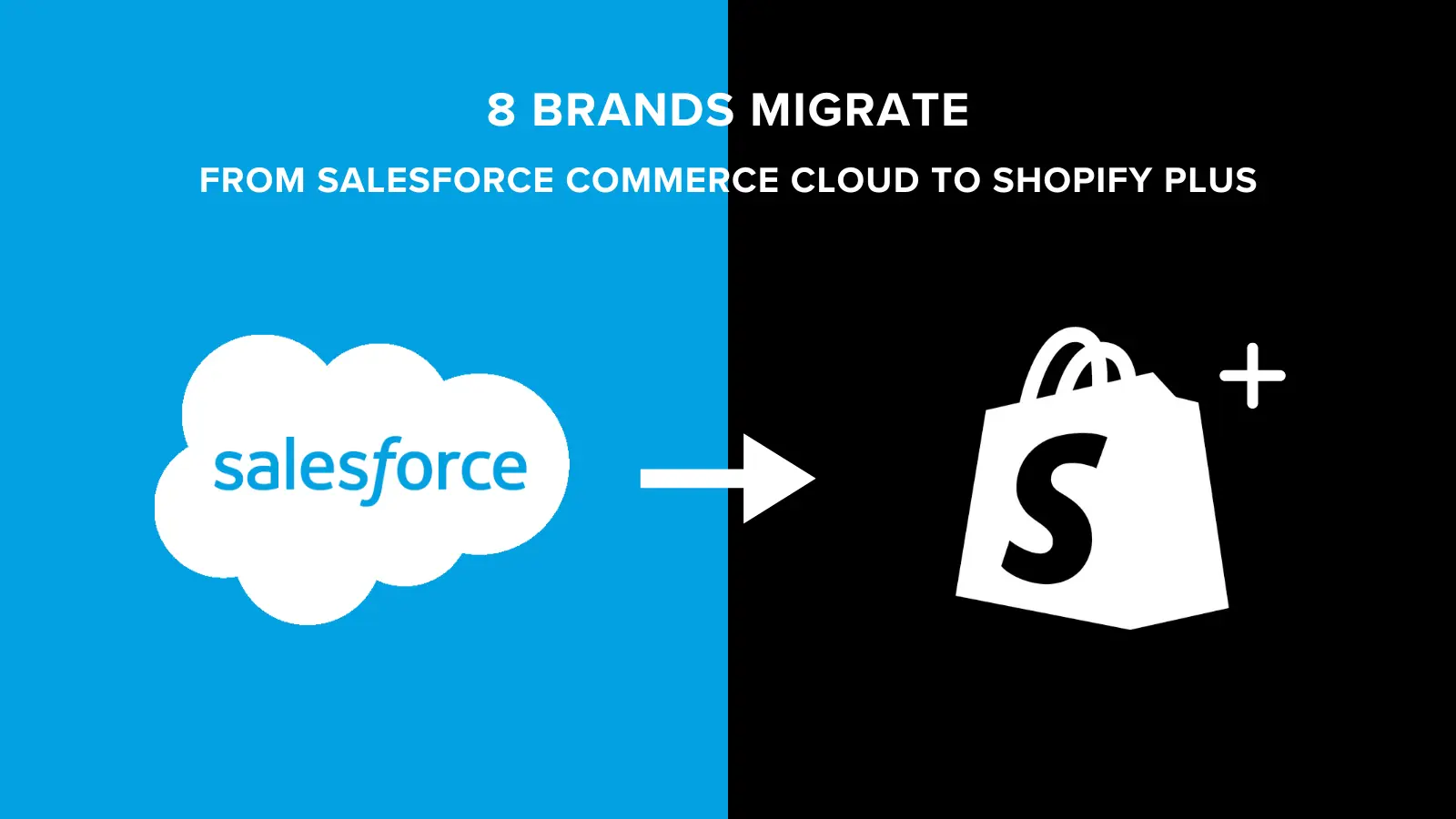
 2
2
 5,111
5,111
 0
0
 1
1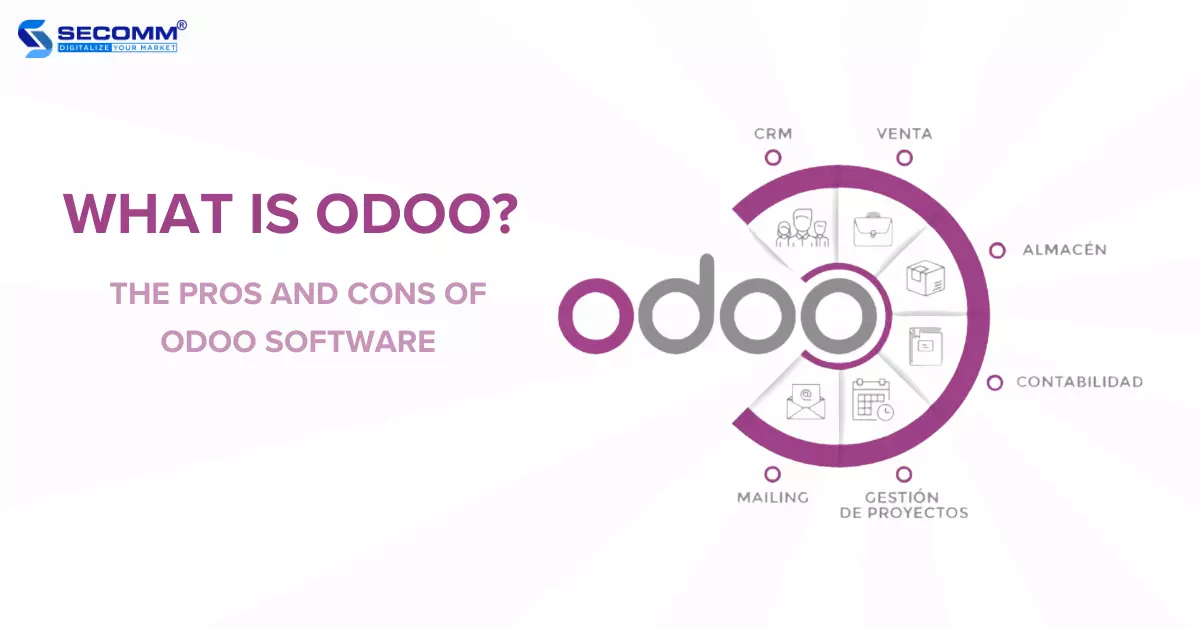
 2
2
 14,065
14,065
 0
0
 1
1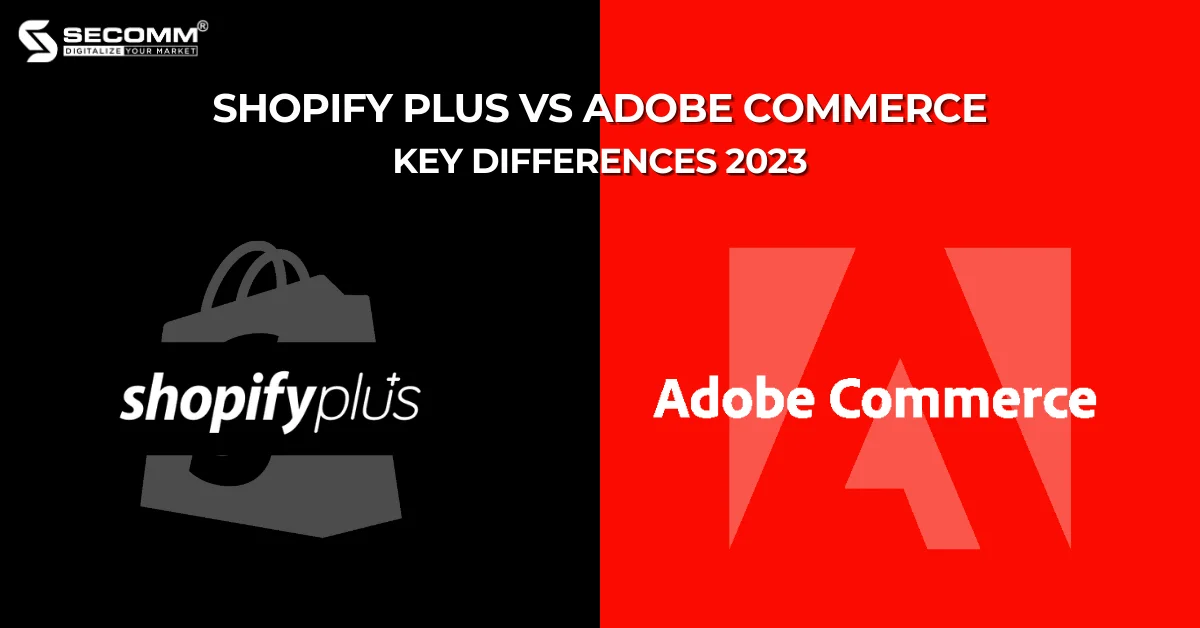
 2
2
 13,899
13,899
 0
0
 1
1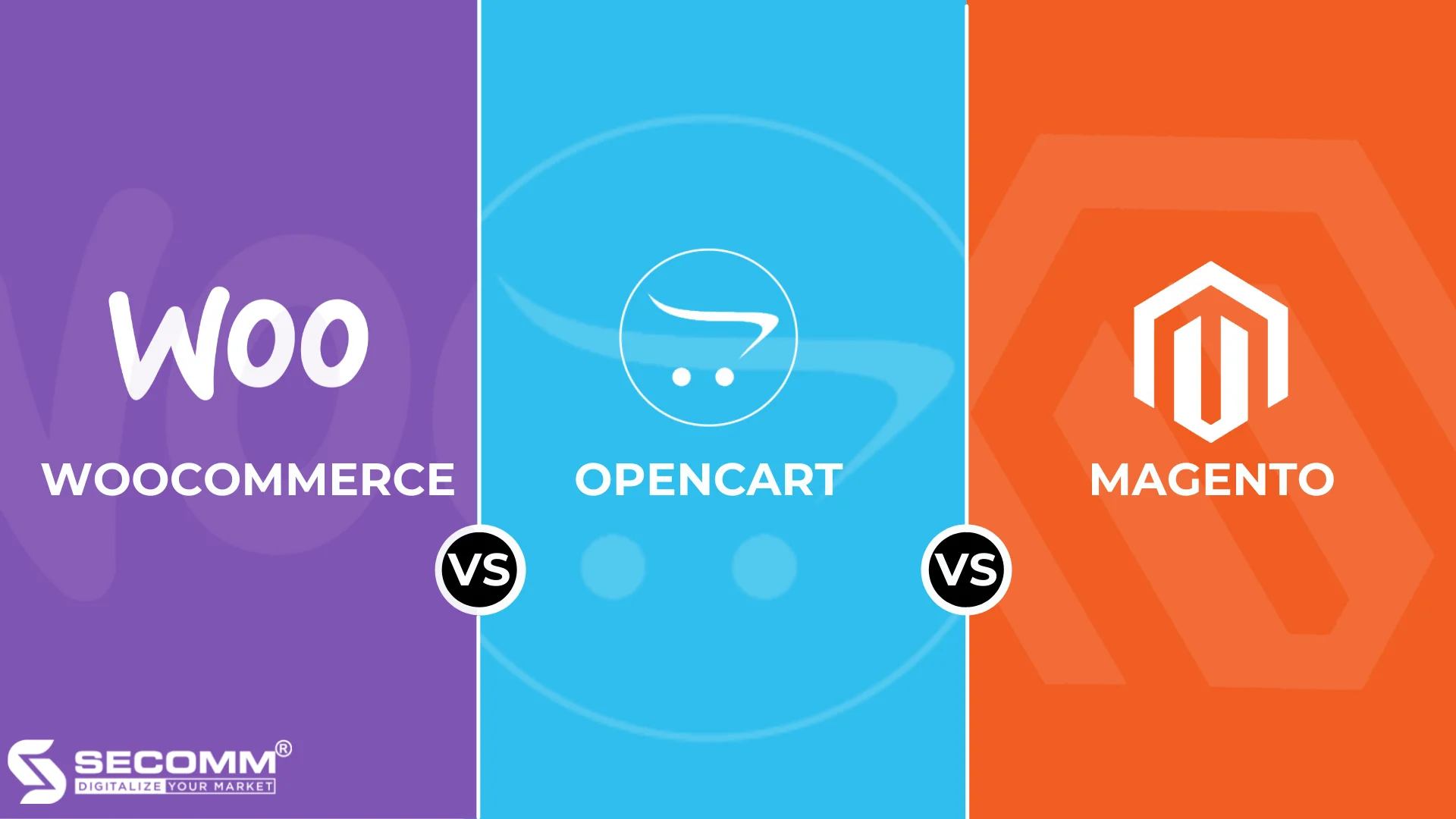
 2
2
 13,831
13,831
 0
0
 1
1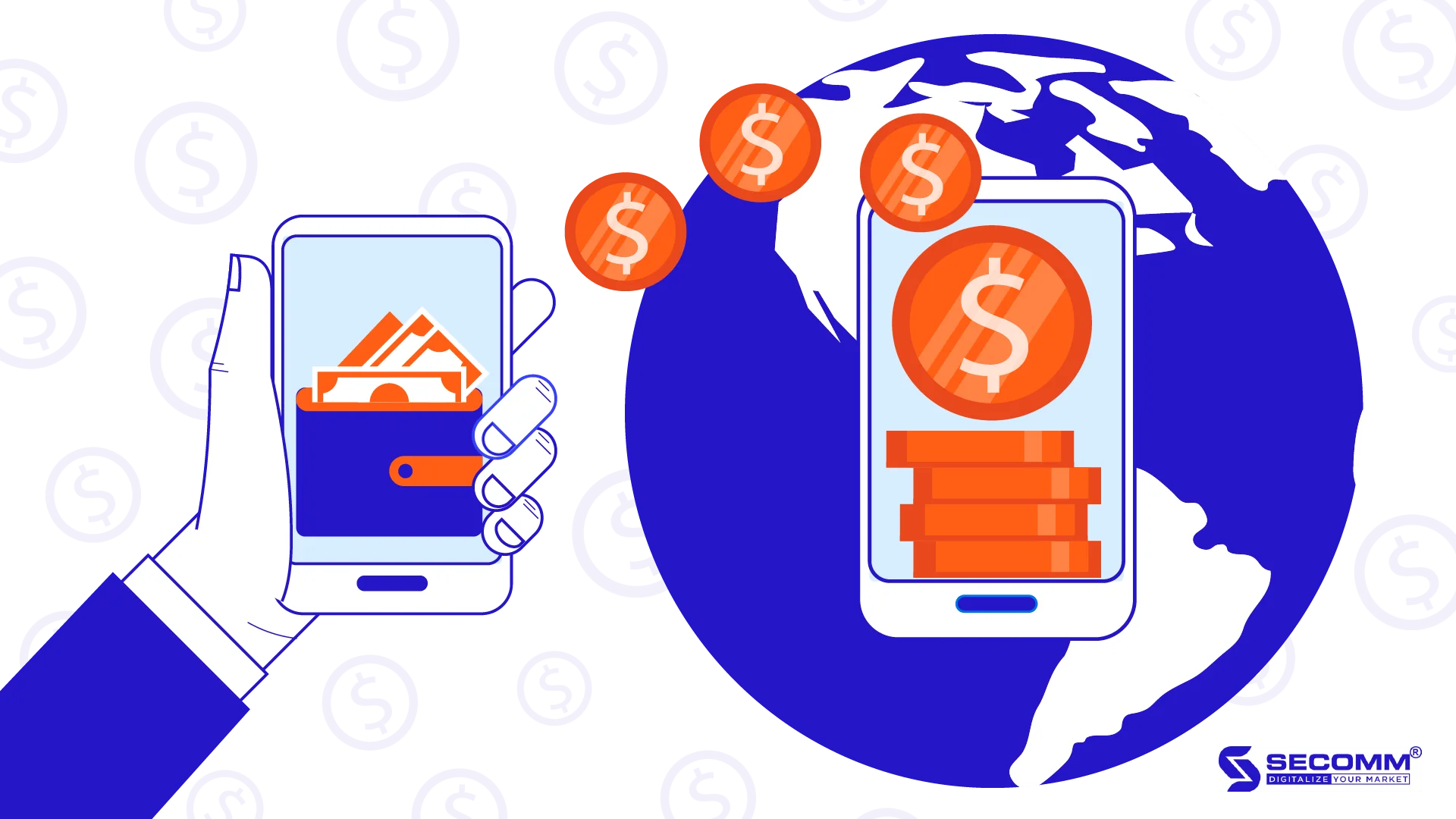
 2
2
 13,419
13,419
 0
0
 1
1



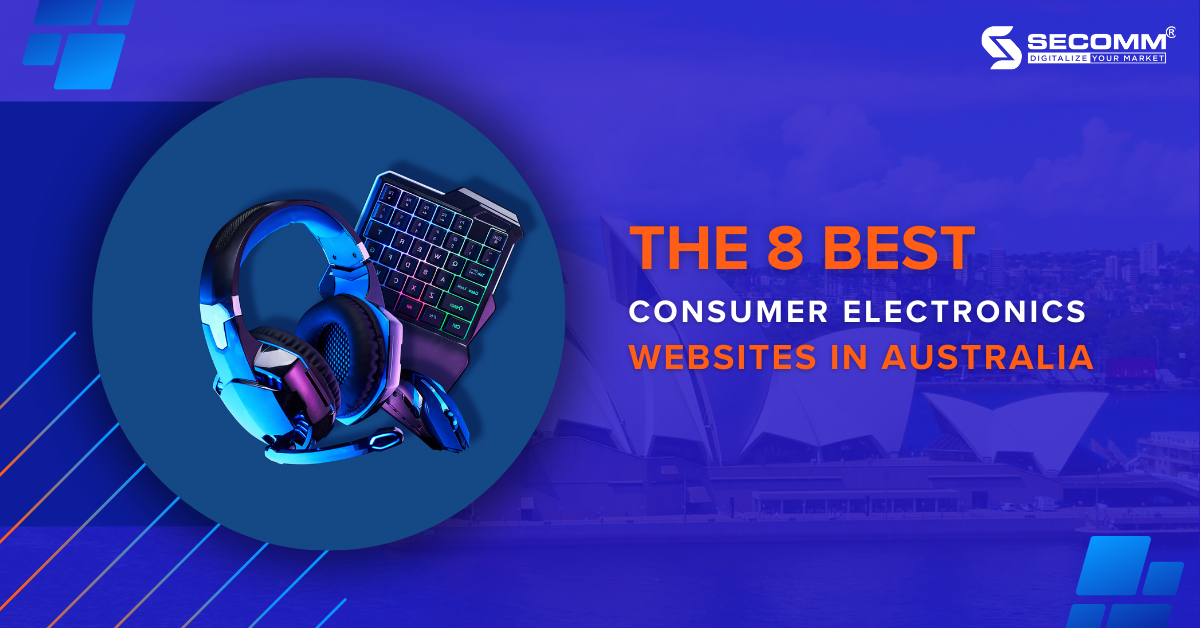
In recent years, the online consumer electronics industry in Australia has seen unprecedented growth. According to IBISWorld, the revenue for this sector reached $5.3 billion in 2023, with a compound annual growth rate (CAGR) of 15.7% over the past 5 years.
Let’s explore the websites of 8 consumer electronics brands that have significantly contributed to the industry’s development through optimized online shopping experiences tailored to the satisfaction of Australian customers.
When mentioning Samsung, people immediately think of cutting-edge smartphones and tablets. However, this tech giant doesn’t stop there. Other products like smart TVs and home appliances are also particularly favoured by global consumers.
In Australia, Samsung’s eCommerce website is the ideal online shopping destination for consumer electronics. With a modern, user-friendly interface and smooth navigation, the website provides customers with a seamless experience in every aspect of browsing, product exploration, and payment.
Additionally, the website features a dedicated section called #Explore, offering numerous shares and helpful tips to sync with modern life.
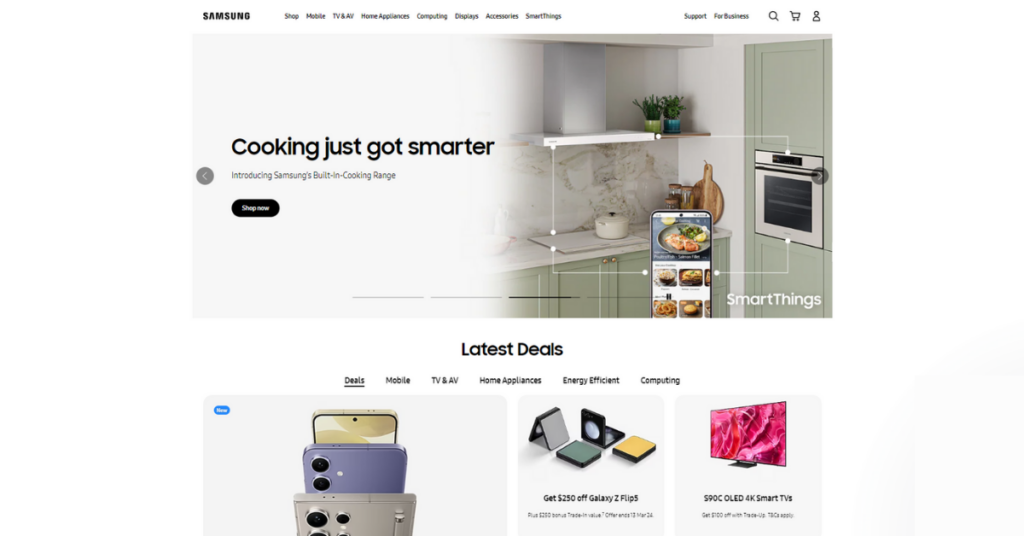
Apple’s website is also the preferred shopping destination for Australian consumers, alongside its nationwide chain of offline stores. With the perfect blend of elegant design and cutting-edge technology, this website is not just a place to explore and purchase high-quality Apple products but also an immersive experience in modernity and luxury.
Additionally, exclusive policies and top-notch customer service contribute to Apple maintaining a large base of loyal customers in Australia and worldwide.
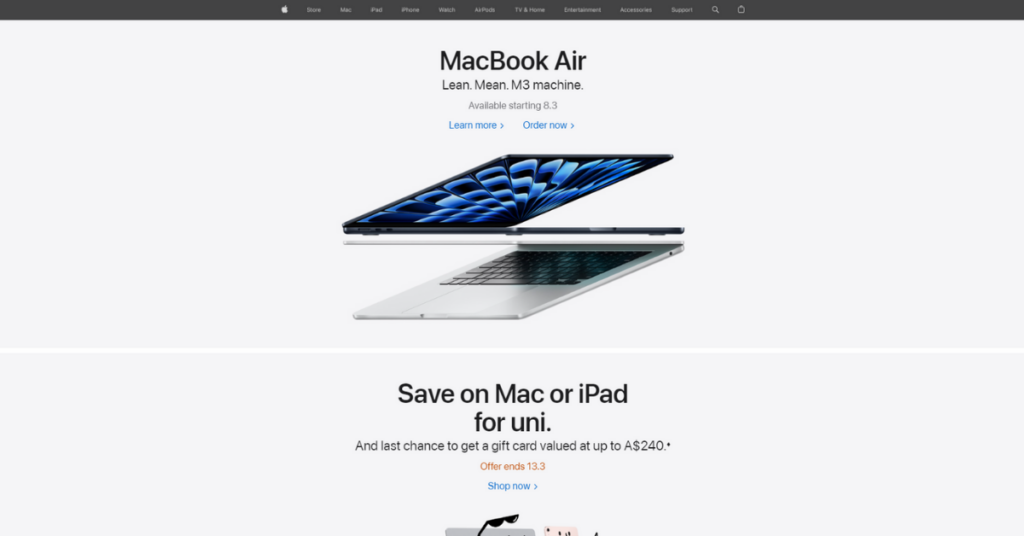
JB Hi-Fi is a consumer electronics brand in Australia that has gained worldwide recognition after more than 50 years of operation. In addition to investing in marketing and sales operations in its chain of offline stores across Australia, JB Hi-Fi’s eCommerce website is also given significant attention.
With a user-friendly and easy-to-navigate interface, JB Hi-Fi’s website enables consumers to easily search for and choose from thousands of products. Competitive pricing policies and excellent customer service are the factors that JB Hi-Fi consistently commits to, aiming to provide the best online shopping experience for Australian customers.
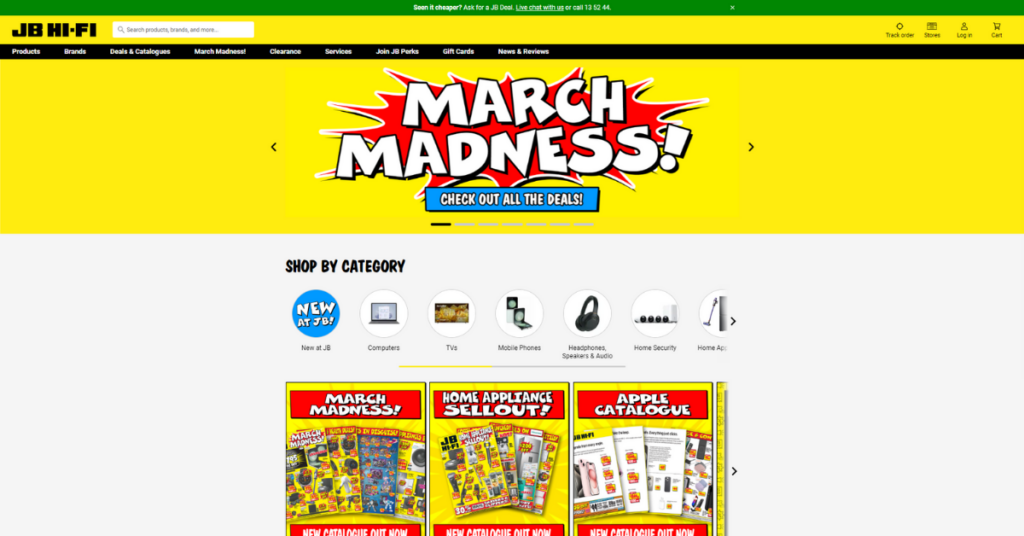
The Good Guys is a prominent and reputable name in the Australian consumer electronics market. Over the years, they have built up a vast product portfolio, including TVs, refrigerators, laptops, audio devices, and washing machines from leading global brands.
Attentive customer care services have also been a positive aspect that has earned The Good Guys favour among Australian consumers for many decades.
The Good Guys’ consumer electronics website allows customers to conveniently shop with a diverse range of choices. Additionally, attractive promotions and deals are regularly applied to attract customers. Furthermore, this retailer has implemented a Loyalty Program to satisfy their loyal customers.
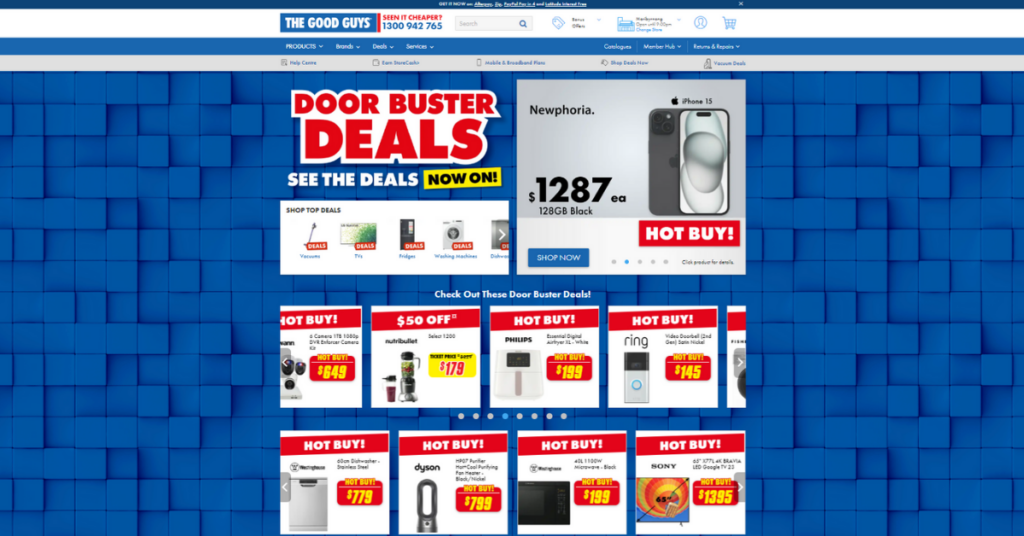
The Appliances Online consumer electronics website is considered a paradise where customers can find the most suitable items for their needs and budget. The intuitive website interface makes it easy for customers to search for and compare products, providing detailed information and user reviews to help them make informed purchasing decisions.
Appliances Online also offers various attractive customer services such as free shipping, product trade-ins and recycling, and 24/7 support via a hotline. The flexible payment methods are also an advantage of this retail site, allowing customers to choose between credit cards, electronic wallets, or instalment payments with a Buy Now Pay Later option.
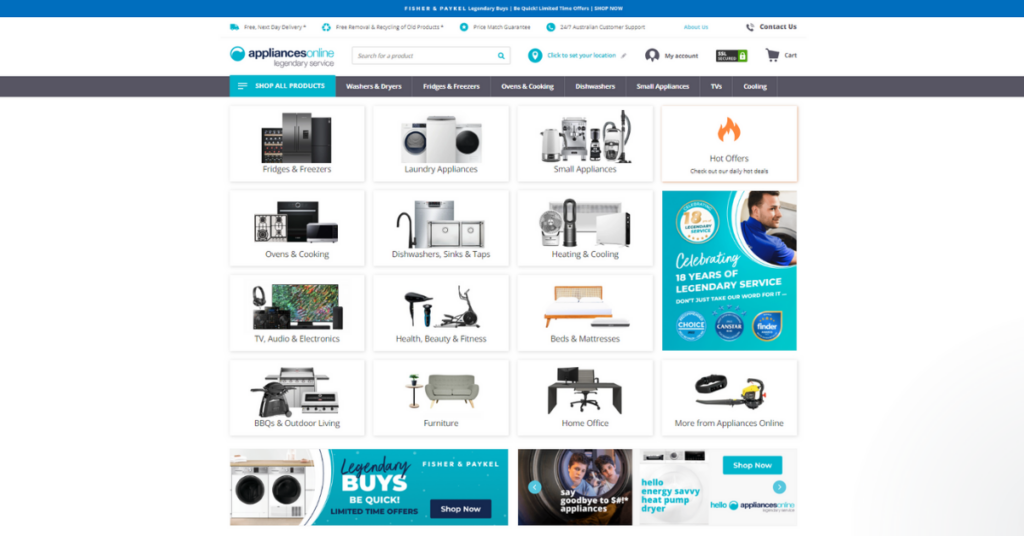
Since its launch in 1968, Dick Smith has firmly established its position in the Australian consumer electronics market. In its early years, Dick Smith focused on providing electronic products and components. It quickly expanded its product portfolio from electronics and home appliances to computers, mobile phones, cameras, tech toys, and other technology and entertainment-related items.
Dick Smith has invested in building an eCommerce website with advanced features on the Magento platform. The intuitive and user-friendly interface of the Dick Smith website makes it easy for Australian consumers to search for and compare products, as well as enjoy special offers and attractive discounts.
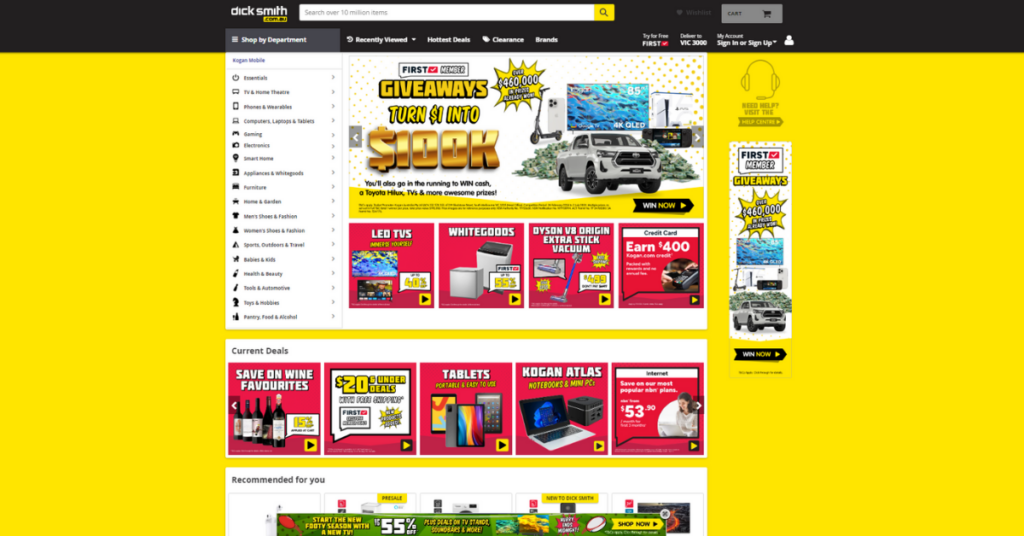
With a simple yet effective mission to provide a convenient and quality shopping experience, Jaycar Electronics has quickly become a reliable companion for Australian consumers. Jaycar Electronics offers a diverse range of products, including printers, USB ports, audio speakers, solar energy batteries, security cameras, and smart home products.
Jaycar Electronics’s eCommerce website is designed for easy navigation, allowing customers to quickly find and view products by category. The checkout process is also streamlined to shorten the payment process and reduce cart abandonment rates.
Additionally, customers have various shopping options, such as online purchases, in-store pickup, online purchases with free delivery, and buy now pay later. Jaycar Electronics has also introduced a Loyalty program to encourage customers to shop with exclusive benefits.
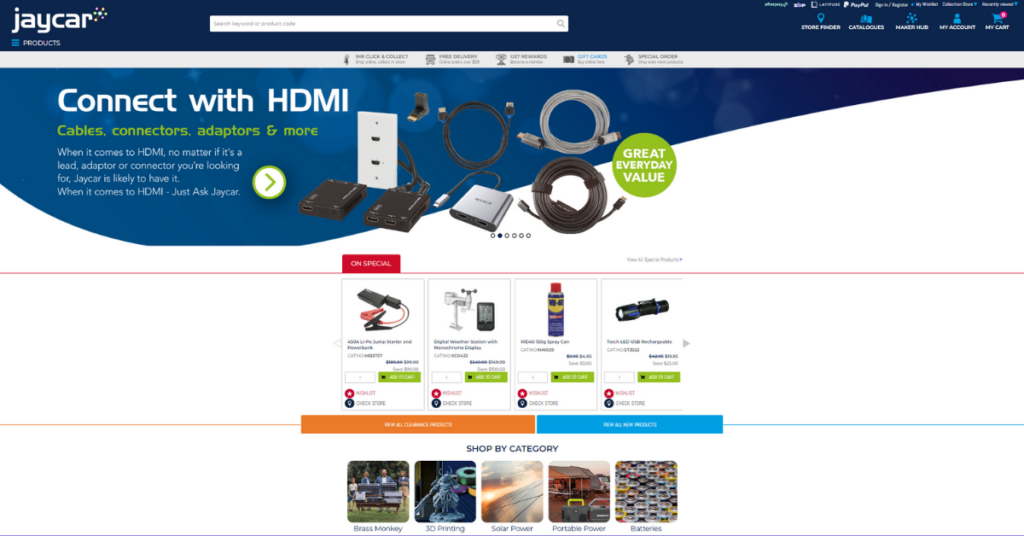
After many years of operation, Centre Com is recognized as one of the leading destinations where consumers can experience diversity and quality across a range of products. Centre Com’s consumer electronics website offers products such as PCs, laptops, CPUs, keyboards, cables, and audio speakers.
The website has been developed and customized with many advanced features to make searching, browsing, ordering, and payment easier.
When it comes to payment, the brand applies Buy Now Pay Later options with Afterpay and Zip, in addition to traditional payment methods, providing customers with more choices and flexibility without hesitation when making purchases.
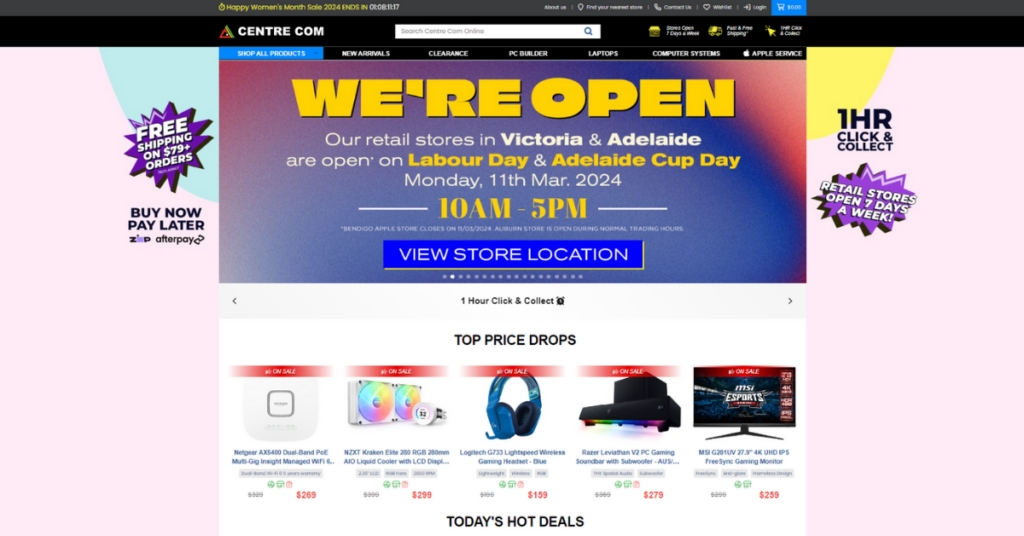
Build your first consumer electronics website today!
Here are the top 10 consumer electronics websites in Australia. By deploying superior platforms such as Magento, Shopify Plus, and SAP, these brands have provided an optimal online shopping experience and successfully captivated both local and international consumers.
Throughout years of development, SECOMM and many Australian clients have collaborated to create proud eCommerce websites. Projects with Laybyland, Jasnor, Rod Shop, and others stand out.
Contact SECOMM or call directly at hotline 028 7108 9908 to start today!
 2
2
 3,507
3,507
 1
1
 1
1
Cosmetics eCommerce in Australia has experienced significant growth and reached a total revenue milestone of 2.9 billion USD in 2023. The COVID-19 pandemic has accelerated the shift towards online shopping for beauty products in Australia.
Consumers are increasingly comfortable purchasing cosmetics online, with over 2,425 online businesses providing beauty products from various brands.
Let’s explore 8 of Australia’s most renowned cosmetic retail brands and how they solidify their positions through custom-developed eCommerce websites designed to enhance the overall customer experience.
Priceline is not only a leading destination for cosmetics shopping but also a reliable address for those seeking professional skincare advice. This brand has secured a significant position in the Australian cosmetics market, known for organizing informative events and courses to provide customers with beauty knowledge and help them choose the right products for their skin.
Priceline’s eCommerce website, with its user-friendly interface, easy navigation, and smart search features, enables customers to find and purchase products effortlessly. Additionally, the loyalty programs and promotions are chosen by Priceline to satisfy current customers and attract more potential customers.
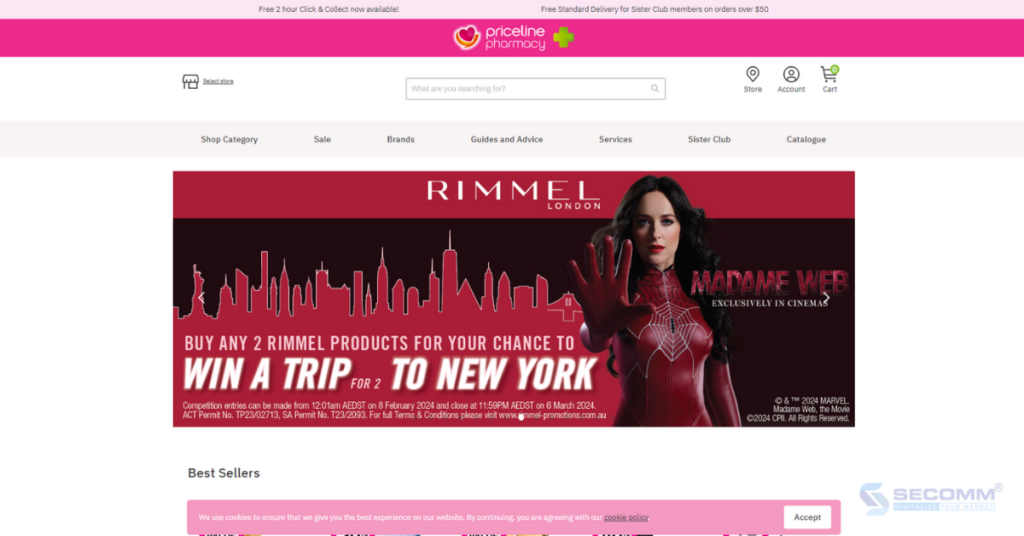
Popular across Australia, Adore Beauty offers a diverse range of quality products from many leading cosmetic brands, providing customers with a comprehensive and unique online shopping experience. Adore Beauty invests in the customer experience on both its eCommerce website and customized mobile app to cater to various operating systems and screen sizes.
Adore Beauty also stands out by providing special features like “Adore Beauty IQ,” an intelligent personal advisory tool based on user skin information and personal preferences. This helps customers choose products that meet their skincare and beauty needs.
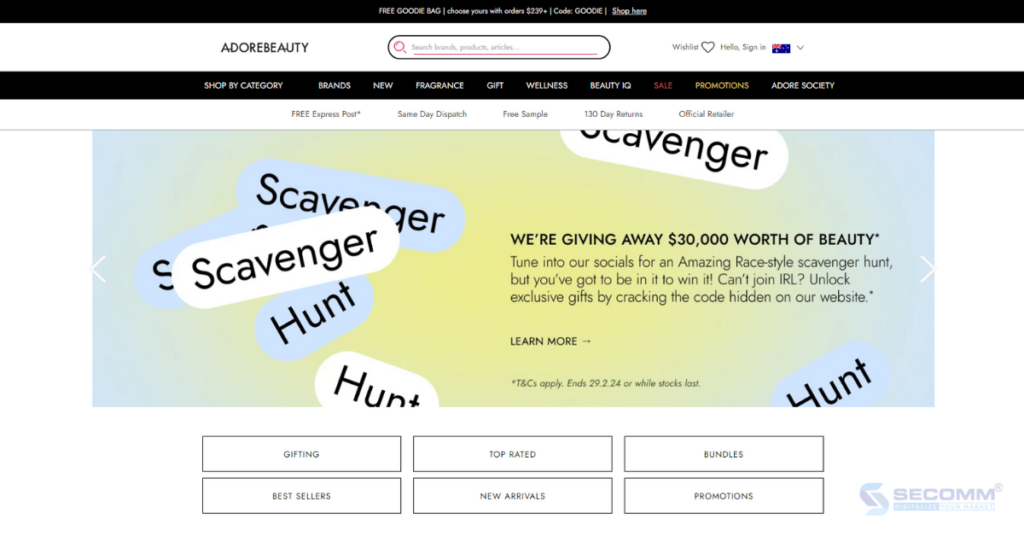
The world’s leading cosmetics retailer, Sephora, has established a strong presence in the Australian market. With a diversity of brands and personal care products, Sephora is not just a cosmetics shopping destination but also a place to experience the latest beauty trends.
A unique feature on Sephora’s website is the “Virtual Artist,” a virtual reality technology that allows users to try cosmetics online on their faces through a webcam or personal photo. This helps customers better understand how the products will look on their skin before making a purchase.
Sephora’s loyalty program, called Sephora Beauty Pass, offers many attractive benefits for its members. Members have the opportunity to get new products before the launch date, earn points with each purchase, and gain access to exclusive events. The point system also allows users to accumulate points and exchange them for special discounts and free products.
Thanks to this loyalty program, Sephora has built a strong community of beauty enthusiasts and encourages customer loyalty.
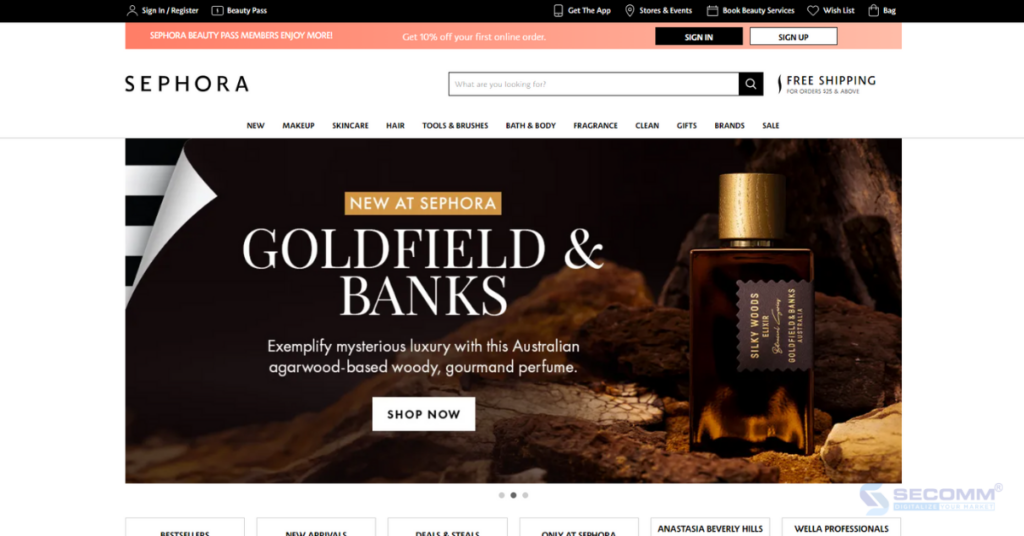
Lila Beauty has gained the trust of consumers and maintained its position in the Australian beauty industry through a diverse product portfolio that includes cosmetics, skincare, hair care, and beauty tools from prominent brands in South Korea and Japan.
In addition to unique features integrated into the eCommerce website, Lila Beauty offers attractive deals and promotions, notably the E-gift card. Lila Beauty’s E-gift cards are not just an excellent way to gift loved ones and friends but also provide a flexible shopping experience for the recipients.
Customers can easily choose the gift card value and send it via email, creating a convenient way to share the joy of beauty.
Another distinctive aspect of the brand is the Lila Beauty Wholesales (B2B) program, offering excellent collaboration opportunities for businesses and beauty professionals. This program provides high-quality wholesale solutions with discounted prices targeting retailers, spas, and other business partners.
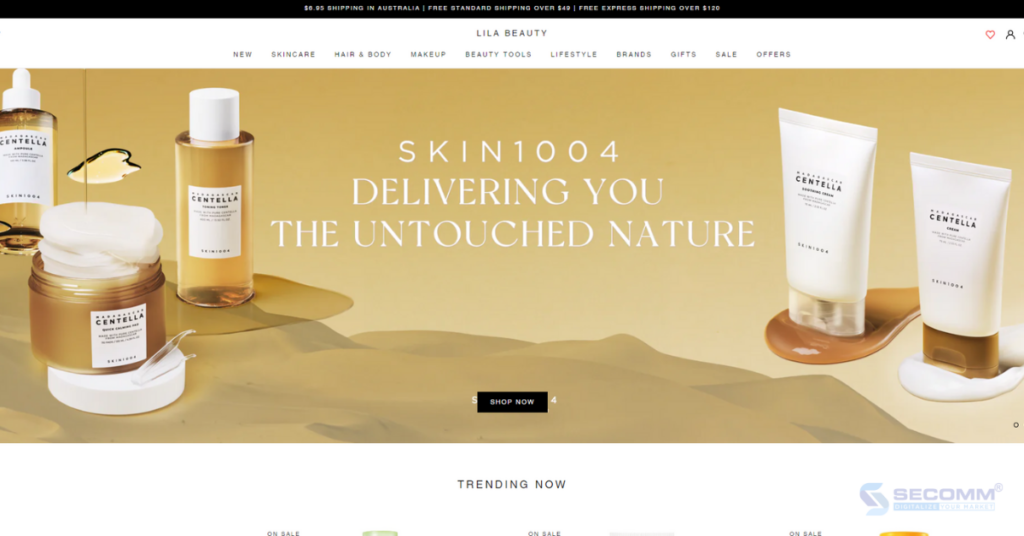
The W Cosmetics chain of beauty stores is a prominent name in the Australian market and has rapidly expanded to a total of 21 stores. This brand appeals to various customer segments by offering a diverse range of beauty and personal care products from major Japanese and Korean brands.
W Cosmetics’ eCommerce website for cosmetics is a frequently visited destination for Australian consumers, thanks to its optimized shopping experience and excellent customer service. The Store Locator feature is a unique point that helps customers easily identify and locate the nearest stores or retail outlets.
Additionally, customers can seek remote assistance or advice through email, live chat, and the We Chat messaging app.
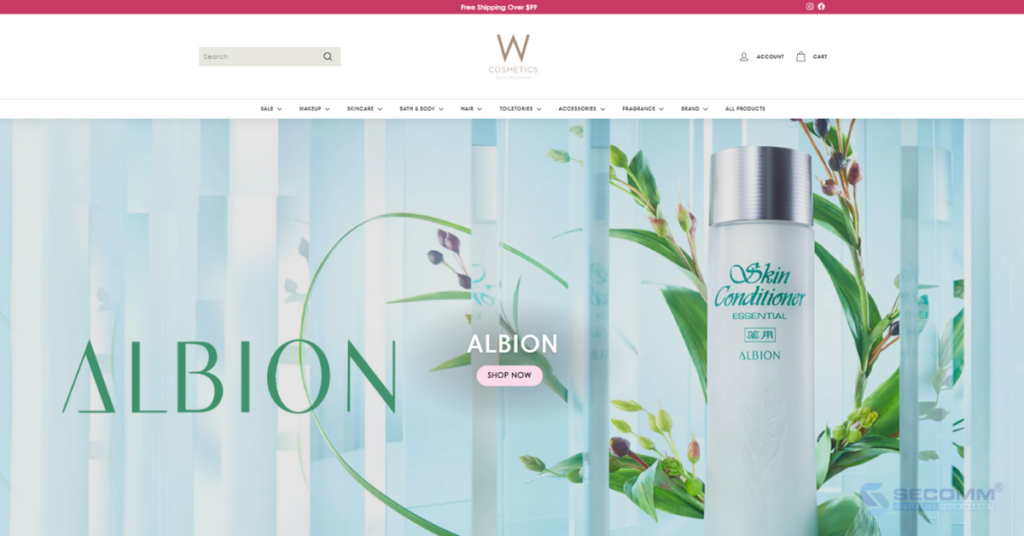
After more than 12 years in the market, Oz Hair and Beauty has become a go-to destination for beauty enthusiasts across Australia. Oz Hair and Beauty focuses on providing hair care and beauty products for both men and women.
The eCommerce website is not only a place to shop for beauty products online but also a hub for staying updated on the latest beauty knowledge and trends. Additionally, this retail brand has implemented a loyalty program in the form of a tiered system called Oz World, allowing customers to accumulate points and receive exclusive benefits when participating.
The Virtual Beauty Consultation service from Oz Hair and Beauty is a crucial part of delivering a personalized shopping experience for customers. Customers can seek professional advice on hair care and beauty through online consultations, helping them choose products tailored to their specific needs.
This reflects Oz Hair and Beauty’s commitment to meeting and exceeding customer expectations in the beauty and hair care industry.
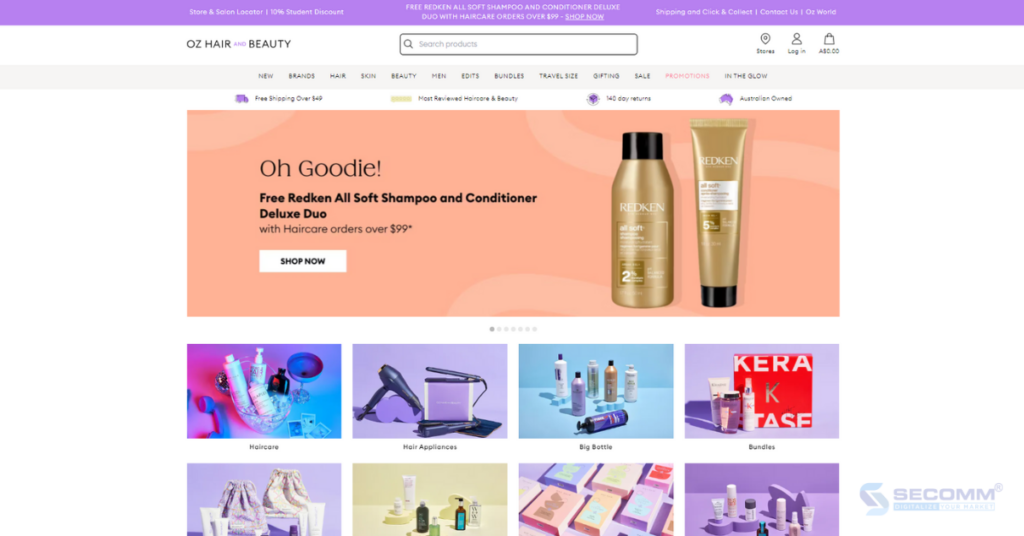
The retailer Nudie Glow specializes in providing beauty products from local Australian, Japanese, and Korean brands. Gaining consumer trust through excellent service and quality products, Nudie Glow has gradually established a strong position in the Australian beauty and cosmetics market.
Nudie Glow’s eCommerce website is intelligently designed and user-friendly. The website not only provides a convenient online shopping experience but also serves as a reliable source of information on new trends, beauty tips, and success stories from the beauty community.
Nudie Glow’s wholesale program is an excellent opportunity for business partners, to offer high-quality wholesale solutions at discounted prices, facilitate brand expansion, and create long-term collaboration opportunities.
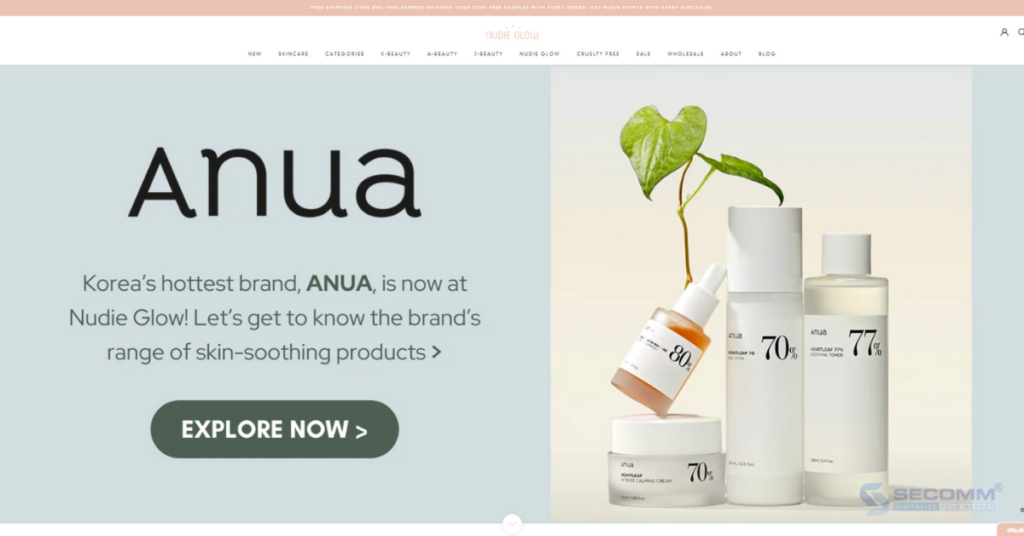
Mecca’s cosmetic, hair care, and personal care products are not only designed for female customers but are also the top choice for gentlemen. The brand has created an exclusive product line named MECCA COSMETICA and MECCA MAX.
Additionally, for professional medical-standard skincare advice and treatment, customers can avail themselves of the MECCA Aesthetica service with transparent and clear pricing.
MECCA also implements a customer membership program, allowing members to earn points with their purchases for gift redemptions and exclusive discounts on special occasions.
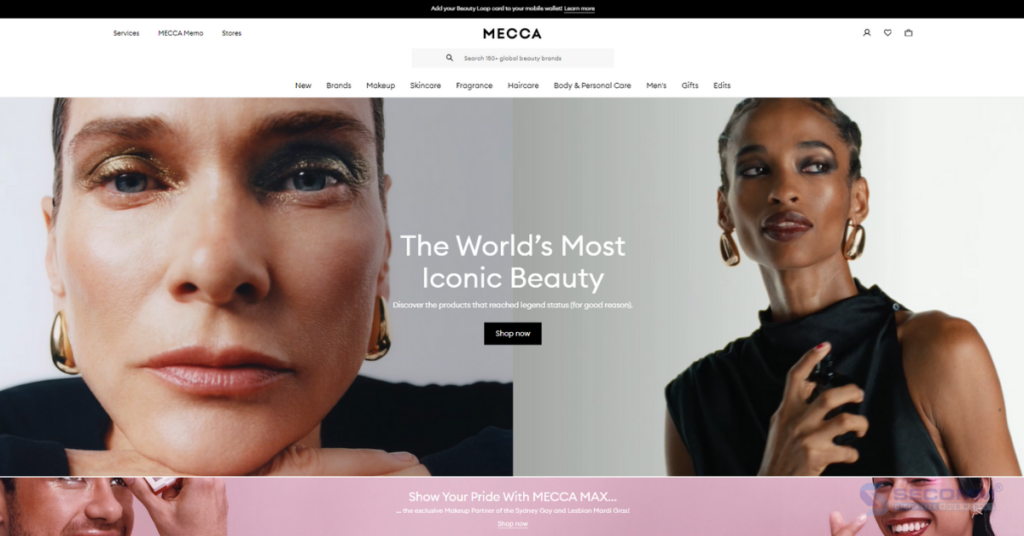
Above are the top 8 favorite cosmetics eCommerce websites in Australia, each providing unique and diverse shopping experiences.
For many years, SECOMM has stood out with its extensive experience collaborating with numerous Australian businesses to create custom eCommerce websites that cater well to the specific needs of each industry.
If you’re looking for a reliable partner to develop and optimize its eCommerce website, contact SECOMM today at (+84)28 7108 9908!
 5
5
 3,358
3,358
 0
0
 1
1
The wine eCommerce industry in Australia is rapidly growing and has the potential for further expansion in the future. According to IBISWorld, the revenue for this sector is projected to surpass $374 billion by 2023, with an annual growth rate of 10.51%.
Let’s explore the websites of the 8 most beloved liquor brands in Australia that have contributed to driving the growth of wine eCommerce in this market.
Dan Murphy’s is a retail brand specializing in the sale of top-quality wines and alcoholic beverages in Australia. With a history of over 60 years in operation, Dan Murphy’s has built a strong reputation within the Australian consumer community.
Through its chain of traditional stores and eCommerce website, Dan Murphy’s enables customers to shop with a wide range of options and convenience.
The eCommerce website of Dan Murphy’s is where customers can experience easy and flexible online shopping. With a user-friendly interface, the website provides detailed product information, consumer reviews, and attractive promotional programs.
Customers can enjoy a comfortable and secure shopping experience with assurance regarding the quality and origin of products from this reputable brand.
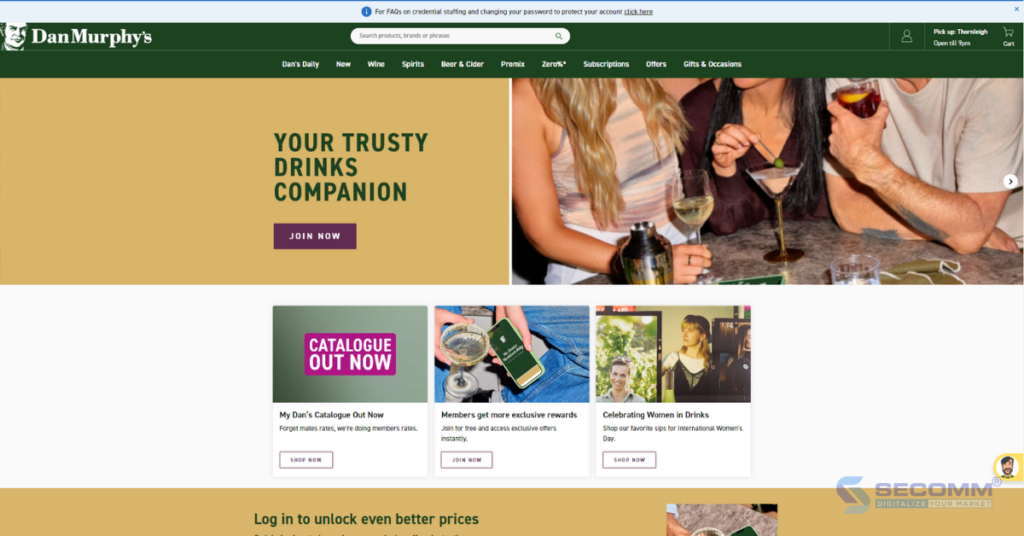
BWS is known as a leading alcohol retail brand in Australia. The brand is renowned for its diverse product portfolio, including wines, domestic and international beers, as well as various spirits from around the world.
BWS’s wine eCommerce website provides a convenient and flexible online shopping experience. In addition to offering detailed product information and prices, the website incorporates various special features. These include exclusive promotional programs, consumer reviews, advanced search options, and one-page checkout.
In addition to the eCommerce website, BWS has developed a mobile app, allowing customers to shop conveniently anytime, anywhere.
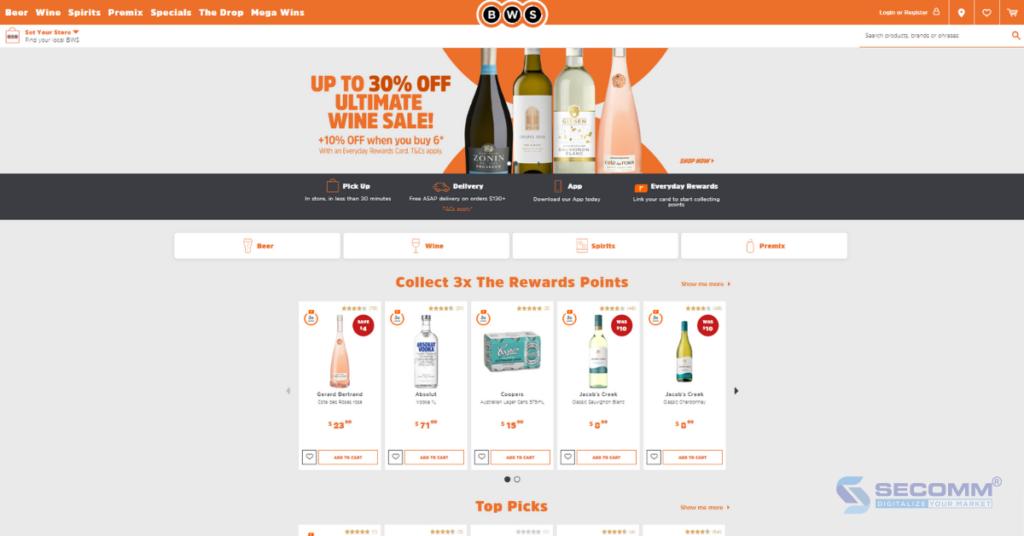
Liquorland is one of the prominent names in the alcohol retail market in Australia. With over 700 stores spread across the country, Liquorland has established a strong presence in the market and has become a favorite destination for those who appreciate fine wines and exceptional beverages.
Liquorland not only focuses on providing quality products but also emphasizes a comfortable and friendly shopping experience through its eCommerce website. The website is built with various unique features such as product filtering and search, displaying products by category, showcasing customer reviews, options for delivery and in-store pickup, and one-page checkout.
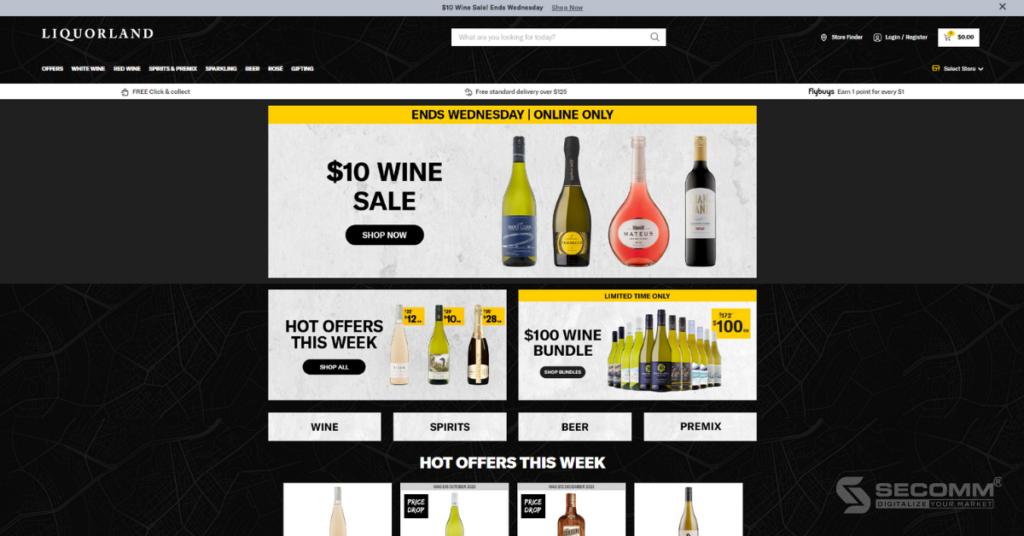
The liquor and alcohol retail chain First Choice Liquor owns over 100 stores throughout Australia and is the choice of many consumers in the country. This retail brand offers a diverse range of products such as wines, spirits, beers, and various alcoholic beverages worldwide.
On the First Choice Liquor eCommerce website, customers can easily search, browse, and purchase products through a user-friendly and navigable interface. Several unique features are also integrated into the website to optimize the customer experience.
These include store locator functionality, choosing the nearest store, product filtering, and search, displaying detailed product information, one-page checkout, delivery and pickup options, and more.

Vinomofo is a renowned wine brand from Australia with a simple yet powerful slogan, “Make wine fun.” This brand has created a passionate community around wine, where people can share and enjoy the collective enthusiasm for wine culture.
Vinomofo’s eCommerce website is built with advanced features such as product filtering and search, product previews, displaying detailed product information, showing related products, and one-page checkout. In addition, Vinomofo provides customers with a shopping policy that includes various payment methods and flexible return and exchange policies.
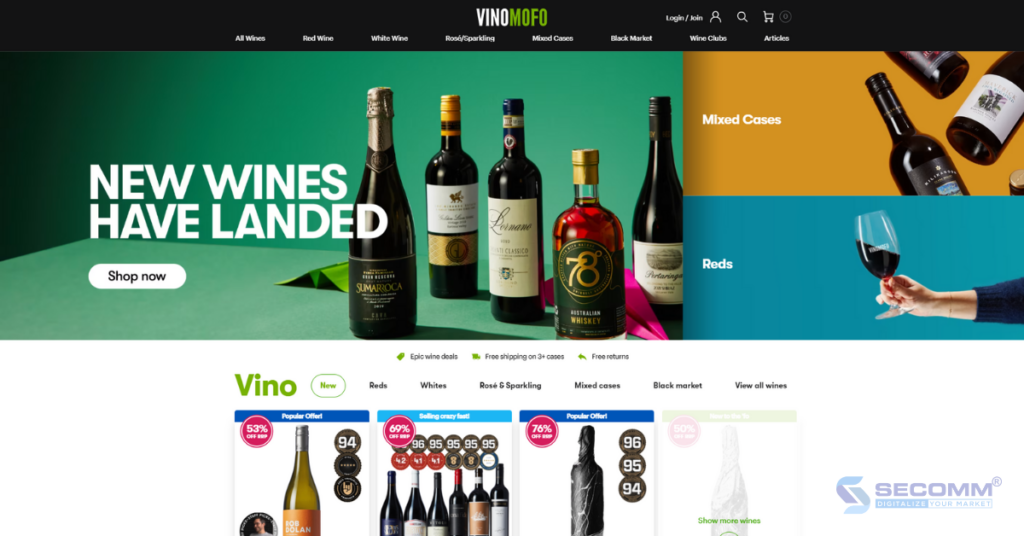
Wine Direct is known for its diverse product portfolio, ranging from classic wine bottles to the most modern and popular options in the market. The brand also stands out for its excellent customer service, providing detailed product information and post-purchase care to ensure maximum customer satisfaction.
Wine Direct’s website is designed to be modern and user-friendly, offering an easy and comfortable online shopping experience. The website not only provides comprehensive information about each wine bottle but also integrates features such as consumer reviews and special promotional programs.
With a strong presence in the Australian market, Wine Direct continues to be a trusted destination for those who love and appreciate the art of wine tasting.
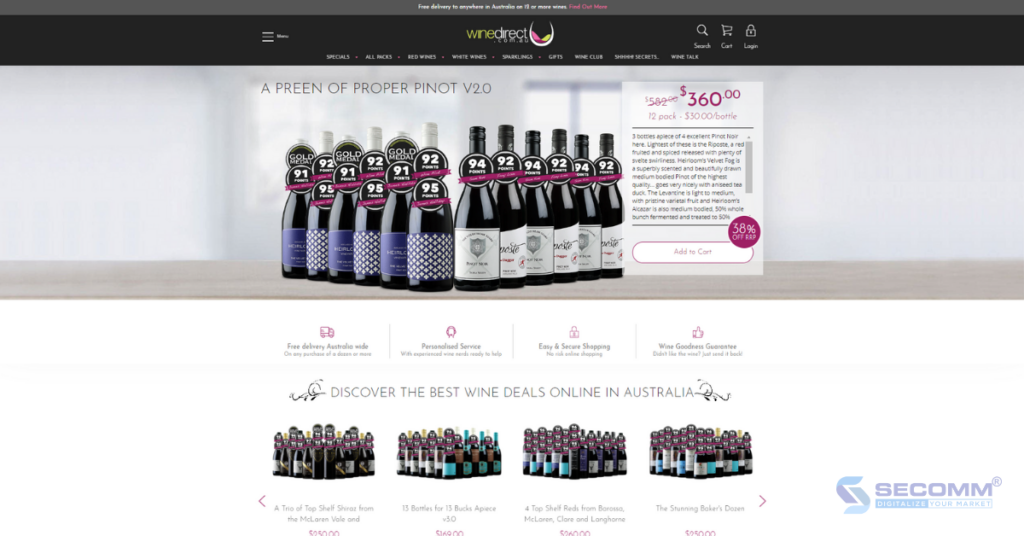
With over a decade of experience, Just Wines has built a strong reputation for providing diversity and high quality to Australian consumers. What sets Just Wines apart is its focus on establishing direct connections with wine producers and top vineyards, ensuring a reliable supply of quality wines and diversity in the product catalog.
The brand takes pride in offering customers a wide selection, ranging from traditional wines to new and unique discoveries in the market.
Just Wines’ eCommerce website is designed to be simple and user-friendly, enabling consumers to easily search, compare, and conveniently purchase wines. Additionally, Just Wines implements a customer loyalty program with various exclusive deals and attractive promotions, creating favorable conditions for customers to enjoy wines at the best value.
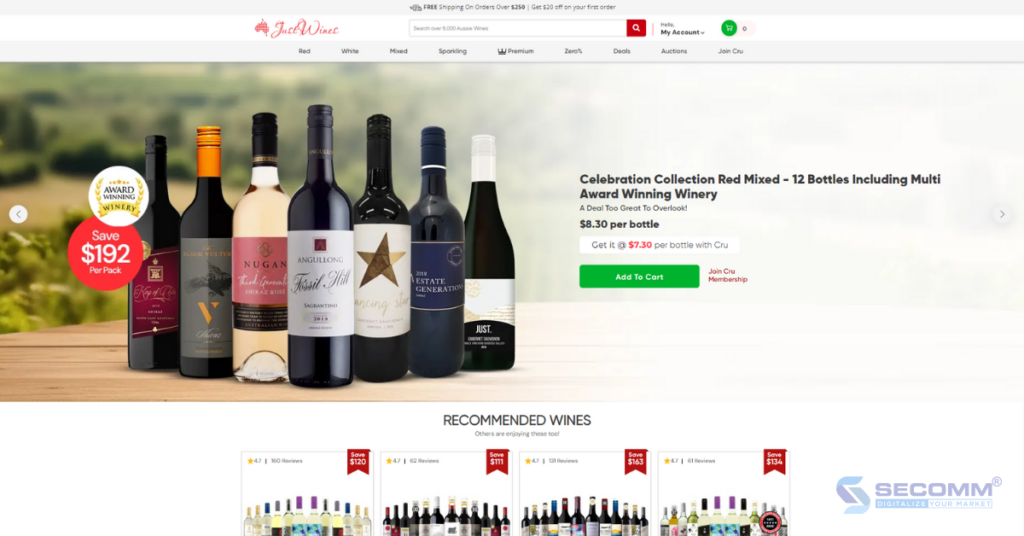
Trentham Estate is a renowned wine brand with a strong presence in the Australian market. With over three decades of history, Trentham Estate has played a significant role in the development and shaping of the Australian wine industry.
The brand is well-known for producing high-quality wines from renowned grape varieties cultivated in carefully tended vineyards. Trentham Estate is not just a winemaking facility but also a smart vineyard, overseeing the process from grapevines to wine barrels.
Trentham Estate’s eCommerce website is built with Magento, allowing customization of how product information is displayed, implementation of promotional programs, optimization of the payment process, and integration of various payment methods. This contributes to providing customers with a comprehensive and flexible online shopping experience.
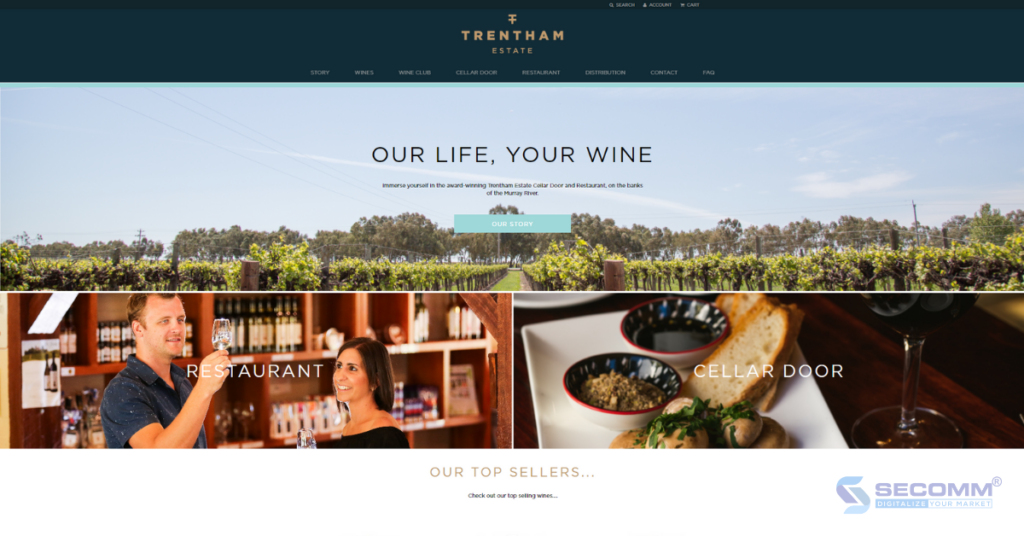
Above are 8 famous wine brands in Australia and how they have built and developed their eCommerce websites. This is clear evidence of the importance of having a professional and convenient online platform in the 21st century.
With extensive experience collaborating with various Australian clients, SECOMM has established itself as a trustworthy partner in constructing and evolving eCommerce initiatives. Notably, the SECOMM team has successfully implemented eCommerce systems for numerous wine businesses across different countries, including Trentham Estate, Thewarehouse, Ishopchangi, and more.
We comprehend the distinct requirements of businesses in the alcohol and beverage sector and are dedicated to delivering optimal solutions that enhance the online shopping experience and boost overall business efficiency.
If your business is in search of a professional partner to develop or enhance its eCommerce website, reach out to SECOMM or call (+84)28 7108 9908 today.
 2
2
 2,159
2,159
 0
0
 1
1
Fashion eCommerce has been booming worldwide for many years, and Australia is no exception. According to IBISWorld, the online revenue for women’s fashion alone in the Kangaroo country reached over $1.8 billion in 2023, marking a 1.1% increase compared to the same period in 2022.
Let’s explore the top 10 most prominent fashion eCommerce websites in Australia.
For a considerable period, The ICONIC eCommerce website has been recognized as a premier shopping hub for fashion enthusiasts in Australia and New Zealand. On this platform, shoppers can conveniently discover various products from well-known global brands like Levi’s, Adidas, Lacoste, Polo Ralph Lauren, and others.
The ICONIC website is designed to make it easy for customers to navigate products, make purchases, and track their orders. Beyond delivering a distinctive online shopping experience, The ICONIC also regularly updates fashion trends and provides valuable information for its customers.
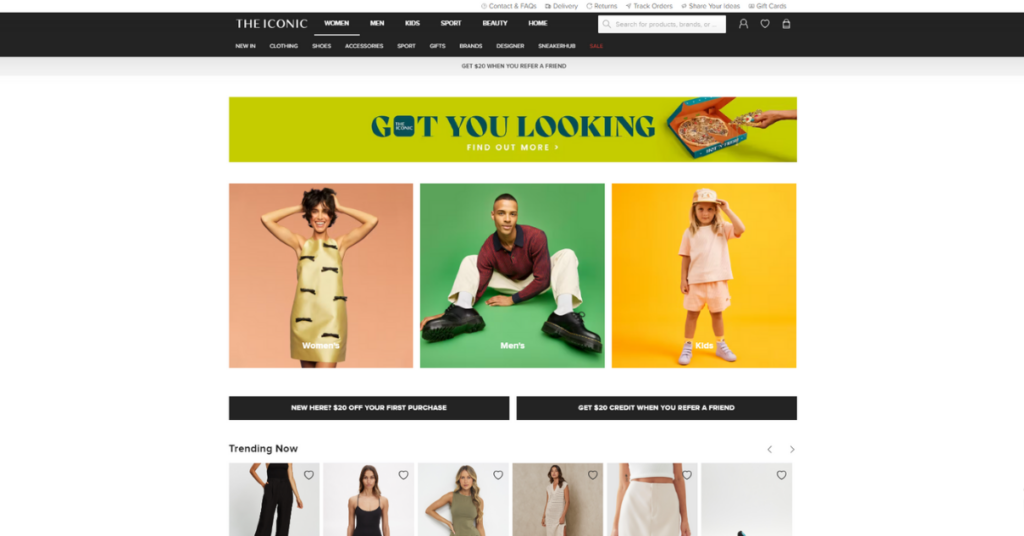
Established in 1991 in Australia, Cotton On offers a diverse range of fashion products for men, women, and children, including footwear, accessories, lingerie, and even home furnishings and interior decor in some stores. Cotton On has a widespread network of physical stores across the globe, including the UK, the US, and Canada.
Therefore, the brand has invested in an eCommerce website system to cater to various customer demographics in different markets. Additionally, Cotton On implements a customer loyalty program and various enticing promotional campaigns to attract and retain customers.

Established in 2006 in Australia, Forever New focuses on designing and producing women’s fashion collections, offering customers products with a luxurious and feminine style. Since then, the brand has rapidly grown and expanded into various markets.
The Forever New eCommerce website is built using Magento and customized with many advanced features to optimize the online shopping experience for customers. Similar to many other popular fashion retailers, Forever New implements various promotional programs and enticing offers to delight its customers.

Bonds is a renowned fashion brand in the Australia and New Zealand region, offering a wide range of products for men, women, and children in diverse styles and sizes. The Bonds eCommerce website not only showcases the brand’s sophistication through a visually appealing user interface but also provides intelligent search features, secure payment processes, and detailed product information.
This approach helps Bonds retain its existing customer base while also capturing the interest of newcomers looking to experience the brand’s comfort and distinctive style.
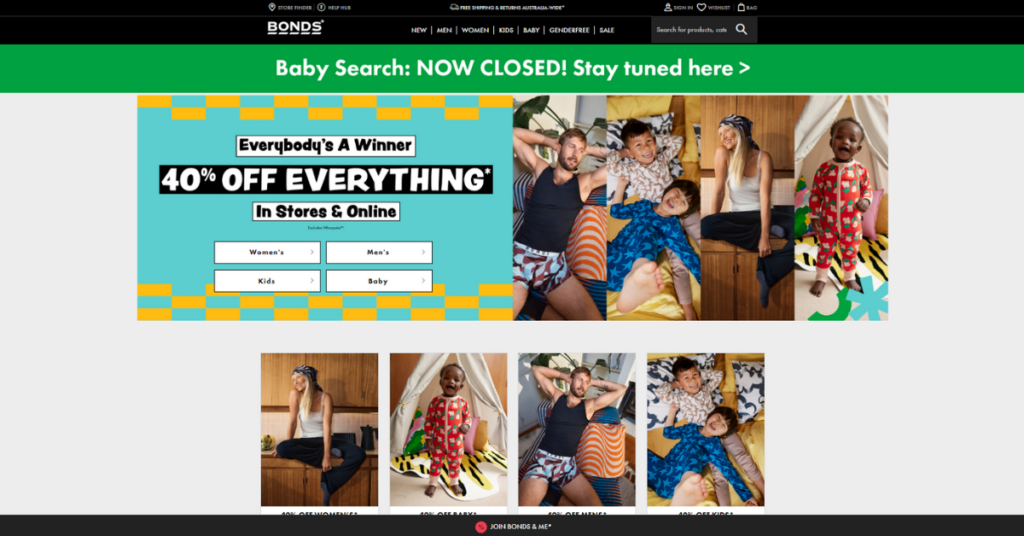
Present in the Australian market for over 80 years, Sussan has won the hearts of consumers through a blend of modern style and comfort. Today, Sussan stands as an icon in the country’s fashion industry with unique outfits that emphasize the creativity and confidence of women.
Sussan’s fashion eCommerce website is customized and optimized on the Magento platform, providing customers with a unique shopping experience. The website simplifies the checkout process and integrates multiple third-party payment methods to increase choices for customers while streamlining the shopping process and reducing cart abandonment rates.
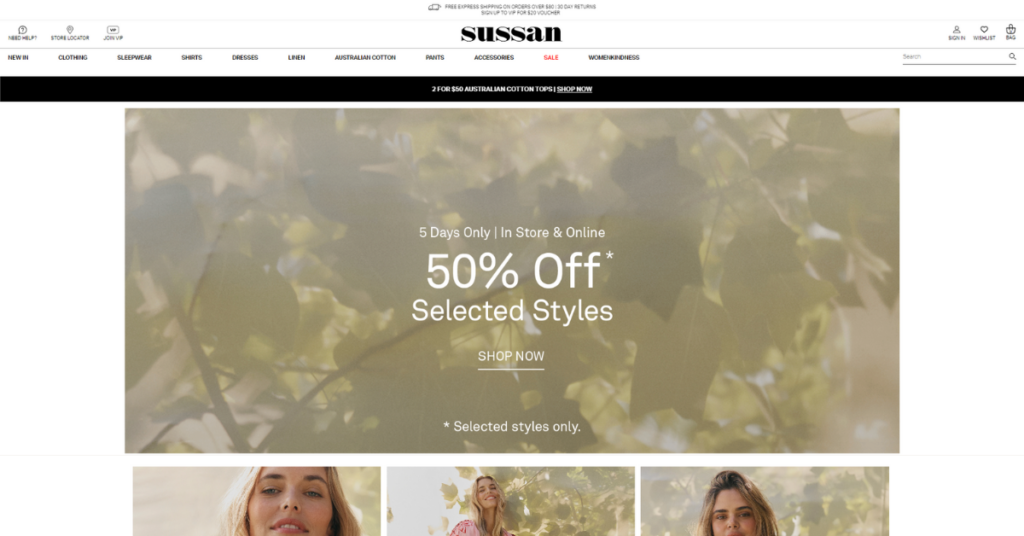
Kathmandu is known as a giant in the field of clothing and equipment for outdoor activities and adventure sports. This brand has played a significant role in making the outdoor life of Australians more exciting and comfortable.
The Kathmandu eCommerce website is developed using Magento, providing customers with a rich and easily customizable experience that can be expanded based on the business’s needs. Some notable features of the Kathmandu website include options for product sizes and colors, product comparisons, finding the nearest store, one-page checkout, and more.
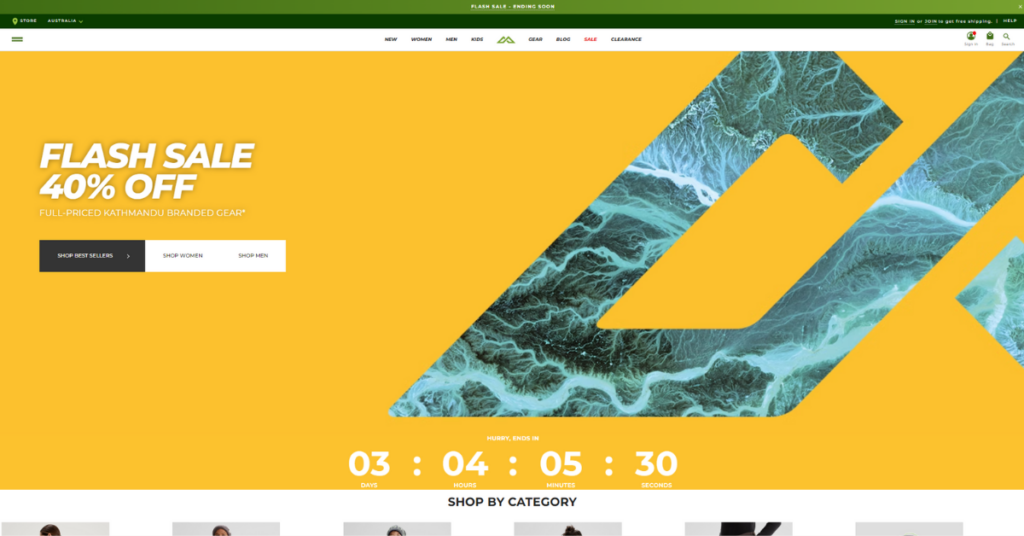
Established in 1990, Glue Store is a longstanding fashion chain in Australia. The brand specializes in offering products from top global brands such as Adidas, Nike, Stanley Tumblers, UGG, and various other streetwear labels.
In addition to its nationwide chain of stores in Australia and New Zealand, Glue Store provides customers with an online shopping experience through an eCommerce website built on Shopify. Glue Store has also developed a loyalty program allowing customers to accumulate points for purchases, redeemable for vouchers or gifts.
Additionally, customers can subscribe to Glue Store’s email newsletter for updates on the latest products and promotions. News and gifts will be tailored separately for male and female customers.

Sportsgirl is a fashion brand that emphasizes creativity and diversity in its collection of women’s fashion. With 70 years of history, Sportsgirl has become a popular shopping destination, inspiring individual style by combining the latest fashion trends with unique elements.
Sportsgirl has built an eCommerce website with Magento to provide an optimal customer experience, allowing for easy customization of features and system expansion to align with market development and trends. Additionally, Sportsgirl offers customers attractive deals, including discounts, buy one get one free promotion, free shipping, gift card giveaways, and a variety of payment methods.

Styles Tread is a well-known shoe brand from Australia, specializing in providing products that offer comfort and premium style to consumers worldwide. Any pair of shoes in Styles Tread’s collection reflects sophistication in design and a commitment to providing a stylish and comfortable experience for the wearer.
The eCommerce fashion website of Style Tread focuses on minimalistic yet unique design elements to deliver the best customer experience, from browsing products to adding items to the cart and completing the payment process. Everything is streamlined to shorten the shopping time, encourage customers to make decisions quickly, and reduce the cart abandonment rate.
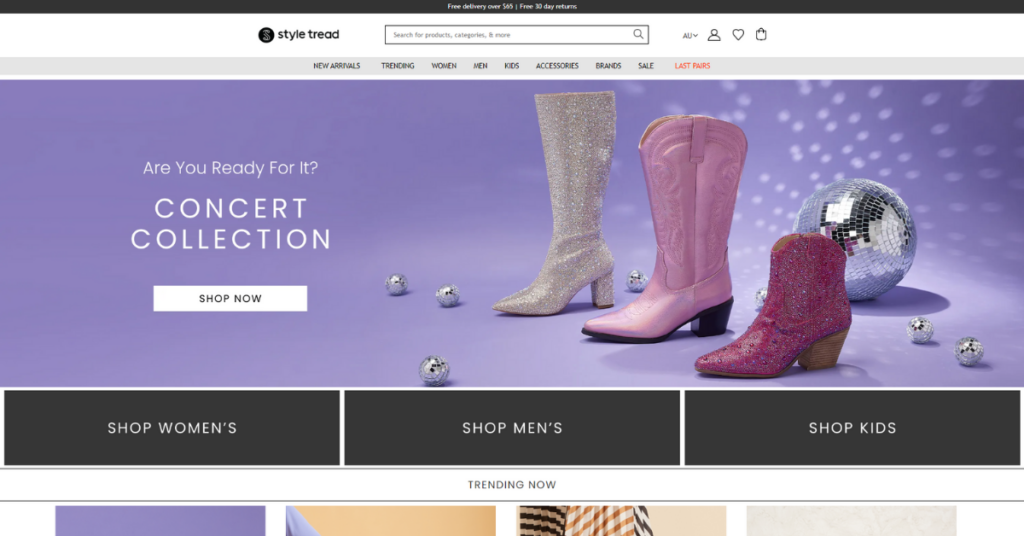
Pretty Little Thing is known as a famous Australian fashion brand specializing in creating trendy and modern outfits for young women. The combination of the latest fashion trends, product quality, and good value has helped Pretty Little Thing build a large fan base and maintain its position in the international fashion industry.
The eCommerce website of Pretty Little Thing uses a color palette of pink, white, and black with a design focus on minimalism and emphasis on user experience. Therefore, the brand deploys various unique features such as Smart Filtering & Searching, Image Search, Product Size Selection, Related Product Display, and Quick View Cart.
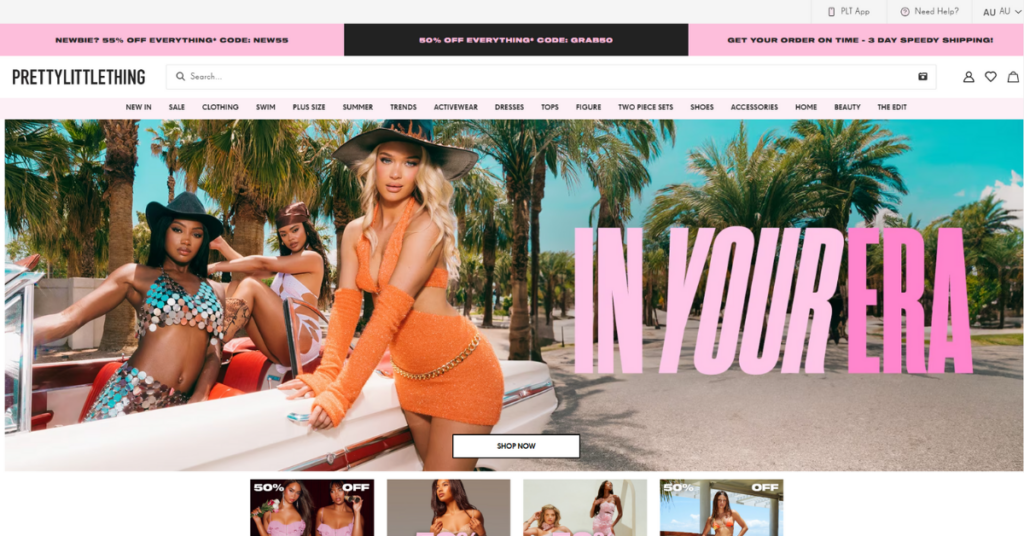
Here are the top 10 leading fashion eCommerce websites in Australia that have quickly adapted to the increasing demands in the consumer trend of online shopping.
With extensive experience in developing eCommerce websites for numerous Australian clients, SECOMM possesses a team of highly experienced experts with advanced technical skills and a profound understanding of the Australian eCommerce market.
Contact SECOMM or call the hotline (+84)28 7108 9908 for a detailed consultation!
 2
2
 3,750
3,750
 0
0
 1
1
The furniture eCommerce industry in Australia has seen significant growth in recent years, driven by a shift in consumer preferences from traditional offline shopping to online platforms.
According to IBISWorld, the industry generated a revenue of $1.7 billion in Australia in 2023, showcasing a growth rate of 5.9%. IBISWorld also predicts that by 2029, the revenue for Australia’s furniture eCommerce industry is anticipated to reach $2.4 billion.
Let’s delve into how the websites of the following 8 brands have played a role in fostering the growth of the Australian furniture eCommerce sector.
Temple and Webster is one of Australia’s leading brands in the furniture and interior decoration industry. This brand offers a diverse range of furniture and decorative items and emphasizes quality at the most favorable prices.
Over the years, Temple and Webster, operating without physical showrooms, has focused on online sales. Therefore, the eCommerce website of Temple and Webster has been invested in extensively, featuring a series of unique functionalities to optimize the customer shopping experience.
Notable features include Product Filtering and Search, Quick View of Products, Detailed Product Views, Displaying Products within the Same Category, and Order Checking. Additionally, Temple and Webster provides popular payment options in Australia such as PayPal, Afterpay, and Zip.
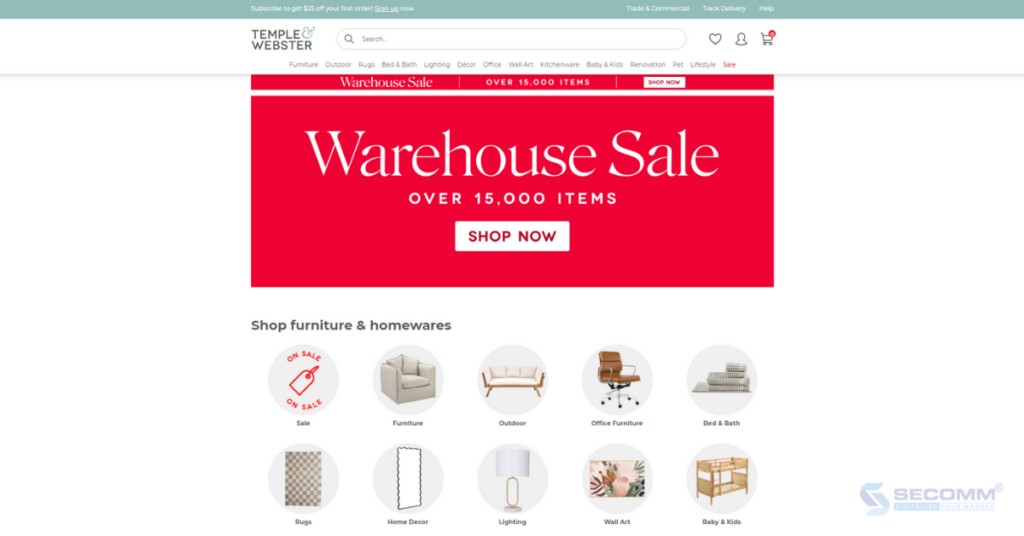
For over 30 years, Fantastic Furniture has become the top choice for customers seeking flexible and efficient furniture solutions. Currently, the brand owns more than 80 retail stores nationwide in Australia. In the realm of online sales, Fantastic Furniture has focused on building and expanding its eCommerce website.
Several unique features have been customized to facilitate easy shopping for customers. Some of these include Quick Product View, Product Color Selection, Product Comparison, Displaying Real Product Photos from customers’ Instagram, and diverse payment options such as Afterpay, Zip, and Latitude.
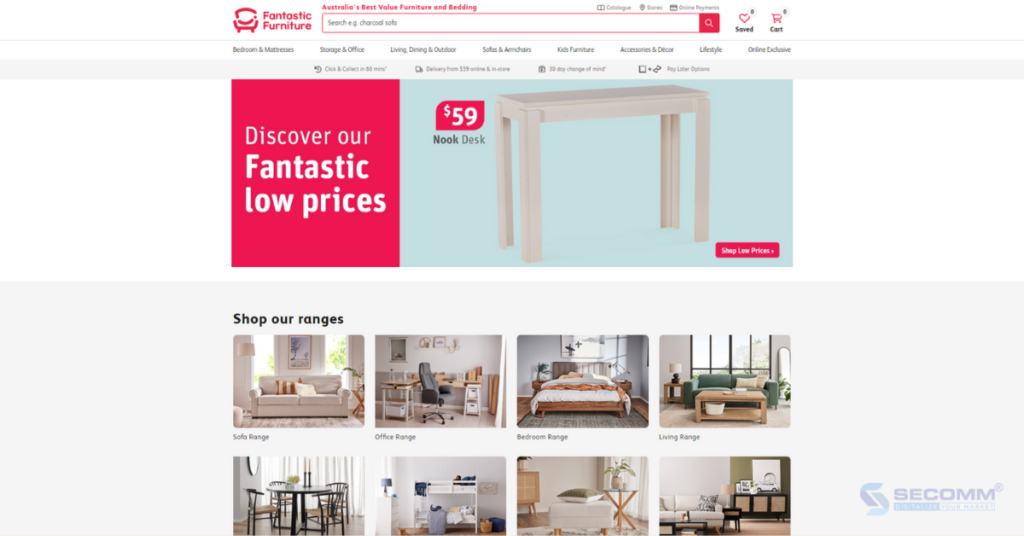
The next brand on this list is Amart Furniture. With a presence in over 40 locations in the Australian and New Zealand markets, Amart Furniture has gained popularity and trust from local consumers. The brand offers a diverse range of high-quality products and unique decorative solutions.
Amart Furniture’s furniture eCommerce website is a leading shopping destination in Australia, attracting over 6 million visits each month. With an intuitive interface and numerous advanced features, the website provides customers with a convenient and comfortable online shopping experience.
Additionally, Amart Furniture offers a 5-year quality guarantee on all its products and regularly introduces attractive promotional programs to attract and retain customers.
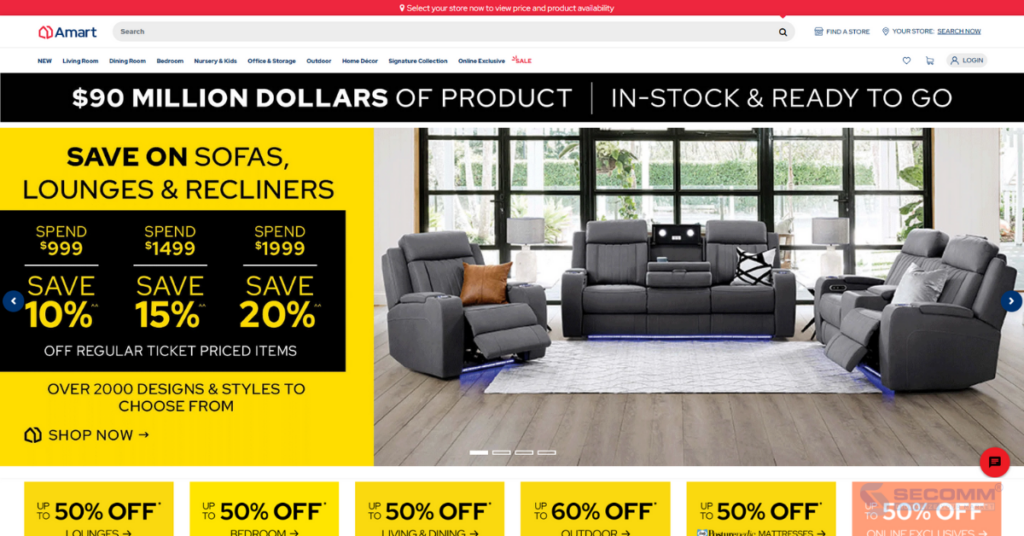
Freedom is renowned for its minimalist and modern-style furniture products. The brand’s product portfolio is quite diverse, ranging from living rooms, bedrooms, kitchens, outdoor furniture, and more. Freedom’s eCommerce website is designed with a harmonious and visually appealing interface, featuring numerous unique features to provide customers with an optimal experience.
Freedom also focuses on establishing a Loyalty Program, allowing customers to create accounts to accumulate points and enjoy attractive benefits while shopping. The combination of uniqueness, quality, and convenience of online shopping contributes significantly to Freedom’s strong position in the Australian furniture market.
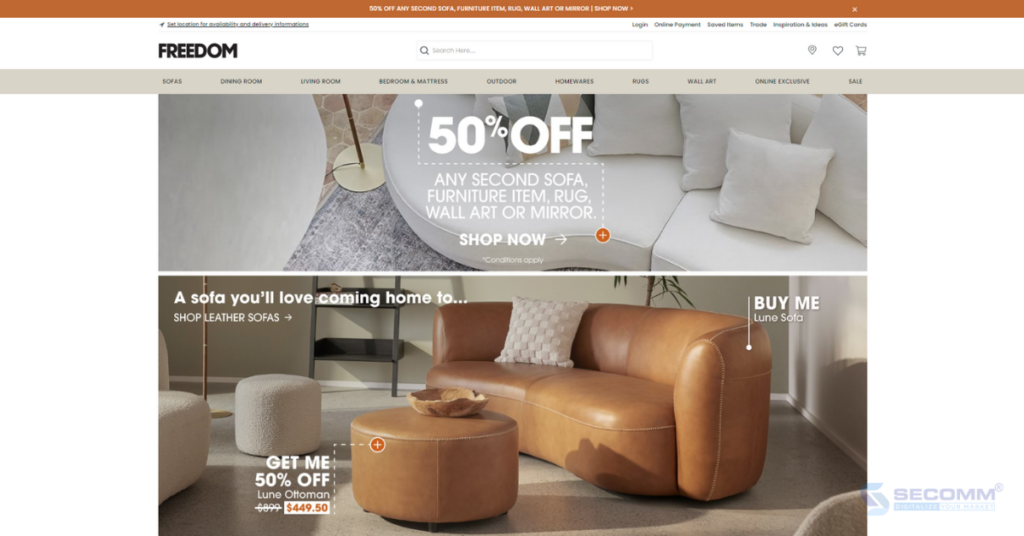
Nick Scali is a specialized Australian brand in designing sofas and retailing furniture. With over 50 years of operation, this brand has captivated customers with innovative designs and a commitment to providing sophisticated living spaces for every household.
Nick Scali’s furniture eCommerce website features several special functionalities to facilitate easy navigation and product purchases. Notably, the 360-degree product view and customization options for size and color based on customer preferences are highlighted. Additionally, the website’s minimalist and intuitive design further enhances the customer experience, making it smooth and enriching.
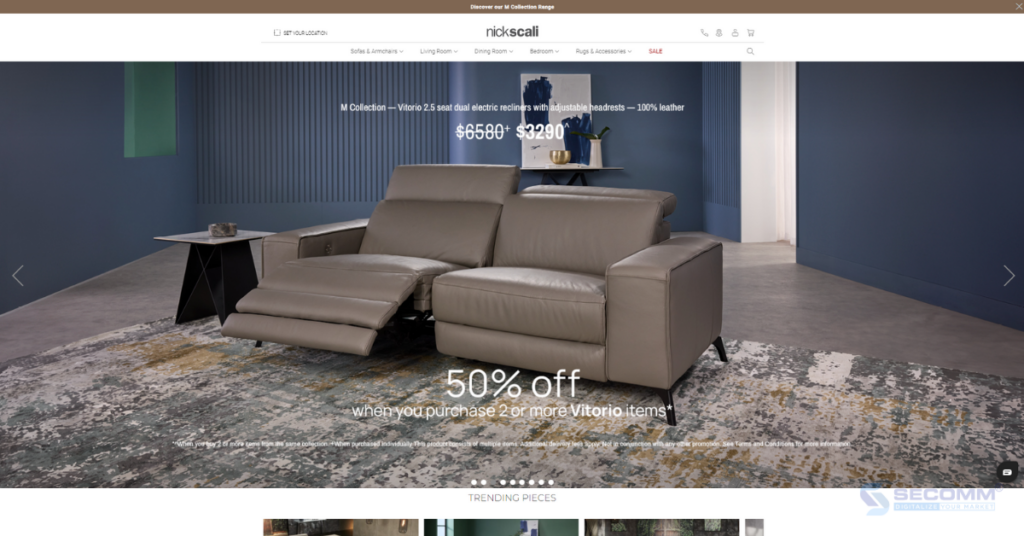
Koala is well-known in both the Australian and New Zealand markets for its high-quality, modern, and innovative furniture products. Furthermore, in the years 2023 and 2024, Koala’s mattresses consecutively ranked as the most beloved on Product Review.
Koala’s furniture eCommerce website is designed to showcase the elegance and modernity of its products. With an intuitive interface, customers can easily explore and select products. Additionally, industry-specific features such as AR/VR and 360-degree viewing are integrated into the website.

In the Australian furniture industry, Life Interiors stands out as a prominent and well-regarded name. Over the years, it has been the preferred choice for those who appreciate contemporary styles in furniture.
The brand places a significant focus on its online presence, achieving this through the development of a furniture eCommerce website with tailored features to enhance the shopping and payment experience for customers. Furthermore, Life Interiors regularly launches enticing shopping programs as part of its efforts to attract and engage customers.
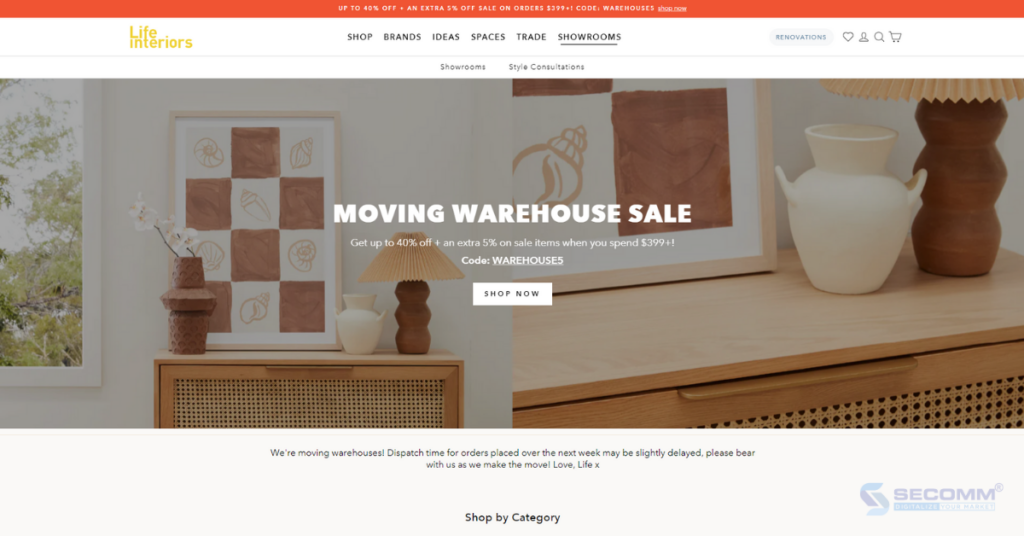
King Living is known in the Australian furniture market as an icon of luxury and innovation. The furniture eCommerce website is a reliable online shopping destination for customers seeking curated and high-standard furniture solutions. King Living has invested in developing various advanced features on the website to provide customers with the best shopping experience.
Notable features include 360-degree viewing, VR/AR, product specification viewing and downloading, one-page checkout, and more. Thanks to these efforts, for more than 40 years, King Living has established a strong presence in the consumer community, particularly among those who value the sophistication of premium living spaces.
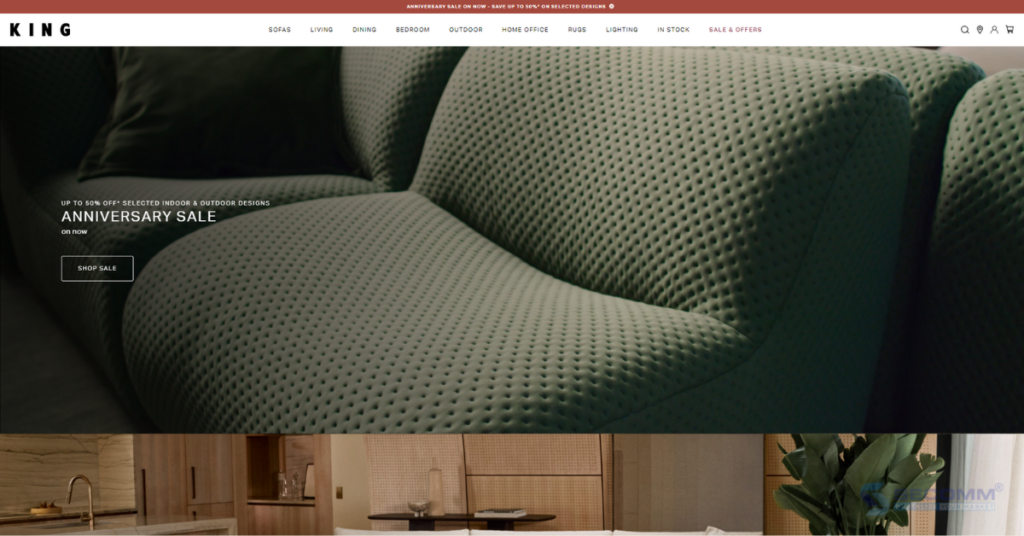
Above are the top 8 furniture brands in Australia that have successfully established and maintained their online presence by building eCommerce websites and investing to develop custom features.
With years of experience in developing successful e-commerce website projects across various platforms for numerous Australian clients such as Laybyland, Jasnor, RodShop, Trentham Estate, etc., SECOMM has a team of highly experienced experts with advanced technical skills and a deep understanding of the eCommerce market.
For detailed advice, please contact SECOMM or call the hotline (+84)28 7108 9908!
 13
13
 2,881
2,881
 0
0
 1
1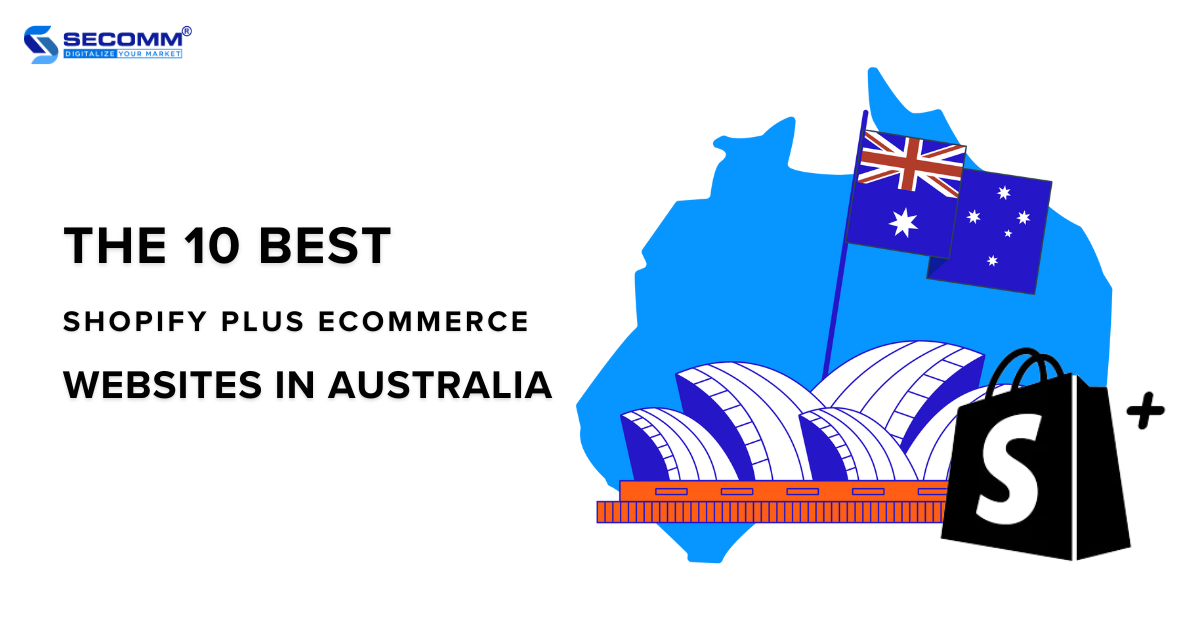
Shopify is a well-known SaaS platform among global e-commerce businesses, including those in Australia, where approximately 150 thousand live stores. Notably, Shopify Plus is regarded as the high-end version specially crafted for large enterprises to construct and enhance custom eCommerce websites.
In the following article, we will examine the top 10 leading Shopify Plus eCommerce websites in Australia.
JB Hi-Fi is a popular Australian consumer electronics retail brand that has gained worldwide recognition since its launch in 2004. In addition to its physical stores in Australia and New Zealand, the brand has made significant investments in its online sales, particularly in eCommerce websites.
The JB Hi-Fi website is built on the Shopify Plus platform, taking full advantage of its flexible customization capabilities to establish a distinctive and secure online shopping experience for its customers.
The design is carefully created, featuring yellow and black as the primary colour scheme. The interface is user-friendly, ensuring ease of use and navigation. These design elements contribute to a more convenient search and purchase process for customers.
Furthermore, the brand has incorporated the Buy Now Pay Later payment option alongside traditional methods, creating conditions for customers to swiftly make purchase decisions for their preferred products.
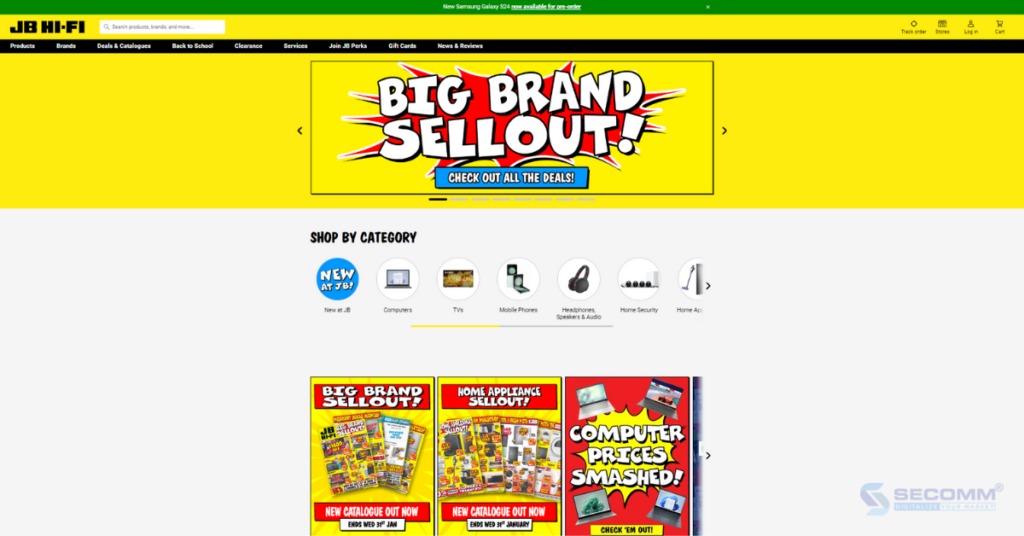
The Koala brand has gained significant popularity in the Australian and New Zealand regions, known for its high-quality furniture and home decor featuring modern and creative designs. Moreover, Koala’s mattress has consistently claimed the top spot as the most beloved mattress product on the Product Review ranking for both 2023 and 2024.
To enhance customers’ online shopping experience, Koala has built its eCommerce website using Shopify Plus. By leveraging exclusive solutions developed for Shopify Plus merchants, Koala has optimized product displays and the payment process, automated shopping events, and promotional programs, among other features.
The Koala website is designed to emphasize the sophistication and modernity of its products. With an intuitive interface, customers can easily explore and select products. Moreover, industry-specific features such as AR/VR and 360-degree viewing are integrated into the website.

Boody, the renowned Australian fashion brand, specializes in manufacturing and providing products made from natural and organic materials. Over the years, with a commitment to emphasizing quality and customer service, Boody has established a strong presence in the Australian and New Zealand markets.
The brand’s eCommerce website serves as a primary business channel alongside traditional brick-and-mortar stores. Therefore, Boody has invested in building its website with Shopify Plus.
With outstanding flexibility and scalability, Shopify Plus allows Boody to customize features freely while also leveraging exclusive solutions such as Shopify Flow and Payments to optimize the customer experience.
The design of Boody’s eCommerce website typically reflects simplicity, friendliness, and alignment with the brand’s values. Additionally, customer reviews are integrated into the website, creating a reliable and appealing online shopping space for those seeking sustainable fashion choices.

Life Interiors is a prominent name in the Australian market, specializing in the fields of interior design and decor. With a strong presence in Australia, Life Interiors has become a leading destination for those seeking stylish and contemporary furniture.
In the online realm, Life Interiors also places significant emphasis on using Shopify Plus to build and develop its eCommerce website. With a visually appealing and user-friendly interface, along with unique customizations and integrated features, Life Interiors provides customers with an optimal online shopping experience, offering quality and sustainable products.
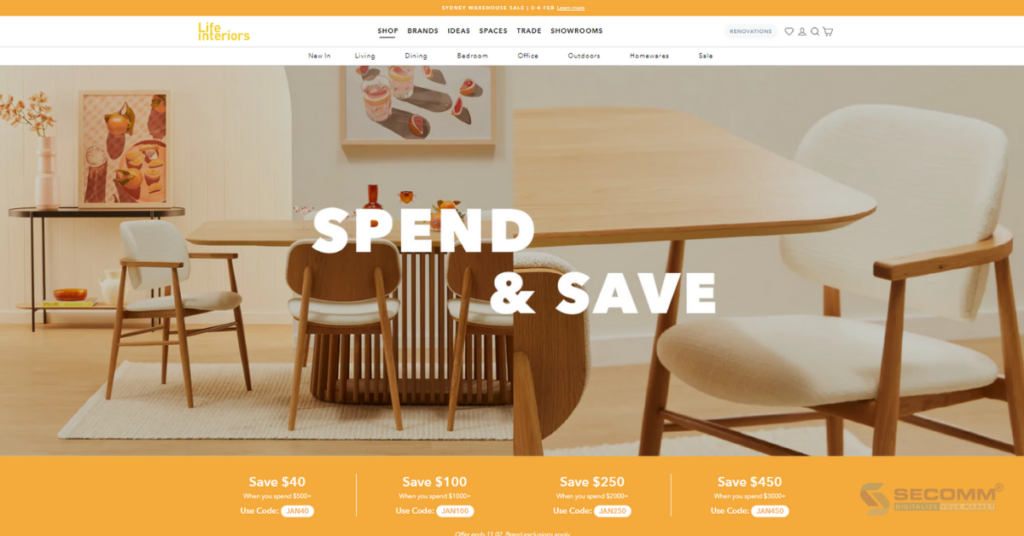
Milligram is a notable retailer in the Australian market. It specializes in office supplies, personal accessories, and unique and creative gifts. Milligram’s eCommerce website is built on the Shopify Plus platform, which provides a robust infrastructure for online business operations.
The use of Shopify Plus has helped Milligram manage online business performance flexibly and efficiently, from inventory management to order processing and customer interactions. In addition, Milligram offers a variety of payment methods and a customer loyalty program with enticing gifts to attract and retain customers.
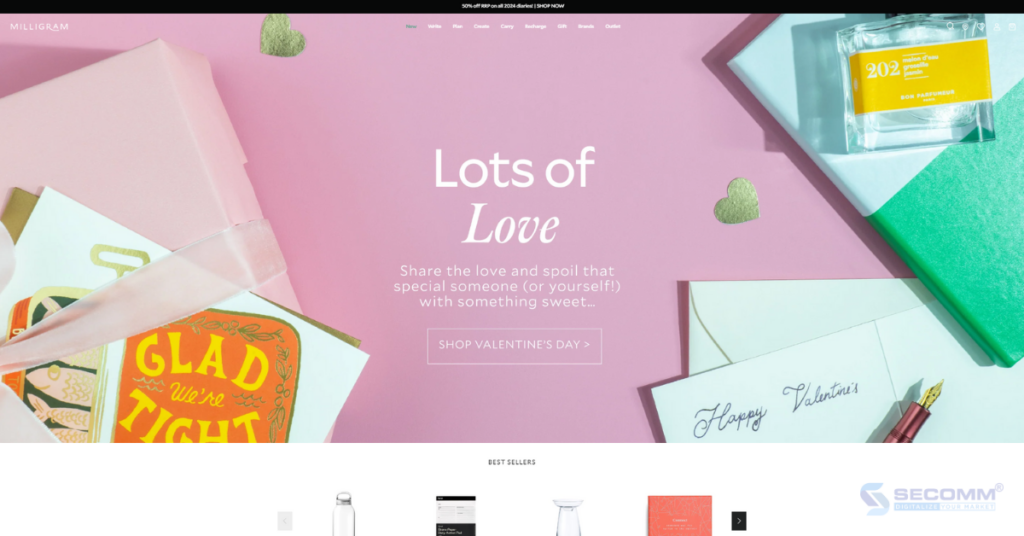
In Australia, Alternative Brewing is known as a reputable retailer of products and tools related to the art of coffee brewing and creative beverages.
With a mission to provide a personalized and high-quality brewing experience for coffee enthusiasts, Alternative Brewing has quickly gained popularity and preference within the community of high-quality beverage enthusiasts.
The eCommerce website of Alternative Brewing is a convenient shopping destination for various brewing machines and tools, as the shopping and payment experience is optimized with the infrastructure of Shopify Plus. Additionally, the brand offers customers 24/7 support services, a variety of secure online payment methods, and fast delivery options.
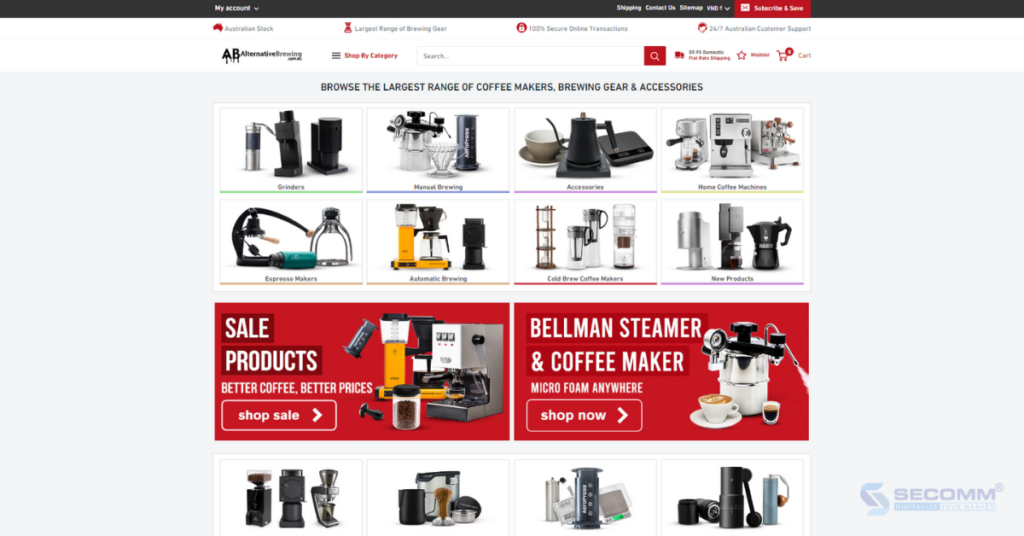
AMR Hair & Beauty is a brand specializing in products and services for hair care and beauty. The eCommerce website is built with Shopify Plus, a premium SaaS platform with numerous solutions to optimize the customer experience.
Through Shopify Plus’s infrastructure, this hair brand has developed and customized various unique features, such as displaying best-selling products, related products, and viewed products, showing store availability, and streamlining the payment process.
In addition, AMR Hair & Beauty has integrated various payment methods, including BNBL and LayBuy, into its eCommerce website.
As a result, AMR has created an online shopping space with diverse products, comprehensive information, and convenience for both professionals and consumers looking to care for their hair and appearance.
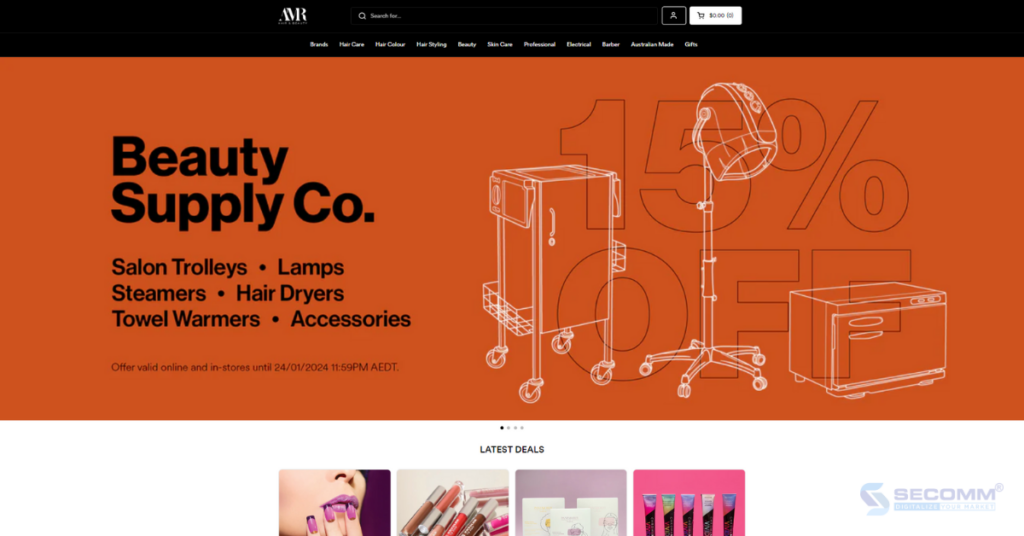
Beard & Blade is a leading brand in Australia, specializing in grooming products for beards and skin care for men. Initially, Beard & Blade’s eCommerce website was built on the Magento platform.
However, to enhance the shopping experience and facilitate easier management, they decided to switch to Shopify Plus – a powerful platform with premium features and flexibility.
Since making this transition, Beard & Blade has not only benefited from seamless system management and online interface but has also achieved notable successes. The flexibility of Shopify Plus has helped them optimize the sales process, enhance customer interaction, and notably improve overall business performance.
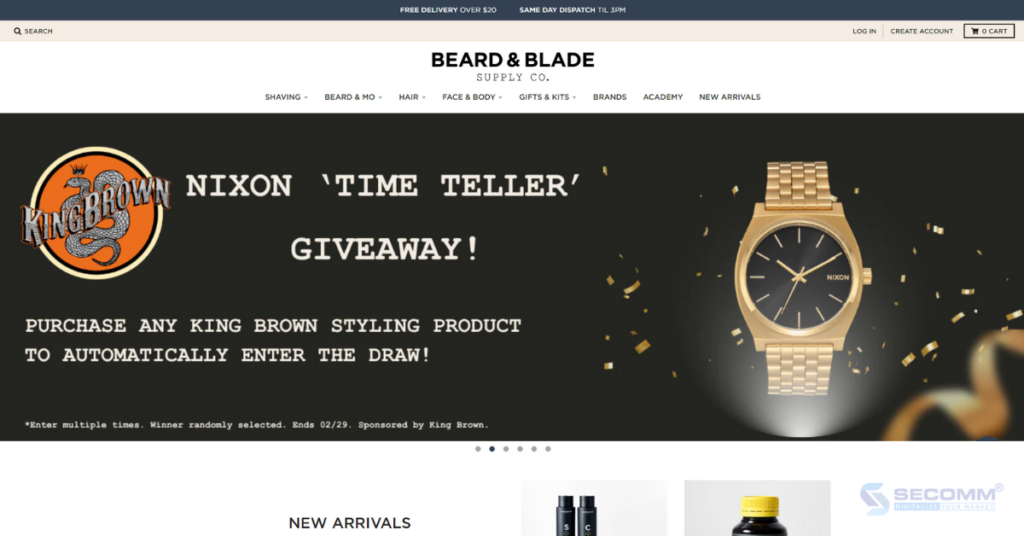
In 2020, Desky was officially launched. This brand specializes in providing furniture and accessories to decorate modern and comfortable workspaces, inspired by the increasing demand for home offices in Australia due to the impact of the COVID-19 pandemic.
As it quickly began to expand its scale, Desky aimed to have a robust and reliable eCommerce platform that could support rapid growth and handle large volumes of traffic. Therefore, Desky chose Shopify Plus to build and develop its eCommerce website.
Initially, the Desky team set a goal to launch their website, products, and brand within six months, but with Shopify Plus, the business achieved that in just three months.
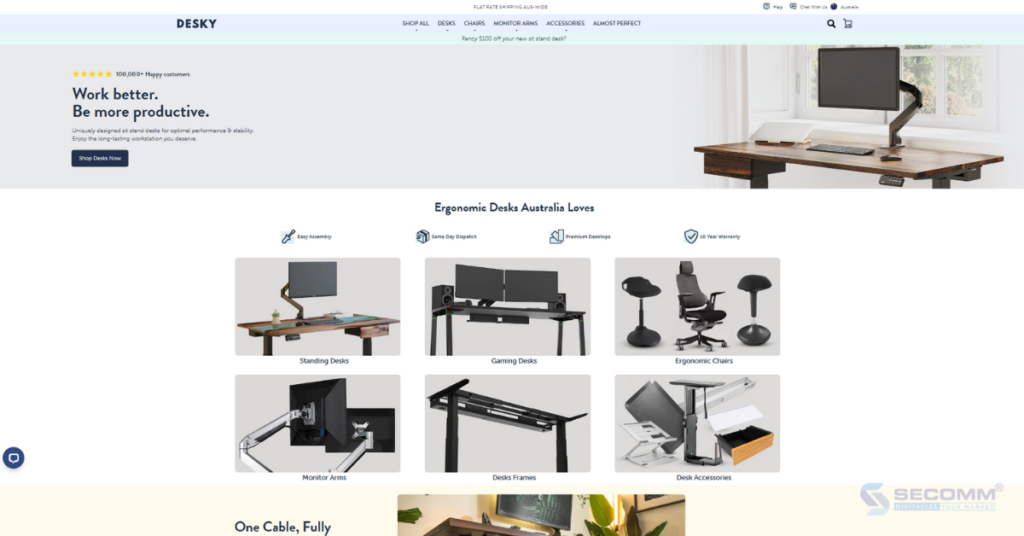
Since its establishment in 1991, DARCHE has been a leader in the Australian camping and outdoor products market. For over three decades, DARCHE has expanded its product range, providing customers with a diverse array of choices for their outdoor needs.
DARCHE’s core business model is B2B, and although OroCommerce has provided an eCommerce solution for B2B customers, it did not meet expectations due to performance issues and a subpar user experience on the website.
However, with the transition to Shopify Plus, DARCHE has built an eCommerce website that they can proudly present to all their B2B customers, thereby boosting sales during this process.
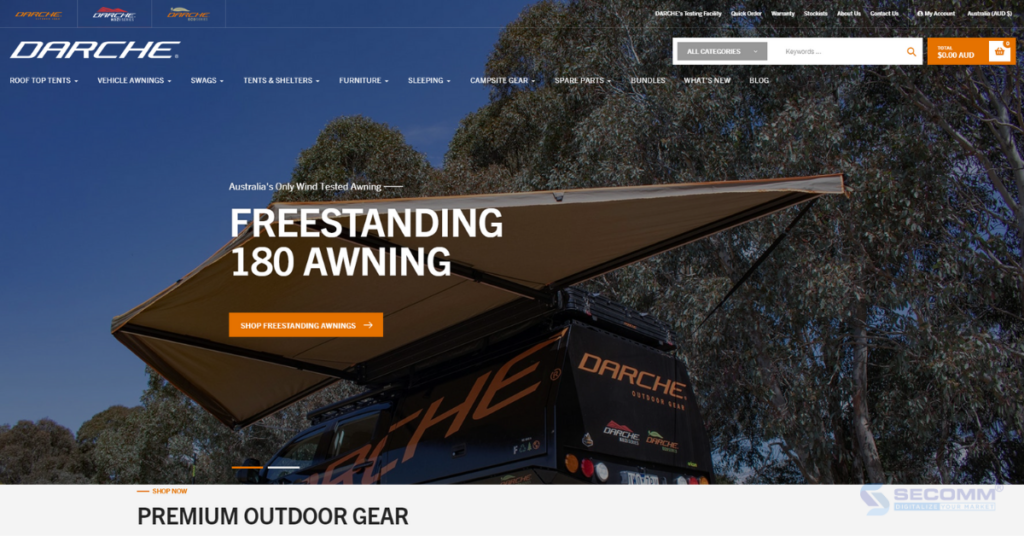
Build Your First Shopify Plus eCommerce Website Now!
Here are the top 10 Shopify Plus eCommerce websites, favored destinations for Australian consumers. These businesses not only prioritize product quality but also focus on enhancing the online shopping experience for customers.
With many years of successful collaboration in deploying Shopify Plus eCommerce websites for numerous Australian clients, SECOMM boasts a team of highly experienced experts with advanced technical skills and a deep understanding of the eCommerce market.
Contact SECOMM or call the hotline (+84)28 7108 9908 for more detailed information about the Shopify Plus platform!
 2
2
 3,573
3,573
 0
0
 1
1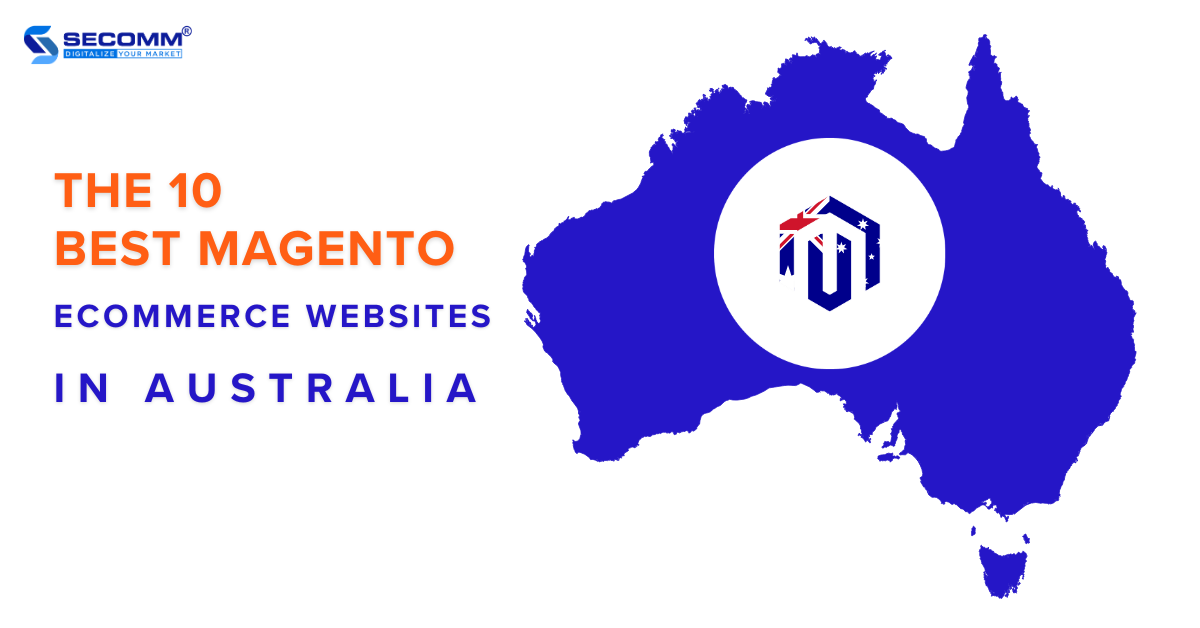
Magento is one of the most popular platforms today, allowing businesses in every industry to build customized eCommerce websites. In Australia, Magento is also highly favored and consistently chosen as the top preference for local businesses, with nearly 4000 live stores.
Let’s take a look at the top 10 leading Magento eCommerce websites in Australia in the following article.
Pet Barn is a leading brand in Australia, specializing in providing products and services for pets. Over a decade, Pet Barn has earned a strong reputation among the pet-loving community in Australia, offering a wide array of safe and high-quality products.
The Pet Barn eCommerce website is built on the Magento platform, a robust system for eCommerce and content management. By using Magento, Pet Barn can efficiently manage and operate while optimizing the online shopping experience for customers.
The flexibility, security, and ease of customization and expansion provided by Magento continually empower the brand to improve its services and cater to the ever-evolving and diverse needs of Australian customers.
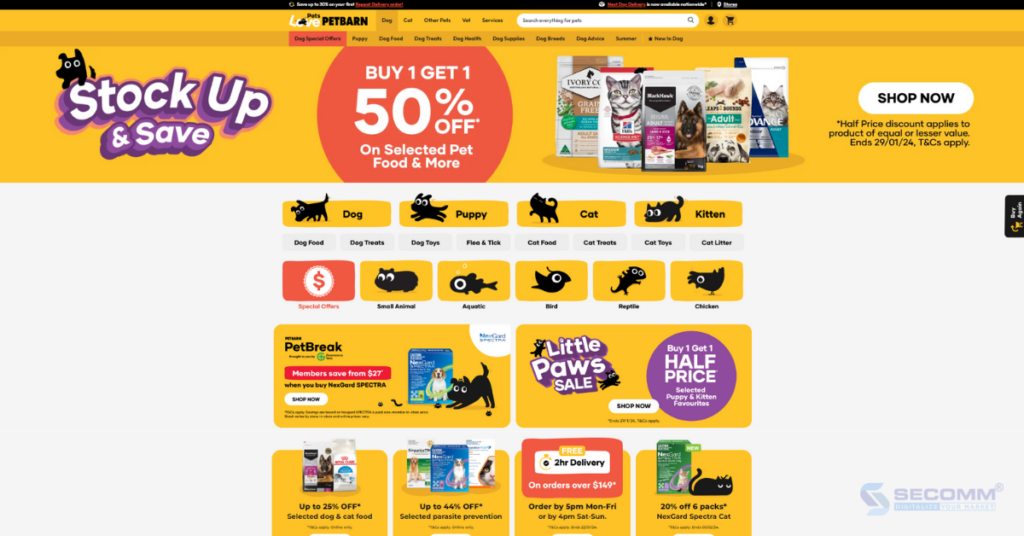
Forever New is an Australian fashion brand, renowned for its high-quality clothing and accessories for women with an elegant and modern style. Over a decade, Forever New has gained customer trust and secured a significant position in the Australian fashion industry.
The brand used Magento to build the eCommerce website, striving to boost its online visibility and find the most efficient operational solutions. This move played a huge role in Forever New’s digital success, enabling remarkable growth and swift adaptation to emerging trends in the market.
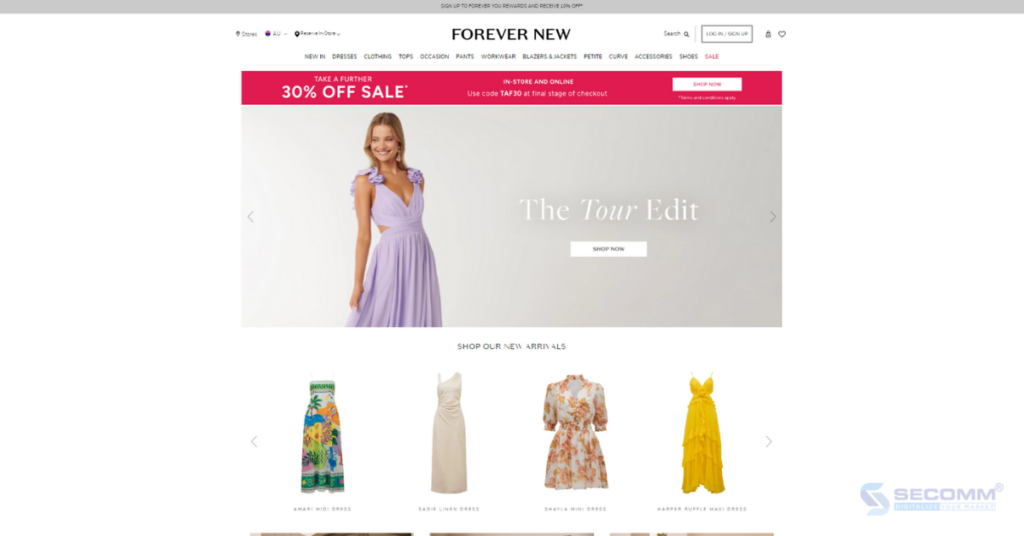
Dick Smith is one of Australia’s leading brands specializing in consumer electronics products. With a rich history and a robust reputation, Dick Smith has established a unique position in the Australian market, recognized as a trustworthy destination for technology enthusiasts seeking top-tier products.
The great customizability and scalability of Magento helped Dick Smith efficiently manage a large product portfolio and optimize the customer experience with unique features and promotional programs.
The website design not only ensures a seamless online shopping experience but also reflects the brand’s identity with a visually appealing, innovative, and user-friendly interface. The advanced search feature and product filters make it easy for customers to find their favorite items.
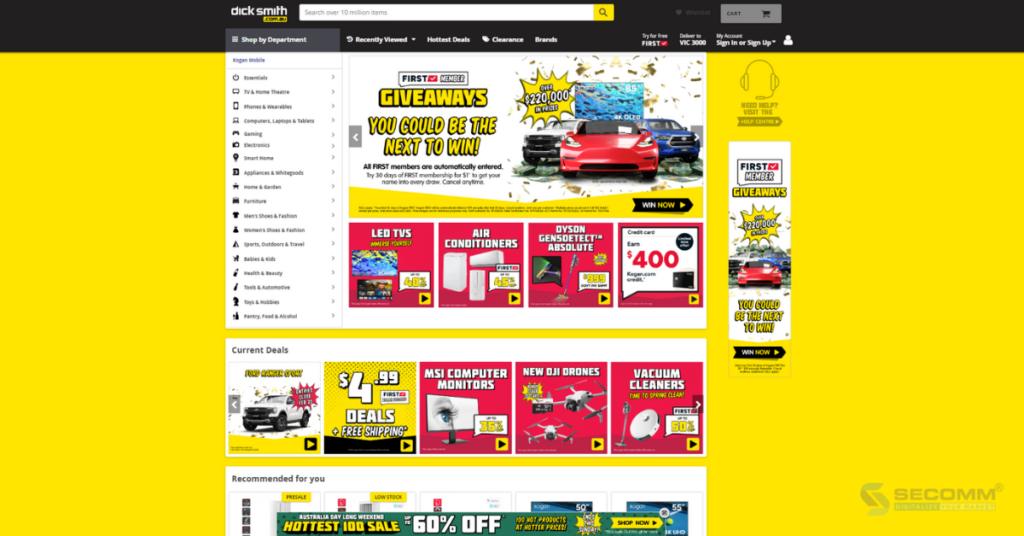
Another widely known fashion brand throughout Australia is Bonds. This brand is famous for its diverse array of fashion products for men, women, and children, offering a variety of styles, and sizes, as well as ensuring durability and safety.
Magento, a top-tier eCommerce platform, has delivered numerous advantages to Bonds. The flexibility in managing products, high customization, and easy scalability have aided Bonds in maintaining diversity in its collection and swiftly adapting to market trends.
The Bonds eCommerce website showcases the brand’s sophistication through a visually appealing user interface and provides advanced search features, secure payment processes, and detailed product information. This ensures that Bonds not only retains its current customer base but also attracts the attention of newcomers looking to experience the comfort and distinctive style of the brand.
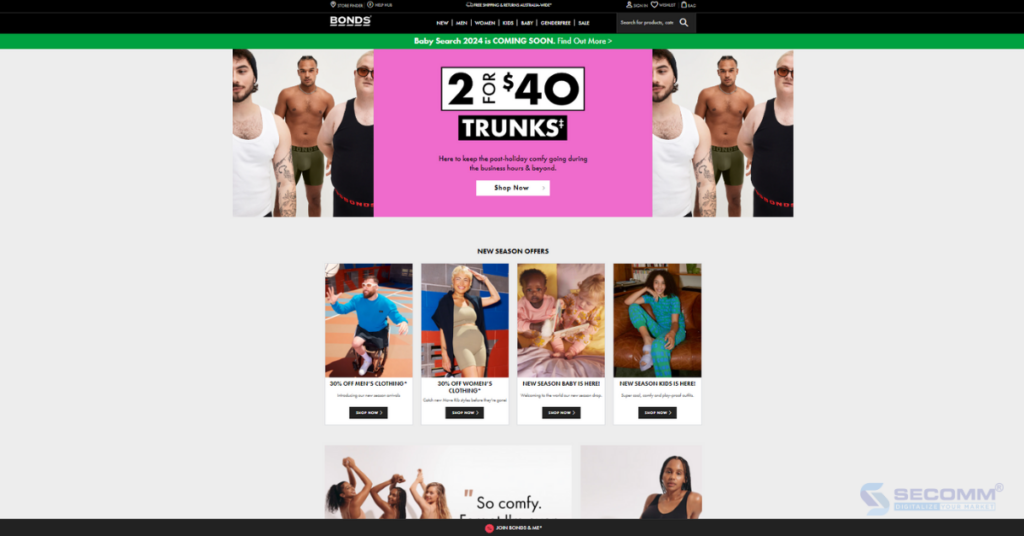
Bed Bath N’ Table is a renowned brand in Australia, specializing in providing furniture and decorations for bedrooms, bathrooms, and dining areas. With a focus on quality and beautiful design, Bed Bath N’ Table has been promoted as an ideal destination for those seeking a luxurious and comfortable living space.
The eCommerce website, built with Magento, offers flexible customization and scalability. The website impresses with a user-friendly interface, an advanced search system, a secure payment process, and optimization.
Moreover, the brand provides useful information about home decor and helpful cleaning tips. To date, Bed Bath N’ Table is not only a reliable furniture shopping destination but also a place for customers to find inspiration and ideas to decorate their living spaces.
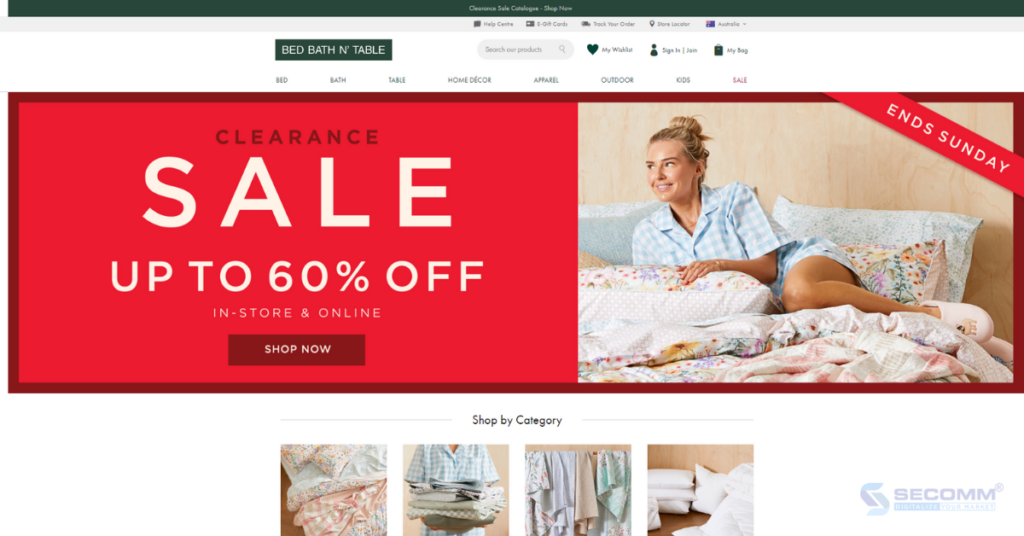
Sussan, a long-established and reputable fashion brand in the Australian market, has won the hearts of consumers through the blend of modern style and comfort. Over 80 years, Sussan has become an icon in the Australian fashion industry, known for creating outfits that reflect the confidence and creativity of modern women.
The eCommerce website of Sussan is a good destination for fashion enthusiasts seeking quality products. Developed on the Magento platform, the website helps Sussan deliver an optimal customer experience and enhance operational efficiency.
Moreover, the website integrates secure and convenient payment features, offering detailed insights into product information and origins. This creates an interesting and reliable shopping experience for Sussan’s customers.

Kathmandu, a well-known brand specializing in outdoor apparel and equipment for adventure and sports, has made a notable contribution to enhancing the excitement and comfort of outdoor living. The Magento-developed eCommerce website of Kathmandu offers a rich customer experience that can be easily customized and expanded based on business needs.
Alongside the optimized shopping experience, Kathmandu provides enticing discounts and promotional programs to attract new customers and retain the loyalty of existing ones.

Sportsgirl, a renowned fashion brand in Australia, has dominated the market with innovation and diversity in its women’s fashion collections. Over 70 years, Sportsgirl isn’t just a shopping destination but also a source of inspiration for personal style, blending the latest fashion trends with a unique flair.
Sportsgirl’s eCommerce website, powered by Magento, allows the brand to deliver an optimal customer experience while effortlessly customizing features and expanding the system to meet the evolving needs and trends of the market.
Moreover, Sportsgirl provides customers with appealing offers, including discounts, buy one get one free promotion, free shipping, gift card giveaways, and a variety of payment methods.
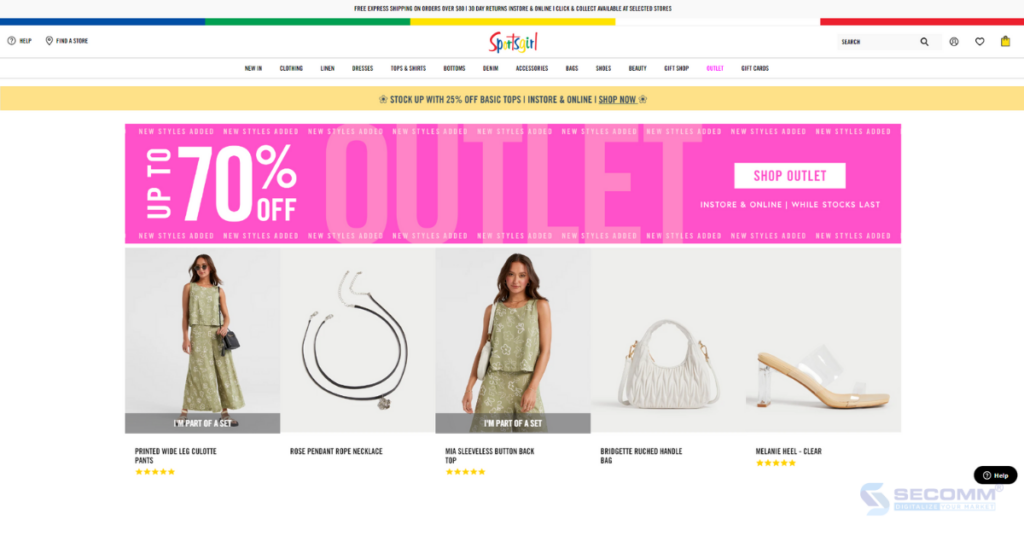
Another well-known Australian furniture brand on this list is King Living. This brand has become an icon of luxury and innovation in creating high-quality furniture products.
King Living’s eCommerce website is a reliable online shopping destination for customers seeking the most convenient solutions for furniture purchases. The website is built and developed on the Magento platform, allowing King Living to freely customize unique features specific to the industry to provide the best online shopping experience for customers.
Notable features include 360-degree viewing, VR/AR capabilities, product specification viewing and downloading, one-page checkout, and more. After over 40 years, King Living has built a strong reputation in the consumer community, particularly among those who appreciate the value of upscale living spaces.
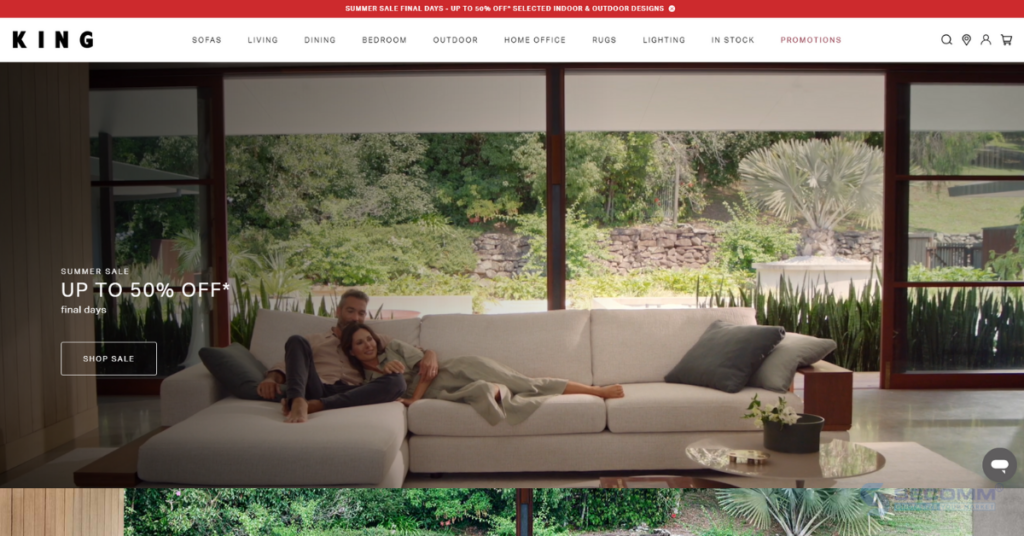
Chemist Direct is a leading brand in the Australian market, offering a wide range of healthcare and beauty products and services. The brand not only provides a diverse selection of medications, vitamins, and beauty items but also prioritizes delivering quality healthcare information to empower customers in effective at-home health management.
Utilizing Magento for its eCommerce website, Chemist Direct can tailor unique features to enhance customers’ shopping experiences. The website offers a variety of products from multiple brands and diverse payment methods, including the Buy Now Pay Later option.
Moreover, with advanced search functionality and a secure and simple payment process, the Chemist Direct website stands out, making it easy for customers to find and purchase high-quality healthcare and beauty products.
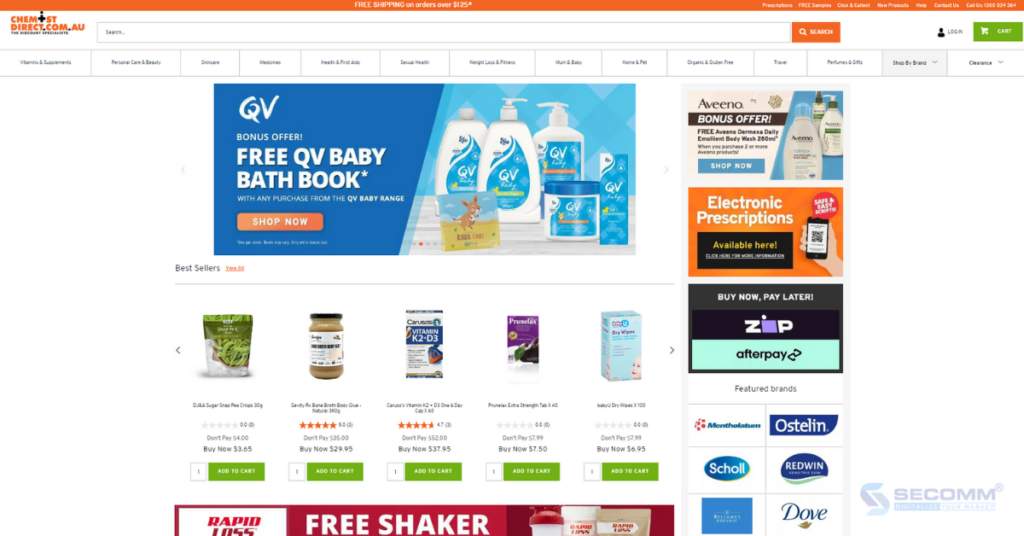
Build Your First Magento eCommerce Website Now!
Above are 10 eCommerce websites in Australia, notable for being built on the Magento platform. These brands have effectively utilized Magento’s customizable and flexible features to introduce unique features, ultimately enhancing the overall customer shopping experience.
With extensive experience in successfully developing Magento eCommerce projects for various Australian clients such as Laybyland, Jasnor, RodShop, Trentham Estate,
etc, SECOMM boasts a team of highly skilled experts with advanced technical skills and a deep understanding of the eCommerce landscape.
For further details about the Magento platform, please contact SECOMM or call the hotline at (+84)28 7108 9908!
 2
2
 3,368
3,368
 0
0
 1
1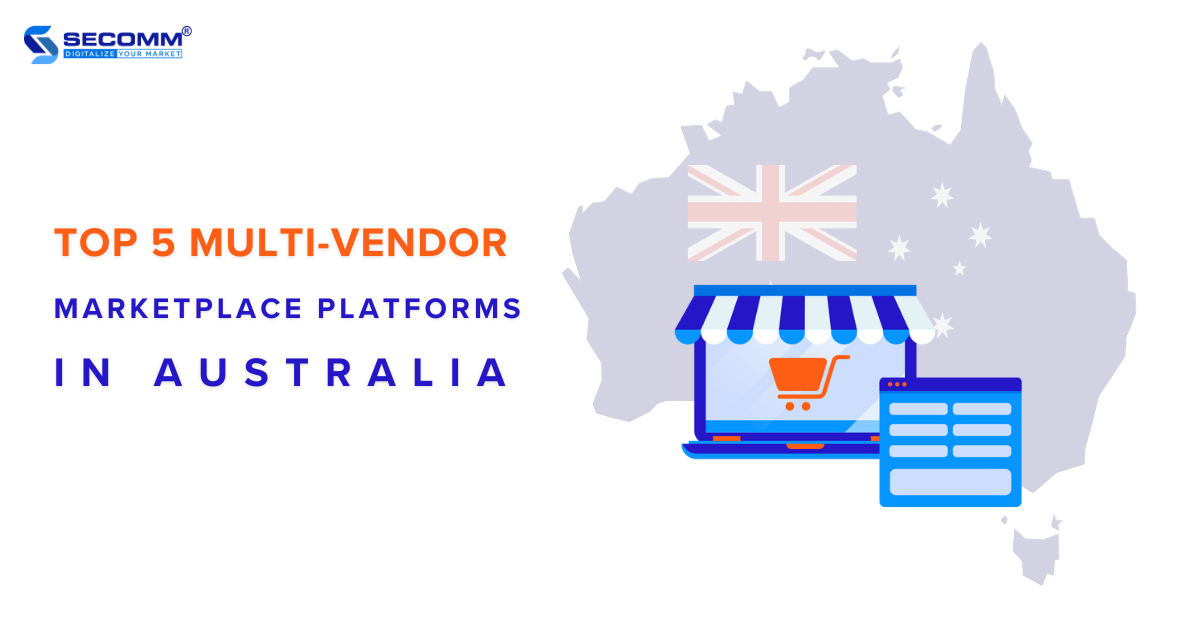
The demand for shopping on multi-vendor marketplaces has been rising in Australia recently, particularly since the Covid-19 pandemic.
Data from Statista, up to December 2023, reveals the leading players in the Australian multi-vendor marketplace market, measured by average monthly visits. This includes international giants like Amazon and eBay and local brands such as Kmart and Coles.
Therefore, other Australian businesses still have ample opportunities to join the eCommerce landscape. The critical initial step is to choose the right platform to build an online marketplace that suits the specific business needs.
Here 5 popular choices of many Australian eCommerce businesses.
Learn more: 14 must-have features to build your online marketplace
Marketplacer is a Software as a Service (SaaS) platform that allows you to create your multi-vendor marketplace by integrating with existing eCommerce systems like Adobe Commerce, BigCommerce, Salesforce Commerce Cloud, and commercetools.
You can also build the Headless eCommerce marketplace by integrating custom frontends into Marketplacer’s backend through APIs. This gives you complete control over the user experience and the optimized platform operation.
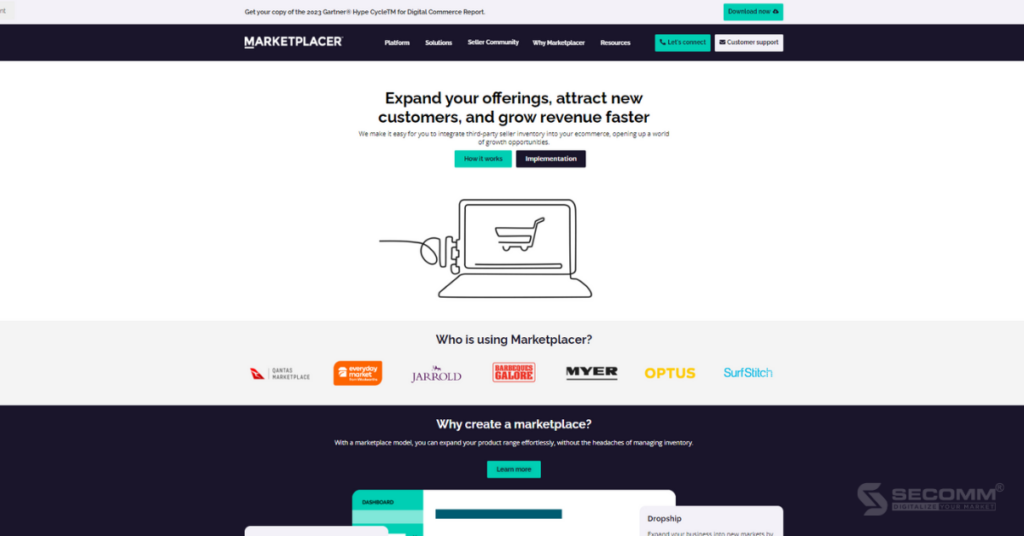
Pros:
Cons:
Top features:
Price: Pricing may vary based on specific requirements
Learn more: Build your first online marketplace with the Marketplacer platform
Magento 2 is a widely used eCommerce platform globally, known for its flexibility and superior scalability. The platform offers you the Multi-Vendor Marketplace Extension, allowing you to build your online marketplace with the Magento framework.
Using this extension, you can convert your Magento eCommerce website into a feature-rich marketplace like Amazon and eBay.
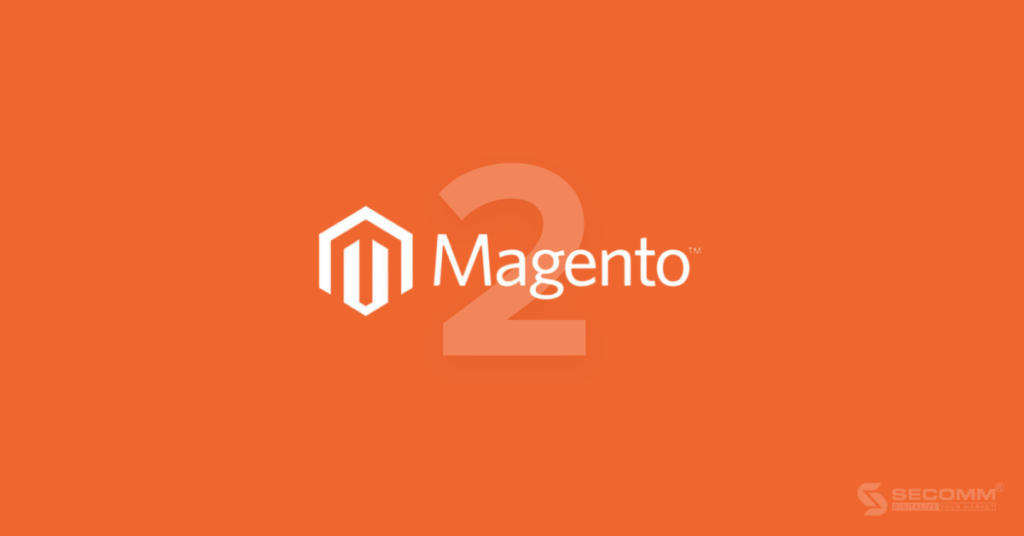
Pros:
Cons:
Top features:
Price: Pricing may vary based on specific requirements
Learn more: Magento 1 vs Magento 2: Full Comparison
Yo!Kart is a leading self-hosted eCommerce solution that you can consider for building a customized online marketplace. Yo!Kart is designed to be user-friendly
prominent that businesses can consider for building a customized online marketplace. Designed to be user-friendly, Yo!Kart allows businesses complete control, customization, and flexible scale to manage and operate their eCommerce marketplace efficiently.
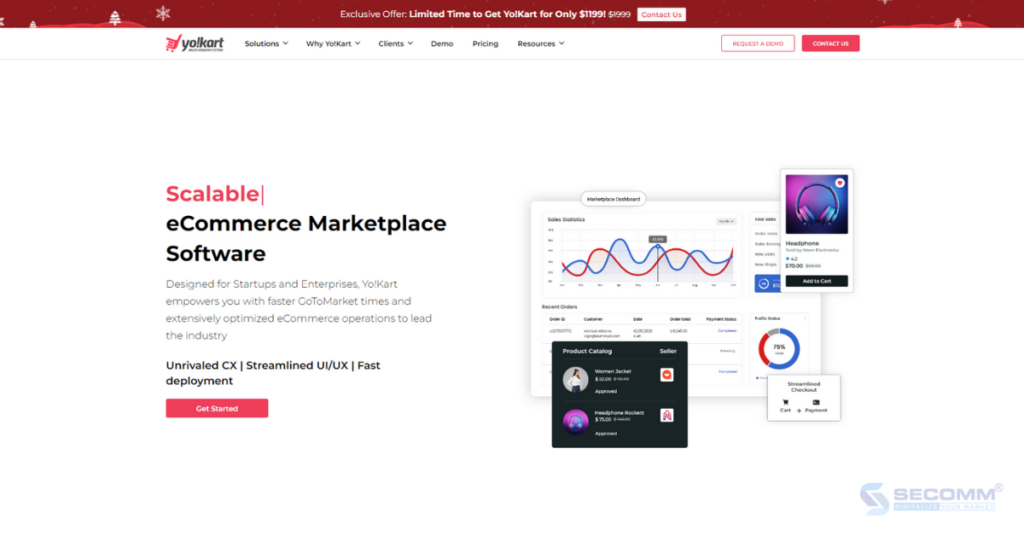
Pros:
Cons:
Top features:
Price: Starting from $1099/year. However, costs may vary based on specific requirements.
CedCommerce is a platform that helps you expand your online operations by creating a feature-rich eCommerce marketplace. With CedCommerce, you can easily manage multiple vendors and provide them with a robust platform to sell their products.
One key feature of CedCommerce is its ability to integrate with various eCommerce platforms such as Magento, Shopify, BigCommerce, WooCommerce, etc. CedCommerce, with its high flexibility, offers you many customization options, including the ability to customize vendor onboarding processes, commission rates, shipping rates, and more.
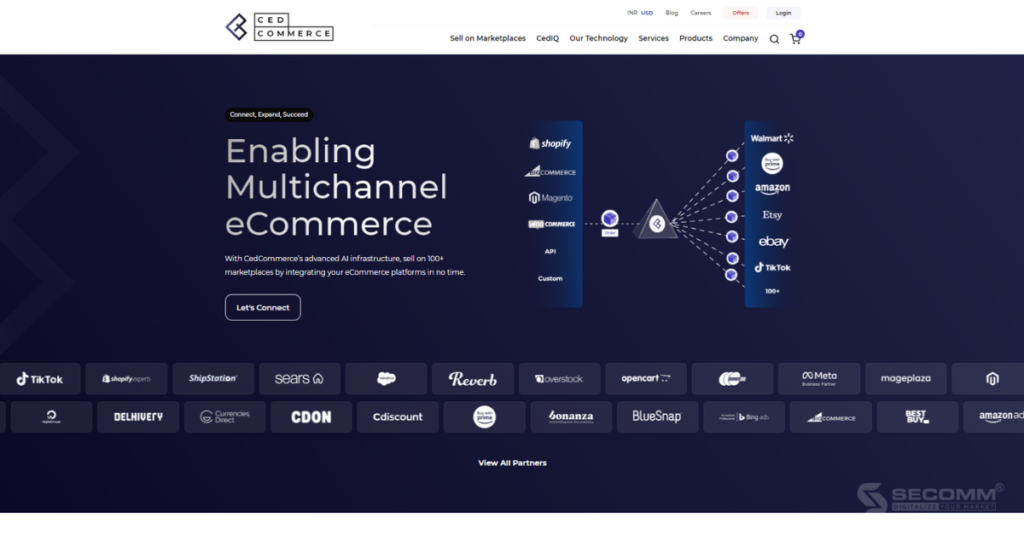
Pros:
Cons:
Top features:
Price: The fees aren’t public and will vary based on specific requirement
CS-Cart Multi-Vendor is known as a specialized platform for building online marketplaces with superior customizability and scalability. Integrated with over 26 languages and featuring unique functionalities, this all-in-one solution is suitable for various industries and deployment needs.
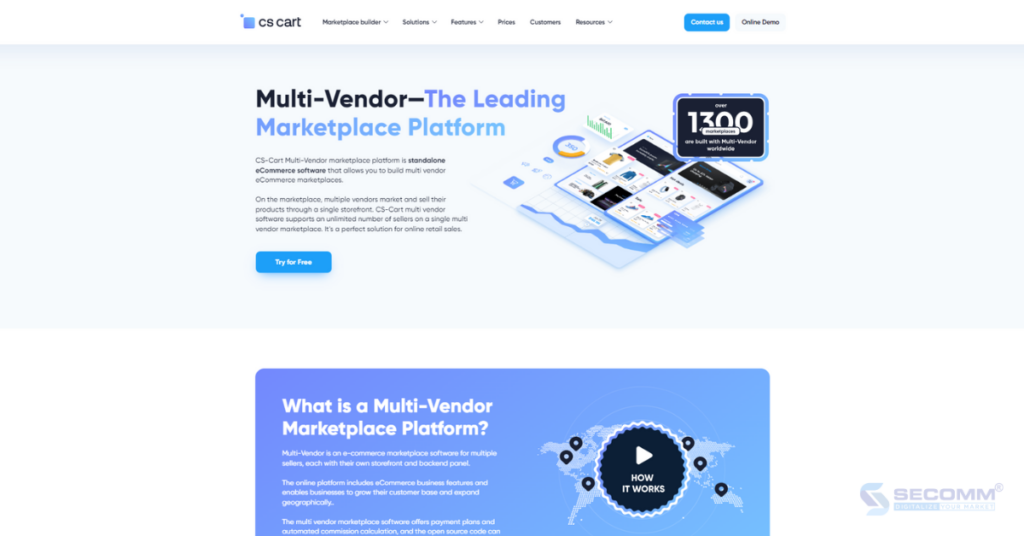
Pros:
Cons:
Top features:
Price: Pricing may vary depending on specific needs.
Build Your First Multi-Vendor Marketplace Platform Today!
Here are 5 platforms widely used by Australian businesses to build flexible, feature-rich, and optimized custom online marketplaces. With experience in deploying numerous multi-vendor marketplace projects for Australian clients such as Laybyland, Seconds Deals, etc., SECOMM has a team of highly skilled technical experts with a deep understanding of the Australian market.
If you’re ready to build an eCommerce marketplace, contact SECOMM or call (+84)28 7108 9908 today for a free consultation!
 2
2
 4,052
4,052
 0
0
 1
1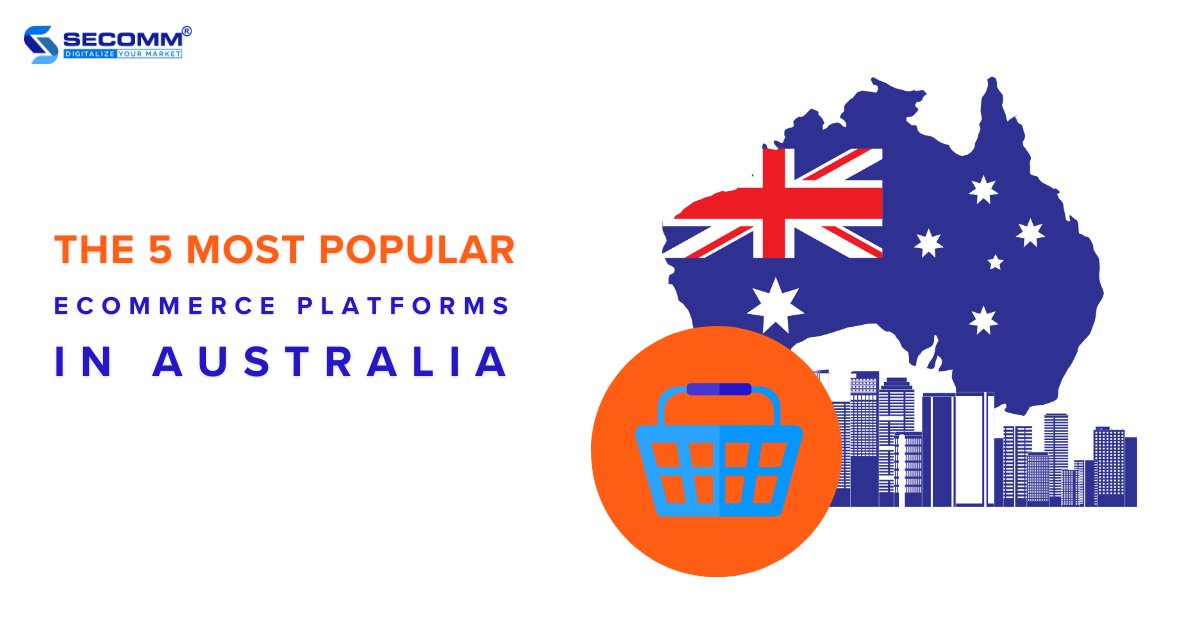
The Australian eCommerce world is continually evolving alongside the constant emergence of technological solutions. As a result, there is an increasing and diverse range of choices for eCommerce platforms.
This presents both an advantage and a challenge for businesses, as selecting the right platform for building an eCommerce website is a crucial first step.
Below are the top 5 leading eCommerce platforms in Australia.
Learn more: Top 10 most-visited eCommerce websites in Australia
Magento is a globally popular open-source platform, and its prevalence extends to Australia as well. According to BuiltWith, there are currently more than 4000 live websites in Australia utilizing the platform.
With its high flexibility, businesses can effortlessly tailor features and scale the system according to their unique business requirements.
Presently, Magento provides businesses with two versions: Open Source (Free) and Adobe Commerce (Paid).
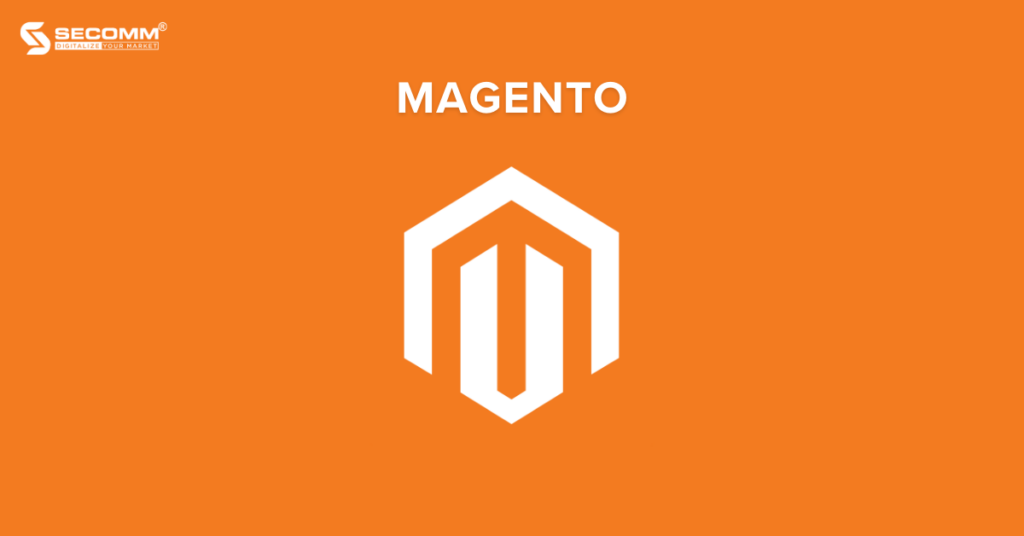
Pros:
Cons:
Core feature:
Pricing:
Learn more: Top Magento eCommerce websites in Australia
Shopify is a popular SaaS platform with over 4.8 million active websites. In Australia alone, over 150 thousand online stores are operating on the platform.
Recently, the premium version of Shopify, ‘Plus,’ has garnered attention from businesses across various sectors in Australia.
These businesses may have previously deployed different eCommerce platforms and later switched to the Plus to seek a superior solution. Some businesses initially launched websites with core plans and later upgraded to ‘Plus’ to optimize their operations.
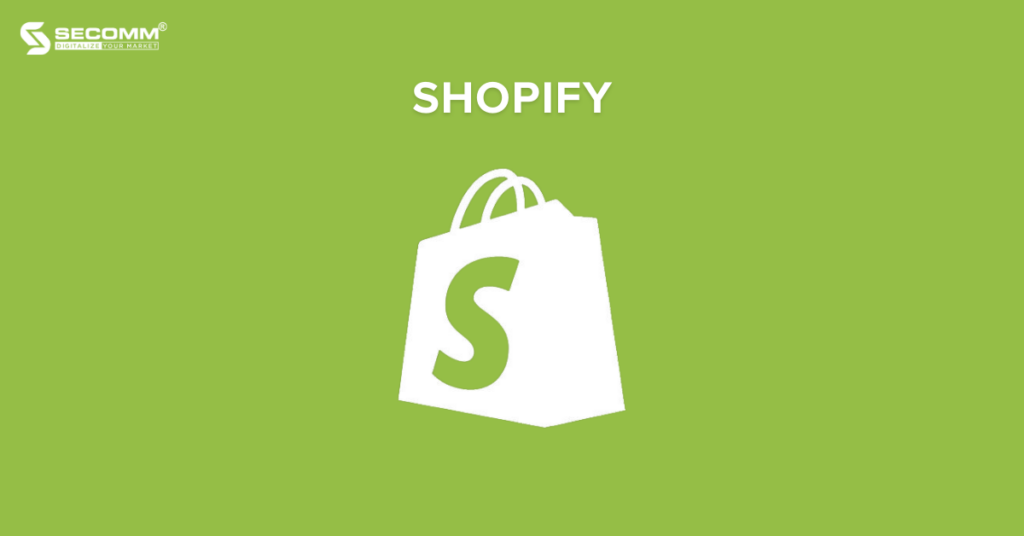
Learn more: Top eCommerce websites upgrade to Shopify Plus
Pros:
Cons:
Core feature:
Pricing
Here are Shopify pricing plans:
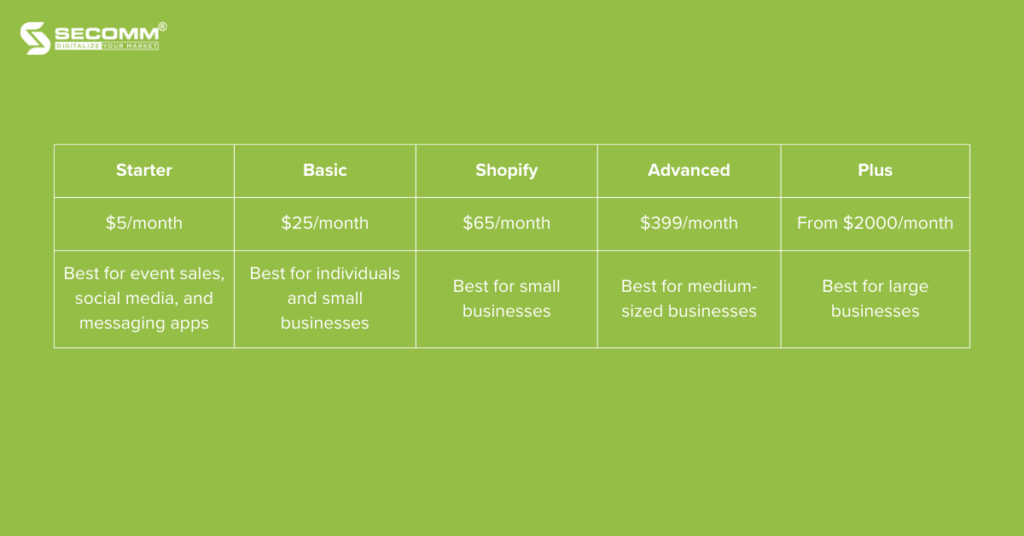
BigCommerce is another popular SaaS platform worldwide, with over 43 thousand active websites. In Australia, there are more than 2 thousand active BigCommerce websites.
The standout feature of this SaaS platform is its integrated features, enabling businesses of all sizes and technical expertise to deploy eCommerce websites quickly. In addition to standard solution packages, BigCommerce offers an ‘Enterprise’ version tailored for large businesses with custom pricing.
Learn more: Top 10 eCommerce websites using BigCommerce
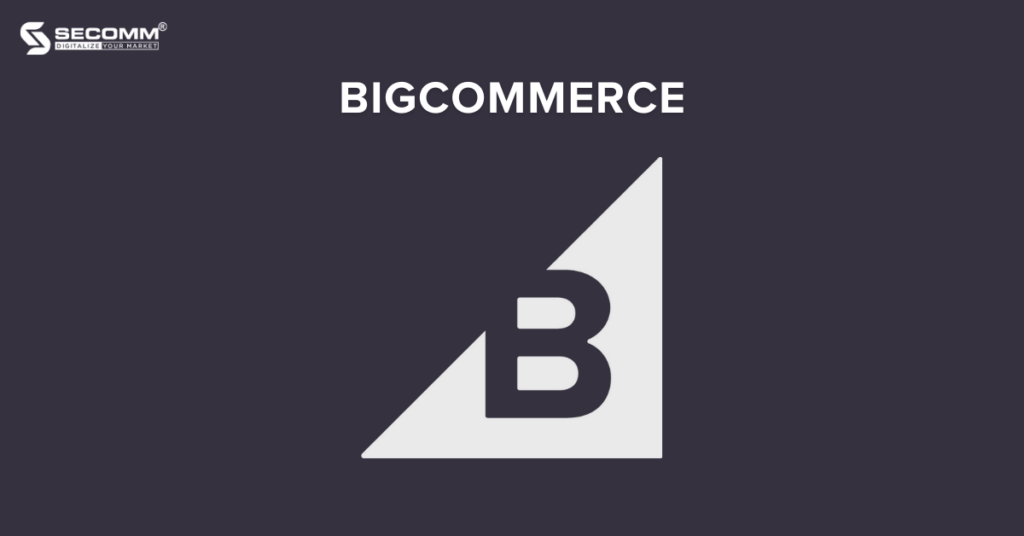
Pros:
Cons:
Core feature:
Pricing
Here are BigCommerce pricing plans:
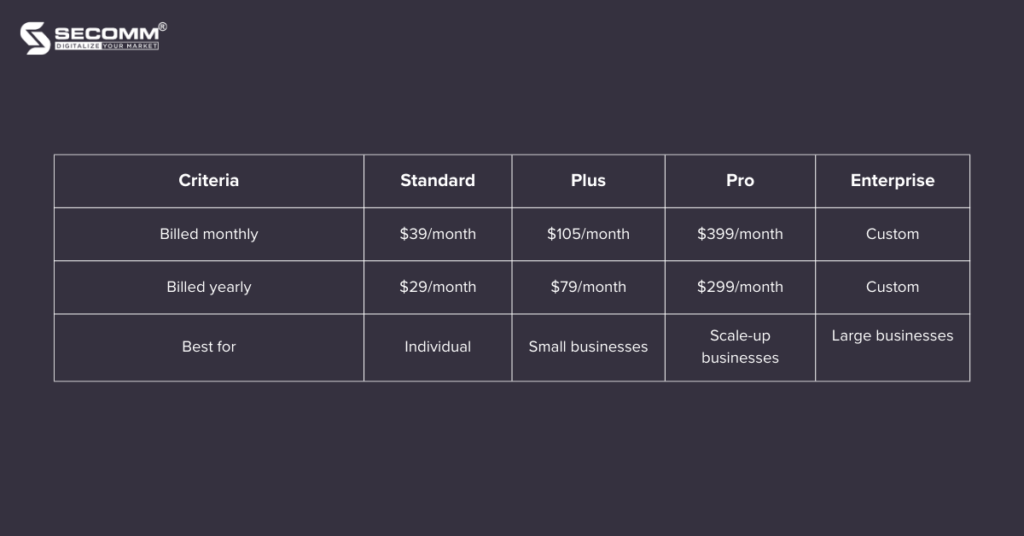
WooCommerce, a free and open-source WordPress plugin, enables brands to integrate eCommerce functionality into their existing WordPress websites.
With just a few clicks, the WooCommerce plugin helps convert a standard WordPress site into a fully-featured eCommerce platform, complete with essential features and easy customization.
Learn more: 20 websites using WooCommerce
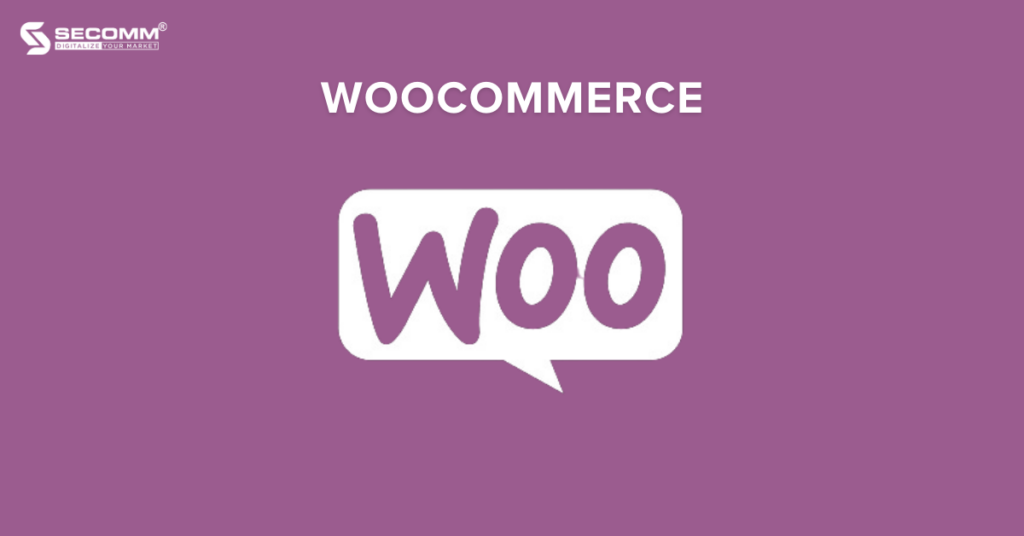
Pros:
Cons:
Core feature:
Pricing: Free to use. However, some integrations with other plugins may incur charges.
OpenCart is a globally popular open-source platform, powering over 900 thousand active websites worldwide. In Australia, it has gained popularity with more than 2 thousand active OpenCart websites, establishing itself as a favored open-source platform in the country, following Magento.
Founded by Daniel Kerr in 1998, OpenCart operates as open-source software, utilizing the PHP programming language. It currently offers two versions: Free (Free-to-use version) and Cloud Store (Paid version).
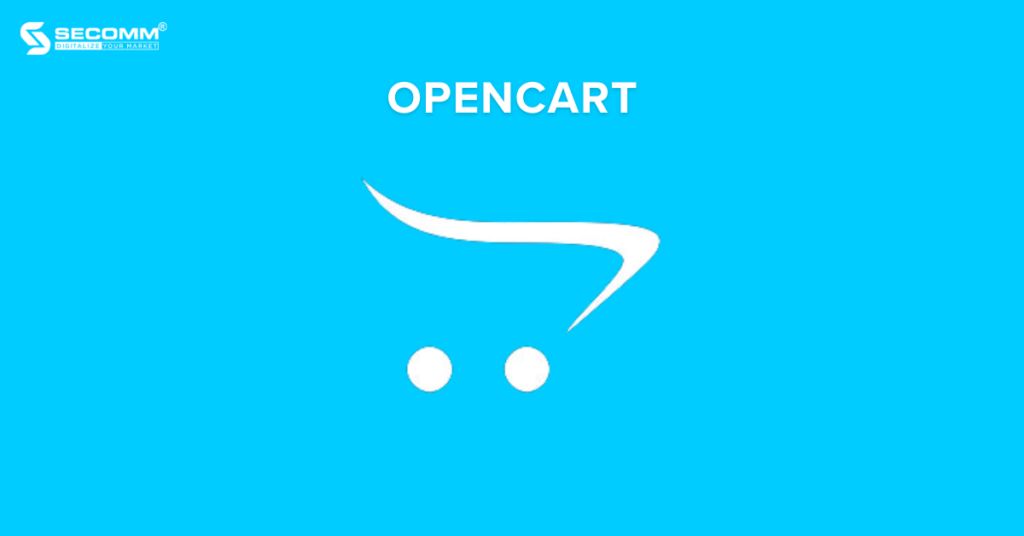
Learn more: Top OpenCart websites
Pros:
Cons:
Core feature:
Pricing:
Free for the Free version. For the Cloud Store version, the specific costs are as follows:
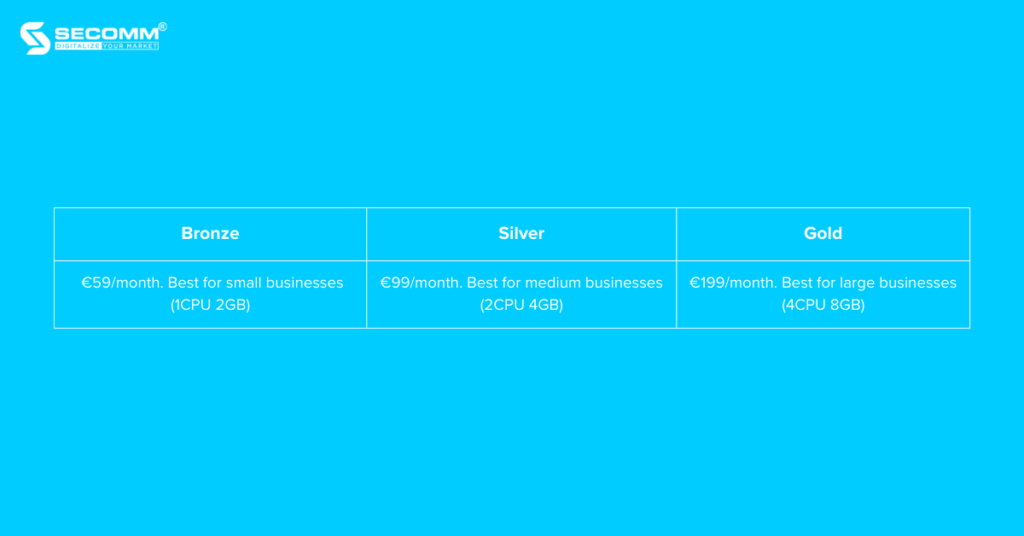
Above are 10 eCommerce platforms preferred by businesses in Australia when establishing their online stores. Each business will make its decision based on factors like scale, business model, and specific deployment requirements.
With over 10 years of experience collaborating with various Australian businesses such as Laybyland, RodShop, Trentham Estate, Jasnor, etc., to build eCommerce websites, SECOMM now possesses a team of highly skilled technical experts and a deep understanding of the Australian market.
For personalized advice on the best-suited platforms for your business, contact us or call the hotline (+84)28 7108 9908 today!
 2
2
 3,714
3,714
 0
0
 1
1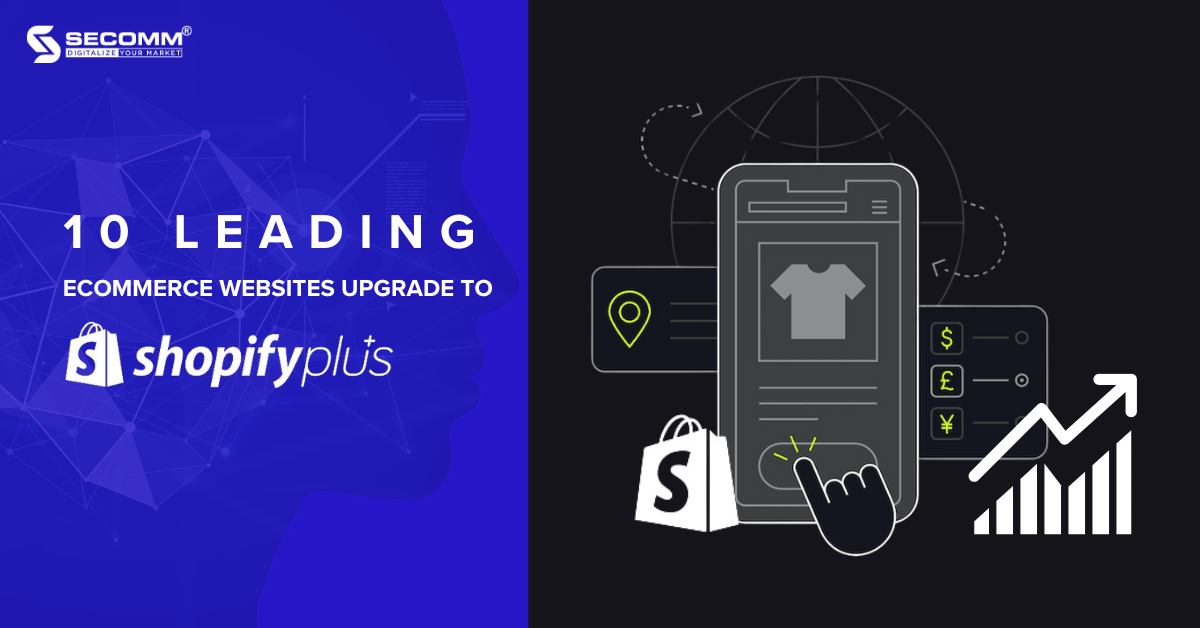
Choosing to upgrade to Shopify Plus is like opening the door for you to enter a world of unparalleled flexibility, speed, and customization. Countless brands across diverse industries and business models heavily rely on Shopify. According to BuiltWith statistics, there are more than 4 million Shopify websites globally. Many well-known brands have experienced remarkable sales and conversion rate surges after upgrading.
Let’s explore 10 eCommerce websites that have upgraded from core Shopify to Plus.
Founded in 2015 by Julian Hearn and James Collier, Huel is a brand specializing in meal replacements and nutritional supplements. Their product lineup includes nutritional powder (Huel Powder), ready-to-drink meals (Huel Ready-to-Drink), snack bars (Huel Bar), and additional supplements like omega-3 oil and protein powder.
After just 5 years, the brand experienced rapid growth, expanding 9 online stores and 120 staff members globally. As a result, the brand opted to upgrade to Shopify Plus to enhance its operational efficiency.
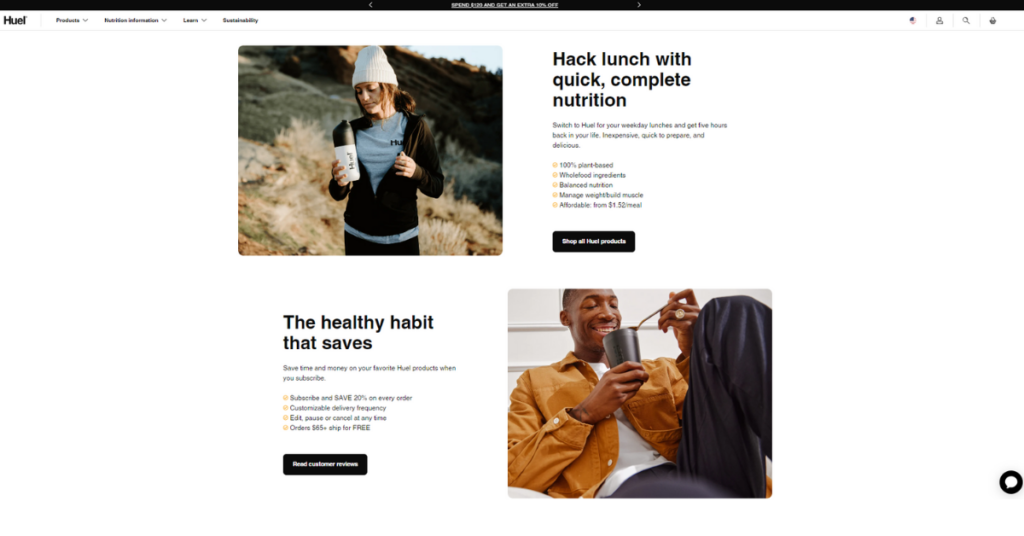
After more than 30 days of replatforming, Huel witnessed significant changes. Tasks such as adding employee accounts and assigning roles across one of the 9 stores, previously taking over 30 minutes, now only require a few minutes.
This not only streamlines the operation of current stores but also creates favorable conditions for Huel to expand and effectively manage an increasing number of stores and personnel in the future.
Negative Underwear was established in 2014 by two sisters, Lauren Schwab and Marissa Vosper. The brand’s mission is to offer women high-quality, straightforward, and comfortable lingerie. Negative Underwear quickly garnered attention for its unique designs and a philosophy focused on the wearer’s comfort and confidence.
From its early days, Negative Underwear built an eCommerce website using Shopify. As sales grew and the need for expansion became apparent, the lingerie brand decided to upgrade to Shopify Plus.

Through Shopify Plus, Negative Underwear benefits from a comprehensive and consistent overview of financial and sales reports. Streamlining operational tasks for centralized inventory management has become more efficient.
Streamlining operational tasks for centralized inventory management has become more efficient. Furthermore, the lingerie brand can effortlessly devise promotional campaigns during significant year-end shopping periods, enhancing the overall customer experience for those seeking to make multiple purchases simultaneously.
ILIA is a popular clean beauty brand that has garnered favor among consumers and earned numerous awards. With a commitment to helping users safeguard and rejuvenate their skin through safe and highly effective formulas, the brand has become a go-to choice.
While initially running on Shopify Advanced, the eCommerce website swiftly expanded, and ILIA upgraded to Shopify Plus for enhanced customization capabilities.

Moreover, through Shopify Plus, ILIA introduced Headless Commerce to ensure customers enjoy an optimal shopping experience without compromising page load speed and overall website performance. The deployment time with Shopify Plus saw a 20% improvement, and since the upgrade, ILIA has observed a notable 18% reduction in bounce rates.
Founded in 2002 by two Italian brothers, Vincent and Brian Wu, Incu swiftly rose to prominence as a leading fashion shopping destination in Sydney. Initially operating on its eCommerce platform, Incu later made the switch to the Basic Shopify.
However, with the company’s expansion and the introduction of a diverse range of products from various international brands, Incu found the need for a more robust backend system to efficiently manage the growing complexity of its eCommerce operations.
This included improving order processing workflows, inventory management, and automated updates for delivery rules and size customization based on customer location.
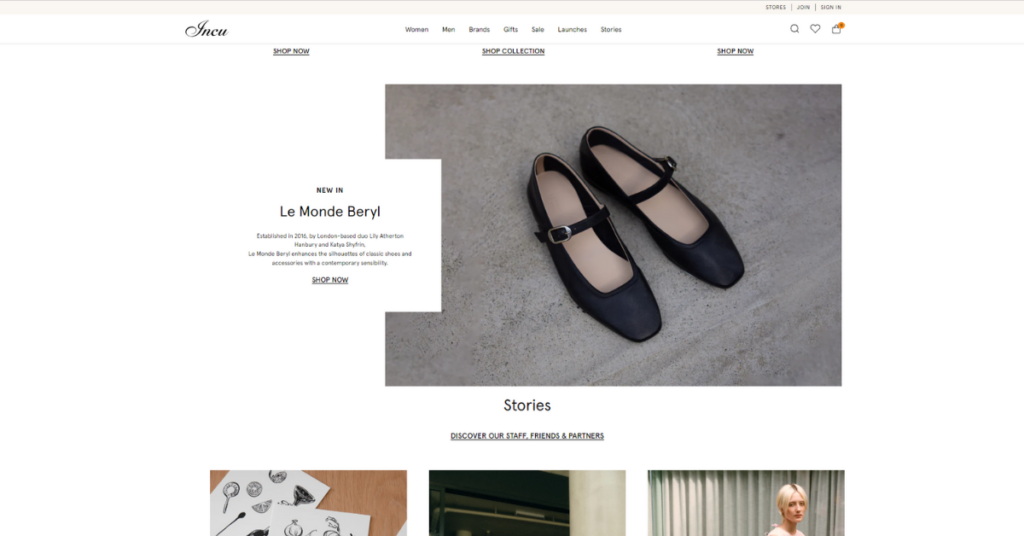
Incu, in particular, integrated advanced solutions from Shopify Plus, including LaunchPad and Flow, and implemented automation and Script Editor to tailor the shopping cart and checkout experience.
In the first week post-upgrade to Shopify Plus, Incu experienced a 15% increase in conversion rates, a 26% rise in revenue, and an average interaction rate of 91%, along with a noteworthy 40% reduction in bounce rates.
Boxraw is a sports fashion brand specializing in boxing, with its main headquarters situated in London, England. Established in 2017 by Ben Amanna, a professional with a background in sports and boxing, the brand aims to deliver high-quality products catering to both novice enthusiasts and professional athletes in the boxing realm.
In its early days, Amanna spent time reading Shopify blogs, building a website with the basic plan, and seeking support from the advisory team to learn about eCommerce and launch his brand.

Particularly noteworthy is Boxraw’s use of LaunchPad, an exclusive solution tailored for Shopify Plus businesses, facilitating the creation of automated sales campaigns.
This has enabled the Boxraw team to break free from repetitive tasks, providing customers with distinctive shopping experiences at enticing prices.
In 2016, Lizzie Carter faced the challenge of finding the perfect towel to dry her naturally curly hair in London. Unable to find one, she decided to take matters into her own hands and create it herself. This led to the creation of Only Curls, which has since become the preferred shopping destination for those with curly hair.
Only Curls primarily offers a range of products, including pre-shampoo treatment oils, post-shampoo treatment oils, hair-fixing gels, and other items specifically designed to support the daily care and styling needs of curly hair.
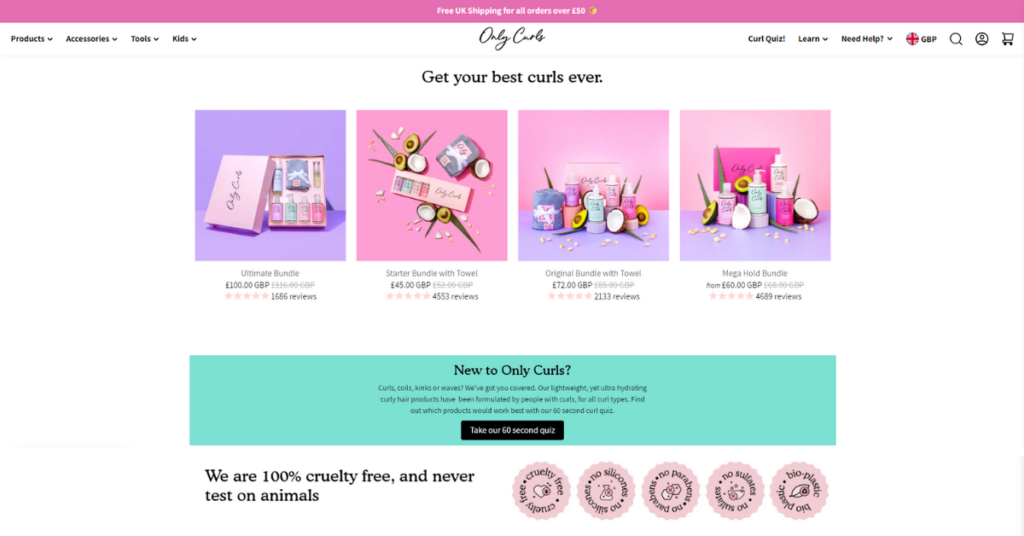
After initially using the basic Shopify package, Only Curls upgraded to the ‘Plus’ package due to the rapid growth of their business. With the upgrade, the brand incorporated LaunchPad and several apps from the Shopify Plus Certified App, such as Klaviyo and Gorgias, to streamline sales, marketing, and customer care processes.
This strategic decision resulted in a 19% increase in conversion rates, a 10% rise in the average order value, and a remarkable 154% surge in the total number of orders in the first month.
Aje is a renowned fashion brand headquartered in Sydney, Australia. After over a decade since its establishment, the brand has rapidly become a significant name in the international fashion industry.
Recognized for its more than 18 stores across Australia and New Zealand, each exuding an air of luxury and contemporary design, Aje aimed to mirror this aesthetic in its eCommerce presence.
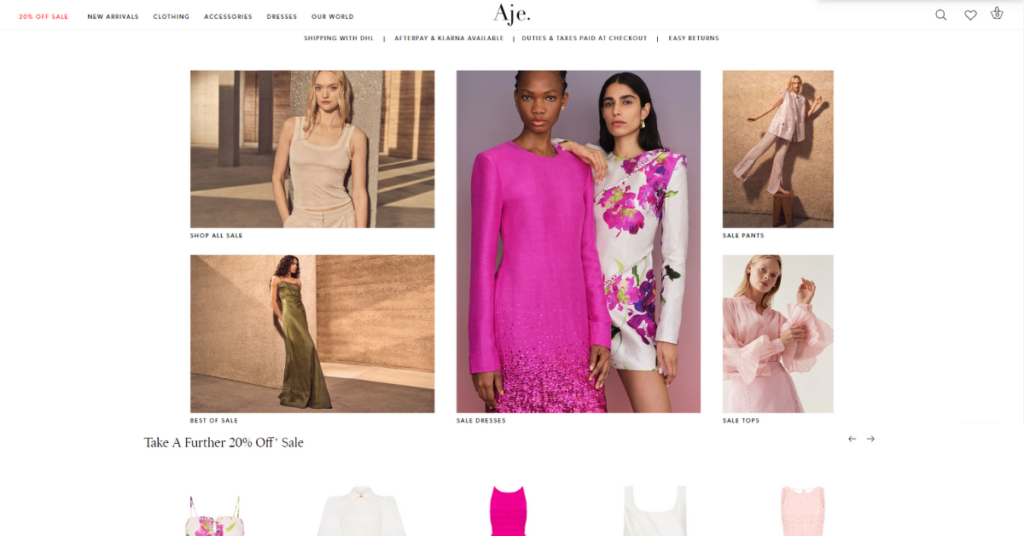
As a result, the brand upgraded to Shopify Plus to efficiently launch a new website with minimal downtime, ensuring a seamless integration of the online and offline customer experiences. Within just a few weeks of the upgrade, Aje observed a remarkable 135% increase in its conversion rate and a substantial decrease in bounce rates.
Founded in 2008 and headquartered in California, USA, Animals Matter stands as a premier brand in the realm of luxurious pet accessories. Specializing in crafting high-end products for pets, including beds, cushions, coats, collars, and more, Animals Matter prioritizes the comfort, safety, and fashionable flair of beloved pets.
Initially, Animals Matter opted for Shopify to establish a foundational eCommerce website, complemented by the strategic use of Google Ads. As sales began to climb, the brand decided to elevate its platform to the ‘Plus’ version, granting access to exclusive and advanced solutions.
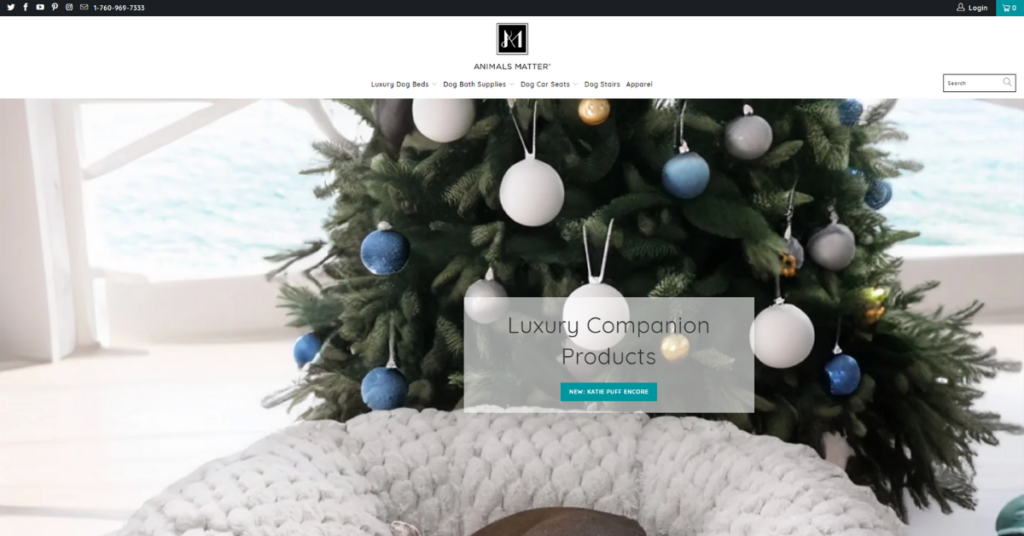
With a strategic focus on a Direct-to-Consumer (D2C) model and a commitment to multi-channel sales, Animals Matter seamlessly integrated its website with various social media platforms like Facebook, Instagram, Youtube, and Pinterest.
Moreover, utilizing the capabilities of ‘Plus,’ the brand employs email marketing to sustain customer engagement through diverse approaches. This includes the implementation of strategies such as abandoned cart emails, newsletters, and enticing promotional programs.
Boie, headquartered in New York, USA, is a personal care product brand that prioritizes safety and durability in its meticulously researched and crafted offerings. Boie’s products are crafted from antibacterial and recyclable materials, emphasizing a commitment to minimizing waste generation in the market.
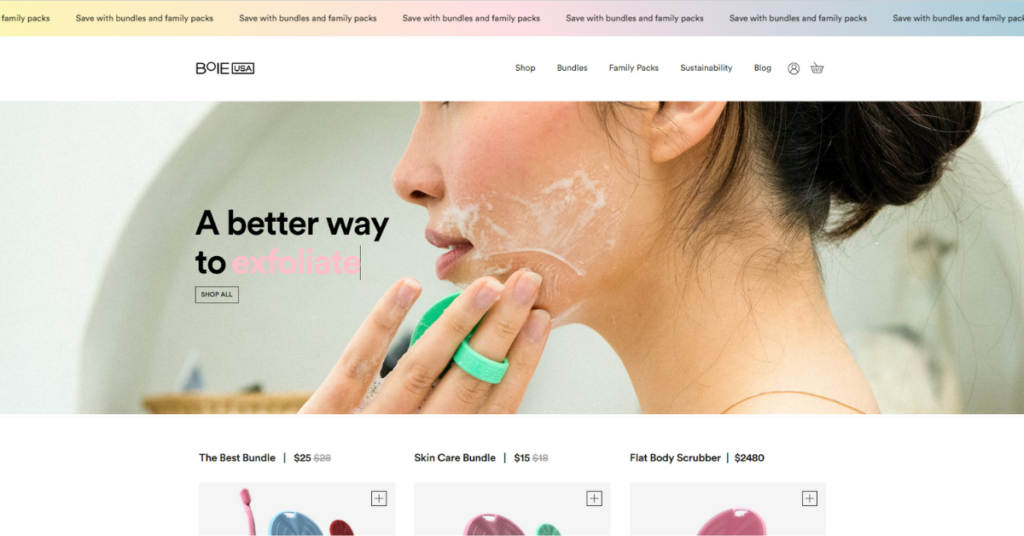
Recognizing the limitations of the basic Shopify solution in fulfilling its vision for an enriched eCommerce website user experience, Boie made the strategic move to upgrade to Shopify Plus. This flexible platform serves as a solution to address two key objectives for Boie: enhancing conversion rates, particularly for customers abandoning their carts, and optimizing SEO strategies to boost website traffic.
A prominent player in the personal care product market is al.ive body. This brand emerged amid Australia’s Covid-19-induced lockdown.
With prior success using Shopify, al.ive body decided to elevate its e-commerce website by switching to Shopify Plus, where it benefitted from valuable guidance and support from the Merchant Success team.
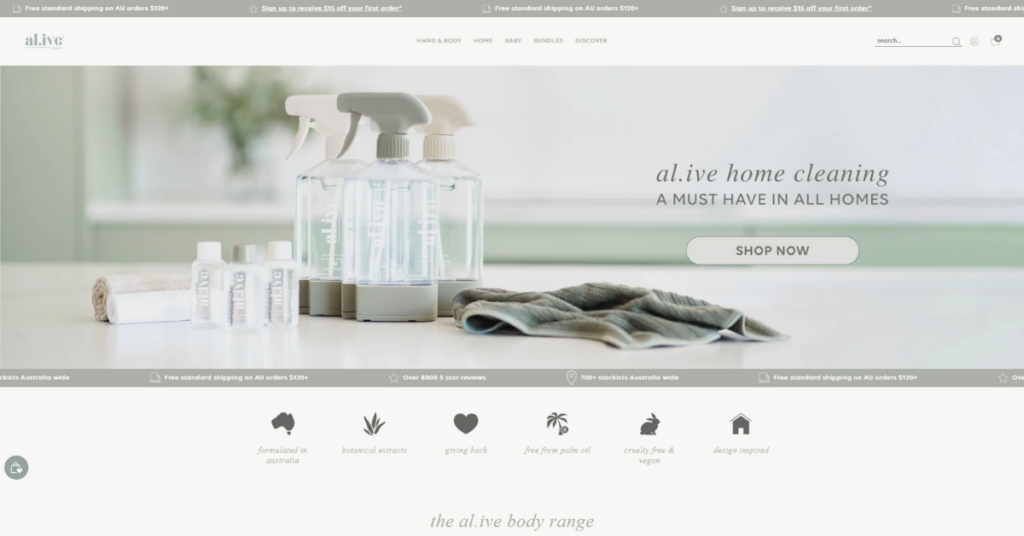
Leveraging the expansive features of ‘Plus,’ al.ive body introduced a dedicated B2B eCommerce website catering to wholesale customers. Moreover, the brand employed the Functions solution to tailor the backend logic of Shopify, enhancing the customer experience, and streamlining the payment process.
Since upgrading, the company achieved over 1 million Australian dollars in revenue within four days of the Black Friday sales event. Taking advantage of the increased customer influx during the sales period, al.ive body boosted its customer conversion rate by 47% after implementing customizations aimed at simplifying the payment experience.
Above are 10 brands that have enhanced their eCommerce websites by upgrading from the core Shopify versions to the Plus version, seeking advanced solutions to streamline business processes and improve the customer experience.
As a trusted partner for enterprises like Vinamilk, Suzuverse, SECOMM boasts a highly skilled technical team with profound knowledge of Shopify Plus.
Contact SECOMM or call the hotline to start upgrading your eCommerce website today!
 2
2
 4,342
4,342
 0
0
 1
1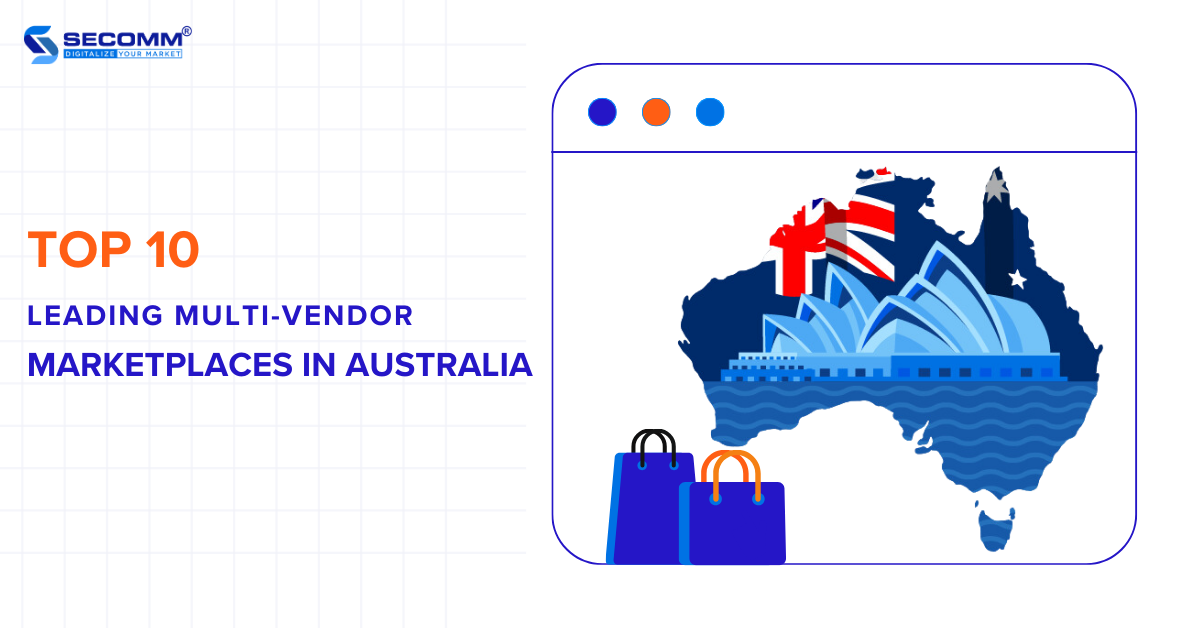
The eCommerce industry in Australia has experienced continual growth in recent years. Consumers are increasingly inclined to prioritize online shopping platforms for their diverse product offerings, convenience, and cost-effectiveness.
Here are 10 widely popular multi-vendor marketplaces that serve as favored shopping destinations for Australian consumers.
Learn more: Building your first multi-vendor marketplace with Marketplacer
In late 2017, Amazon officially launched its operations in Australia, marking the establishment of Amazon Australia. Much like in many other countries, Amazon Australia provides a diverse array of products, spanning fashion, electronics, home goods, books, toys, and electronic appliances sourced from various sellers.
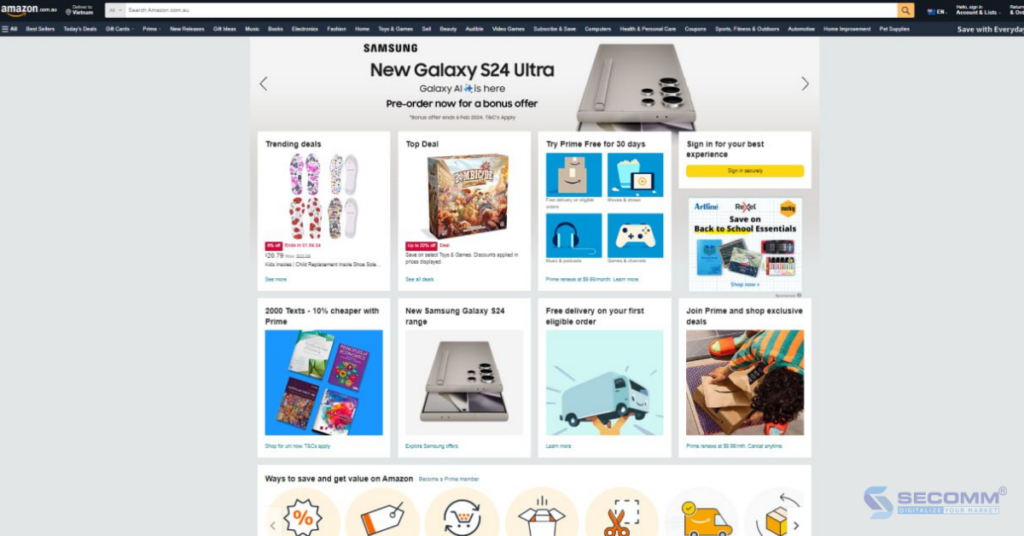
Beyond product sales, this retail behemoth also offers services such as Amazon Prime and Amazon Fresh, featuring expedited delivery policies and exclusive perks for members. Over the years, Amazon has solidified its position in the Australian eCommerce market, delivering a plethora of choices and a comprehensive online shopping experience for customers in the country.
Unlike Amazon, the retail giant eBay has been present in the Australian market since the early years of eBay’s global expansion. eBay has created an online marketplace that allows both individual sellers and businesses to sell their products. On this eCommerce platform, customers can find everything from fashion, electronics, and home goods to toys, decorations, and much more.
Currently, eBay is also a dominant player in the eCommerce market in the Australia and New Zealand region, alongside Amazon. This is due to offering customers an optimal shopping experience with various promotions and attractive deals throughout the year.
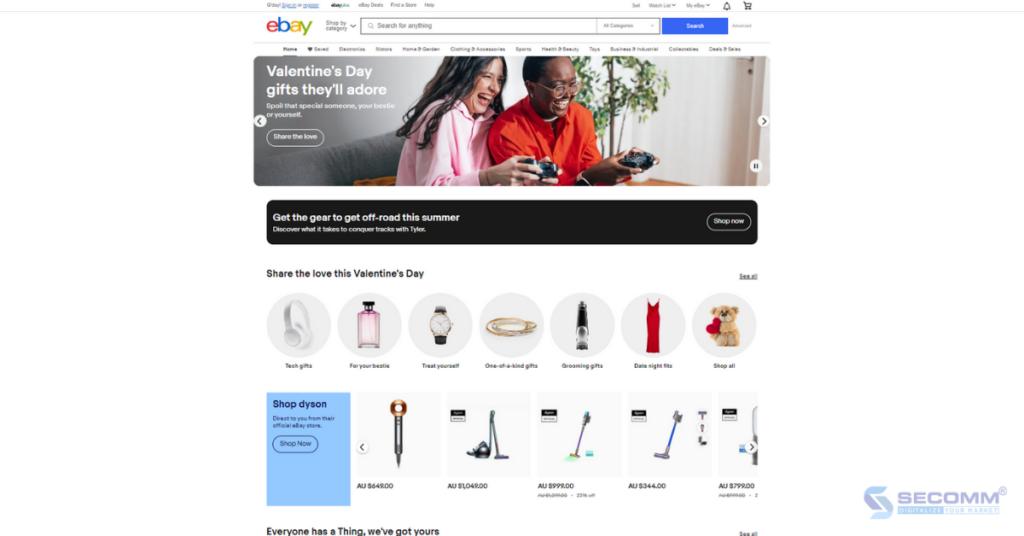
The Kmart multi-vendor marketplace started its operations in Australia in 1960 and has since evolved into one of the country’s most popular retail chains. The Kmart company is a part of the Wesfarmers group. The products offered by this Australian online marketplace are diverse, including electronics, household goods, furniture, cosmetics, and fashion.
Kmart is renowned for its cost-effective pricing strategy, making its products and services accessible and convenient for a diverse customer base. Alongside its website, Kmart provides a well-designed mobile app with features that facilitate convenient shopping for customers wherever and whenever they choose.
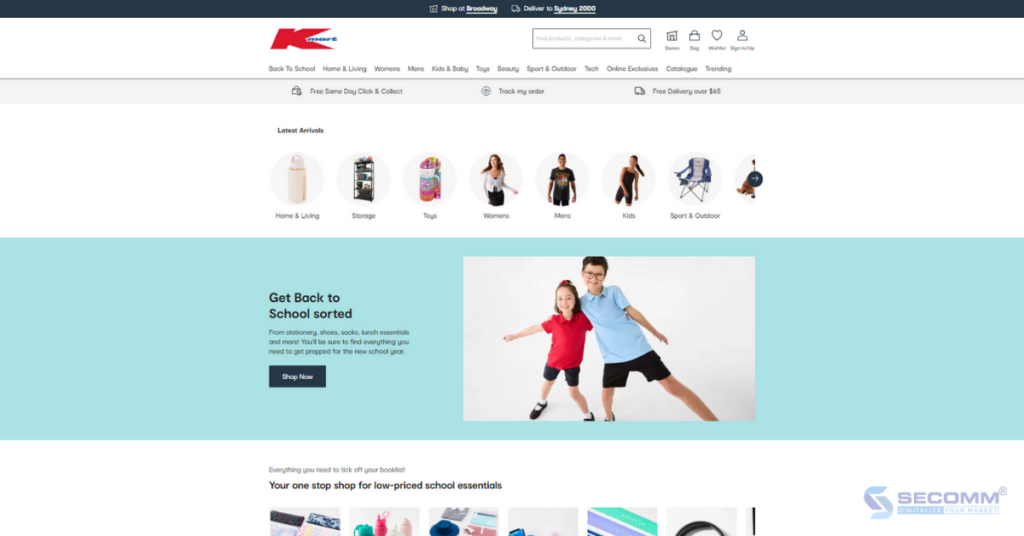
Myer has a long history, established in 1900 by Sidney Myer in Melbourne, Australia. Since then, Myer has grown into one of the major names in the retail industry in Australia. The Myer multi-vendor marketplace is built with modern technologies that make it easy to expand according to business needs. Additionally, advanced features can be developed and customized effectively to provide an exciting and optimal shopping experience for customers.
In addition to an extensive product portfolio, Myer has introduced a loyalty program called Myer One, allowing customers to collect points through shopping and redeem them for equivalent value rewards. This not only helps retain existing customers but also attracts more potential customers, making Myer one of the leading online marketplaces in the land Down Under.
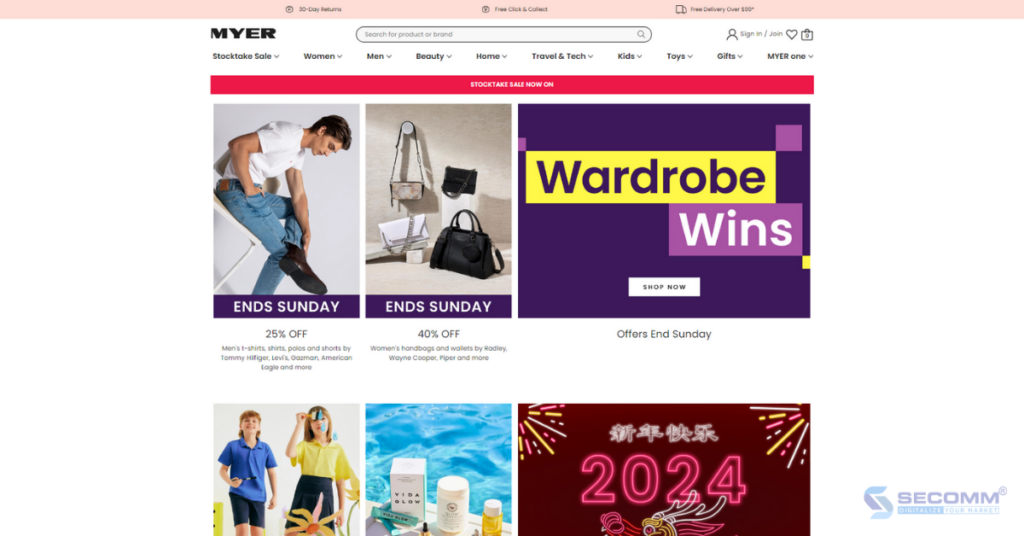
Big W is a part of the prominent retail group Wesfarmers, established in 1964. Over the years, Big W has evolved into one of Australia’s major and well-loved retail chains. In addition to showcasing products from renowned brands, Big W also offers a diverse range of in-house branded items, elevating its competitive edge and delivering significant value to customers.
Beyond its traditional brick-and-mortar stores scattered across Australia, Big W’s online marketplace features a user-friendly website and a mobile app for seamless online shopping at any time and from any location. Big W consistently rolls out enticing promotions and appealing deals, leveraging email marketing to engage with customers, ultimately driving up conversion rates and overall sales.
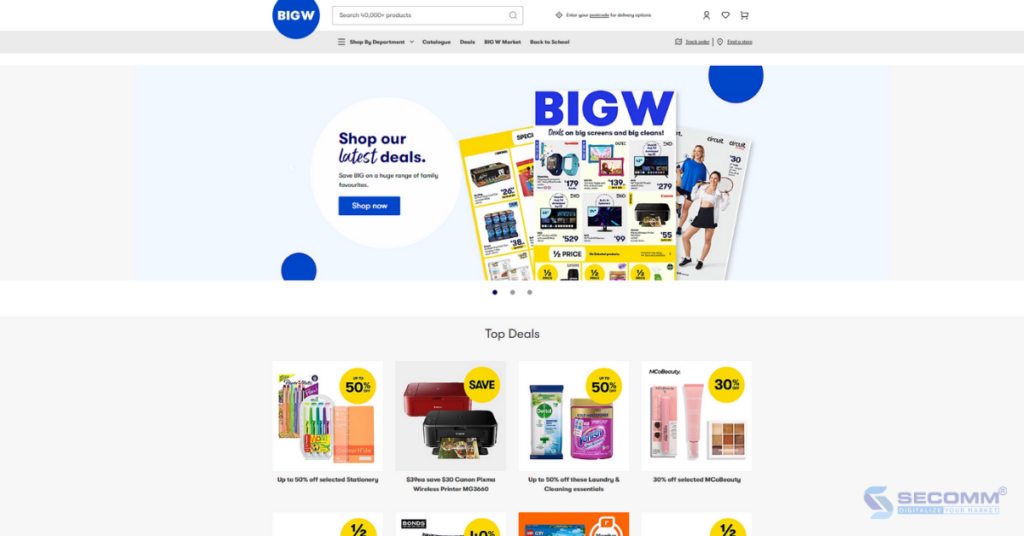
Target is known as the retail giant in the United States, specializing in providing products across various sectors. In the Australian market, Target is also popular and serves as a shopping destination for items such as fashion, furniture, gifts, and more.
Through monthly promotional programs and offers, Target has successfully attracted numerous new customers while maintaining relationships with its existing customer base.
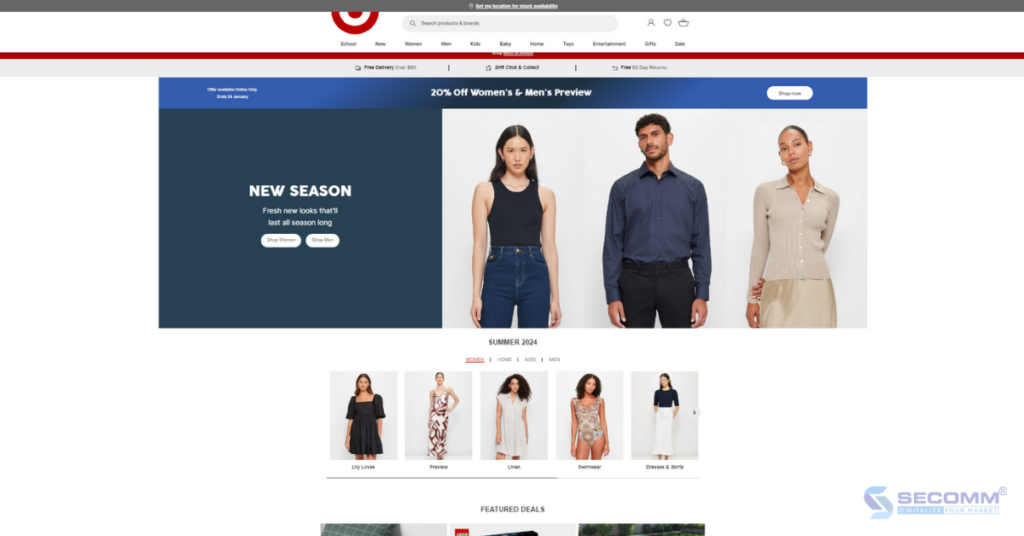
Catch, formerly known as Catch of the Day, is an Australian multi-vendor marketplace well-known for providing substantial deals and discounts across a diverse range of product categories. The online marketplace has introduced a loyalty program named Catch Club, offering members a points-based shopping system for exclusive rewards and special items.
In addition, Catch prioritizes customer service, offering various support channels such as chat, hotline, and email to ensure customers can easily access and seek prompt assistance.
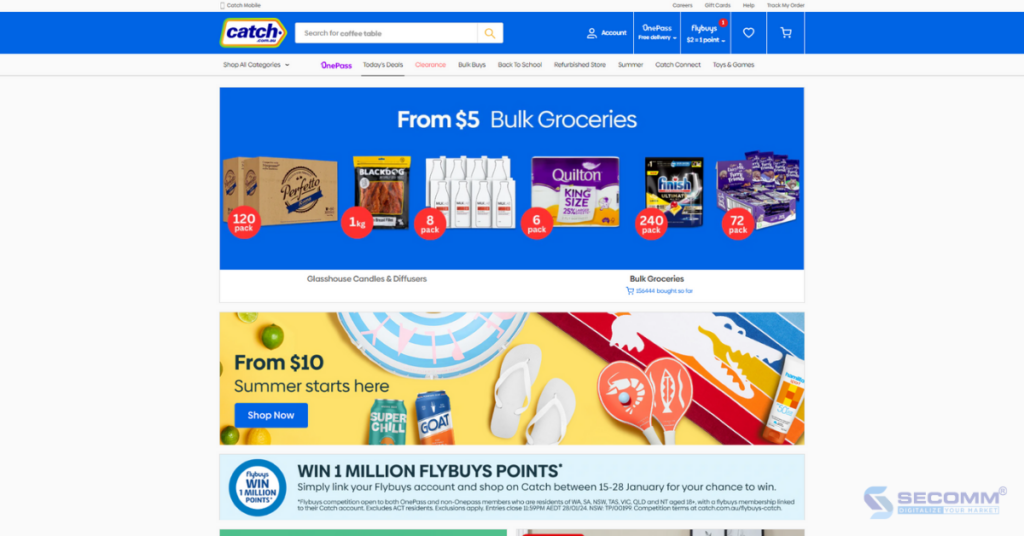
Kogan, headquartered in Australia, is well-known for delivering products and services at competitive prices. Established by Ruslan Kogan in 2006 in Melbourne, Australia, this multi-vendor marketplace initially focused on selling consumer electronics on its website, subsequently diversifying into multiple categories.
Through sensible policies, Kogan has established a fair online marketplace, enabling both businesses and individual sellers to engage in selling, offering buyers an extensive array of options.
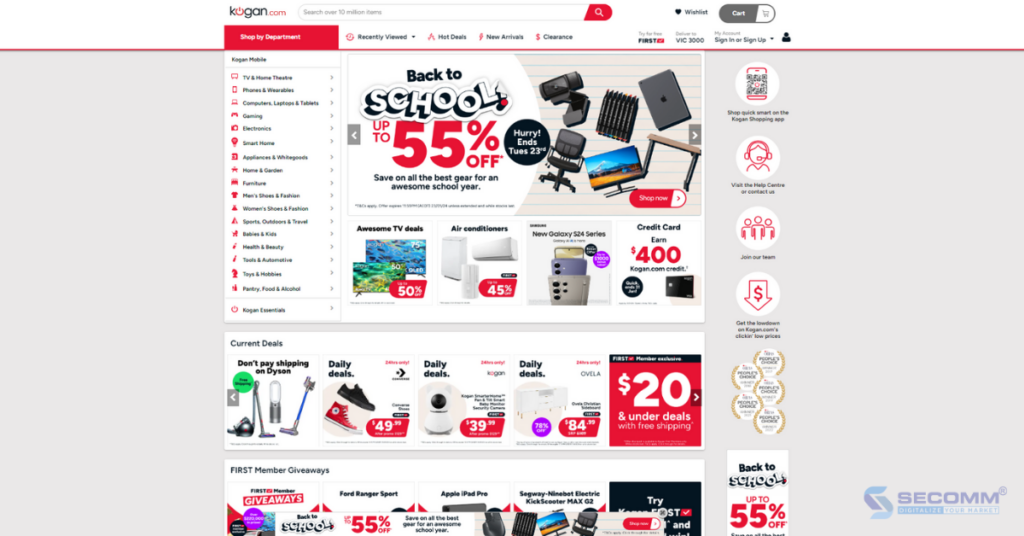
The multi-vendor marketplace MyDeal was established in 2011 in Melbourne, Australia. MyDeal originated as a website specializing in providing discount codes and shopping coupons.
MyDeal offers a diverse range of products, including fashion, household items, electronics, toys, furniture, and many other categories. They continually expand their product offerings to meet consumer needs.
MyDeal regularly creates flash sales, special discounts, and promotional programs to attract customers. With its diversity and attractive discounts, MyDeal has drawn in many consumers in Australia, becoming one of the most popular online marketplaces in the country.
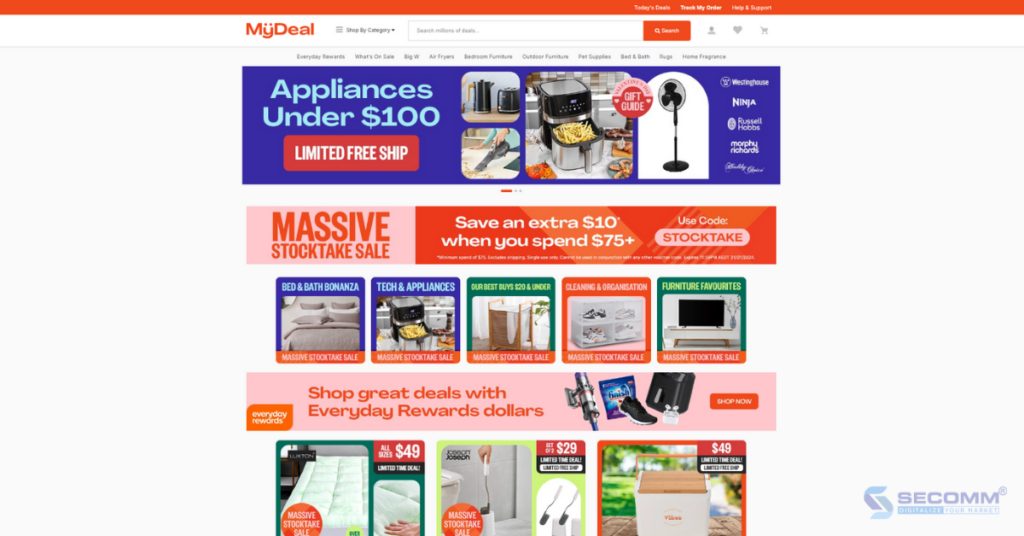
Formerly known as an Australian eCommerce website specializing in consumer electronics, Laybyland has transitioned its business model to become a multi-vendor marketplace. This shift allows numerous individual sellers and businesses to participate in selling their products on the platform, providing buyers with affordable pricing and diverse choices.
Laybyland and SECOMM have been partners for over 10 years, collaborating on various successful eCommerce projects, including the recent Laybyland multi-vendor marketplace. The project primarily utilizes two platforms, Marketplacer and Magento 2, to enhance operational efficiency and optimize the customer user experience.
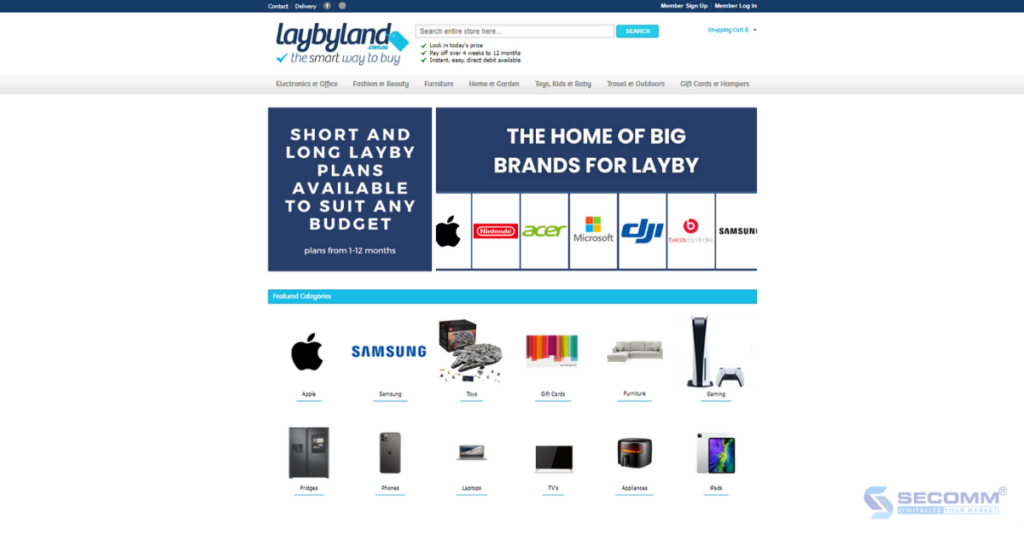
Learn more: The project of Laybyland
Above are the 10 most popular multi-vendor marketplaces in Australia, serving as the ideal online shopping destinations for local consumers.
The eCommerce industry in Australia has witnessed significant growth, with not just the mentioned 10 brands but also numerous other Australian businesses successfully implementing efficient platforms, attracting a wide customer base, and experiencing continuous growth.
If your business is still contemplating whether to establish a multi-vendor marketplace in Australia and how to go about it, feel free to contact or call our hotline at (+84)28 7108 9908 right now!
 2
2
 3,831
3,831
 0
0
 1
1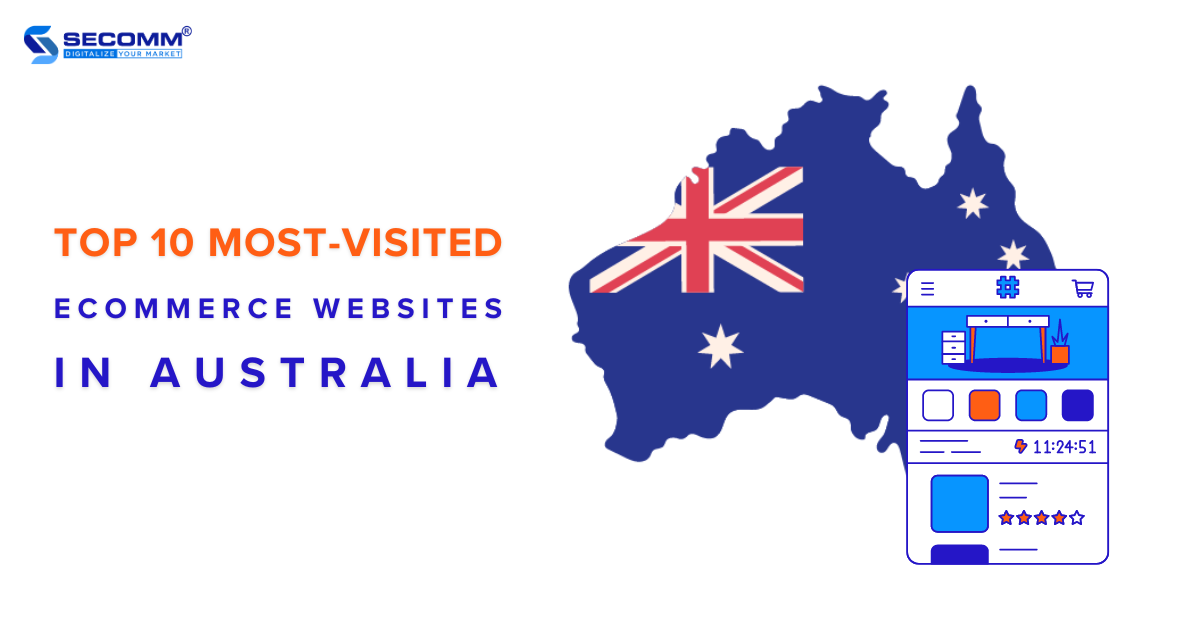
In Australia, shopping on eCommerce websites has become an essential trend. Over time, there has been a growing demand for an enhanced online shopping experience among Australian customers. This requires businesses to seek solutions to optimize their websites to provide a unique and efficient customer experience.
Here are 10 leading Australian brands dedicated meticulous efforts to refining the eCommerce experience, thereby gaining customer satisfaction and trust.
JB Hi-Fi is a retail chain headquartered in Australia, specializing in electronics, household goods, and entertainment products. It was founded in 1974 in Melbourne by John Barbuto (JB) and his wife, Judy Barbuto (the JB Hi-Fi name is a combination of the initials of John’s name and Judy’s name).
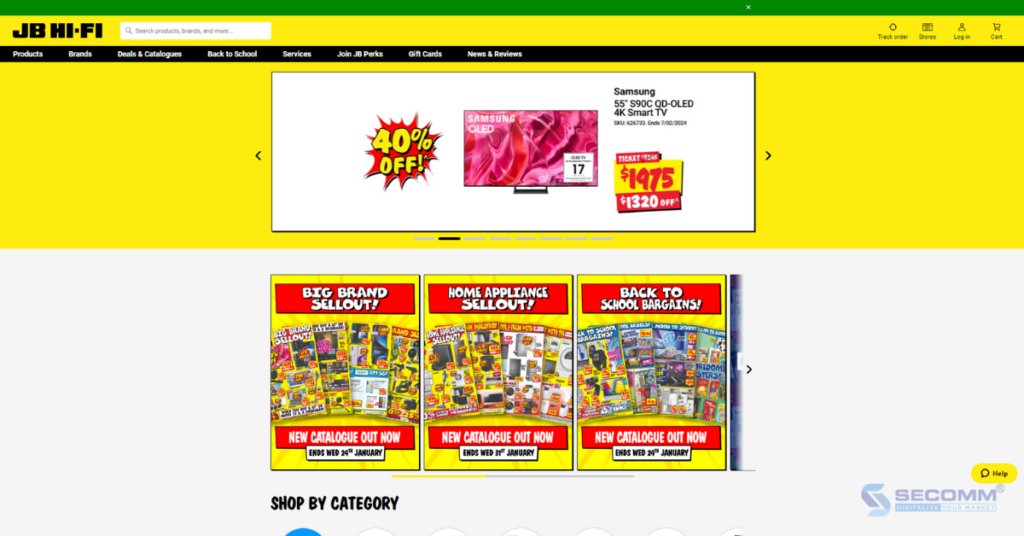
Alongside its brick-and-mortar stores in Australia and New Zealand, the brand also maintains an eCommerce website and a mobile app. These two primary channels enable customers to shop online and stay updated on various offers and promotions.
Beyond offering a diverse range of high-quality consumer electronics, JB Hi-Fi places a strong emphasis on providing customer support services both online and offline, aiming to deliver the optimal customer shopping experience.
Coles is a leading supermarket and retail chain in Australia. Established in 1914, the brand has since experienced impressive expansion and development, emerging as one of the major names in the Australian retail industry.
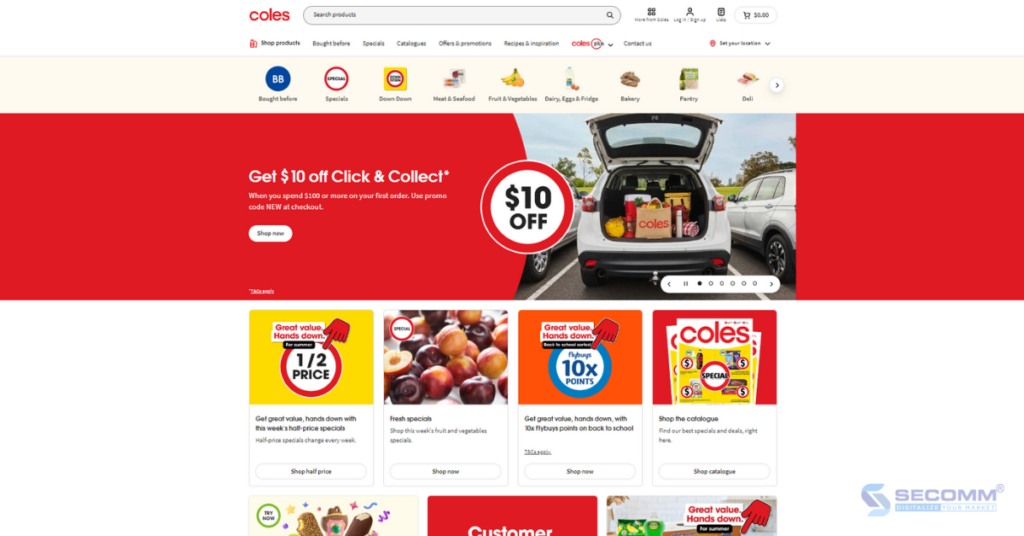
Coles offers online shopping services through its user-friendly eCommerce website and mobile app. The Australian brand also ensures competitive pricing and consistently introduces promotional initiatives, providing customers with a diverse array of options.
The ICONIC is an Australian eCommerce website specializing in fashion and footwear. Established in 2011, the brand swiftly captured attention, evolving into a premier online shopping destination for fashion enthusiasts in both Australia and New Zealand.
At The ICONIC, customers can easily discover their preferred products from a diverse selection of globally renowned brands, including Levi’s, Adidas, Lacoste, Polo Ralph Lauren, and more.
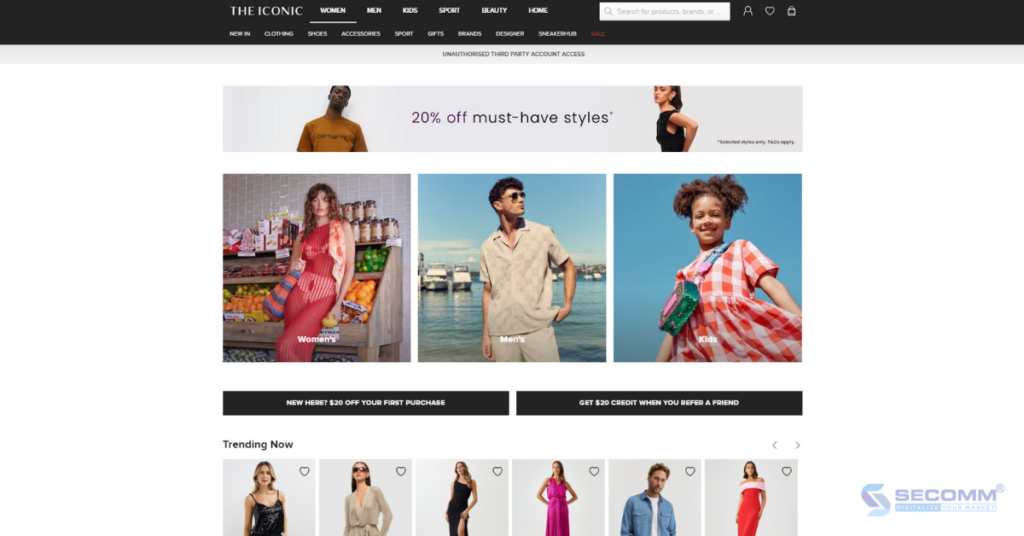
The ICONIC’s website is optimized to help customers browse products, place orders, and track their shipments effortlessly. Beyond providing a unique online shopping experience, The ICONIC regularly updates fashion trends and offers informative content for its customers.
Cotton On was established in 1991 by Nigel Austin in Geelong, Australia. The brand offers a wide range of fashion products, including clothing for men, women, and children, footwear, accessories, underwear, and even home goods and interior decorations in some stores.

Cotton On has an extensive network of stores worldwide, with a presence not only in Australia but also in many other countries such as the United States, Canada, the United Kingdom, and various Asian countries. Therefore, an eCommerce website system has been built and developed with Salesforce Commerce Cloud (SFCC) to cater to the specific needs of each customer segment in different markets.
Sephora is a leading global retail chain specializing in cosmetics and beauty products. The brand is headquartered in Paris, France, and has expanded rapidly, establishing its presence in numerous countries across Europe, North America, Asia, and the Middle East.
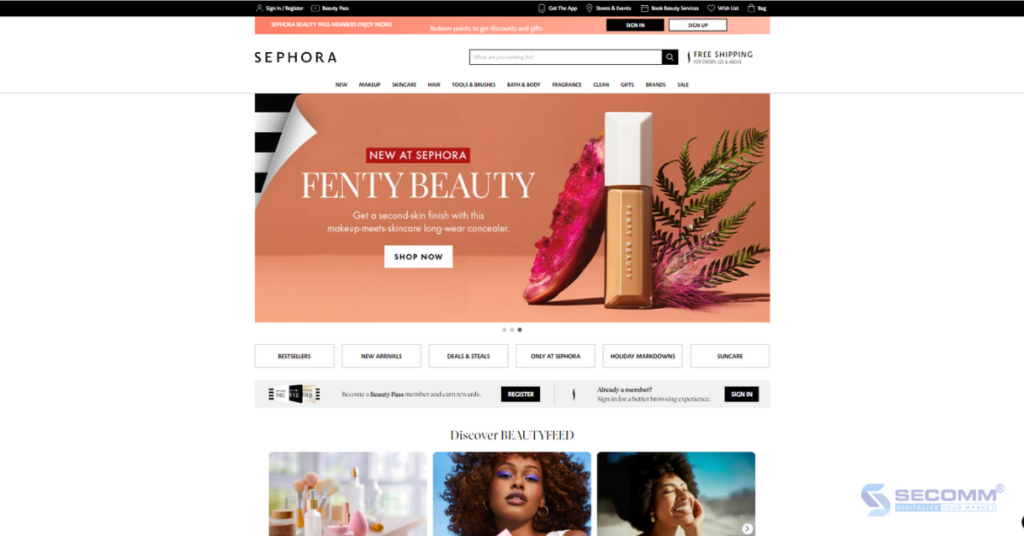
In Australia, Sephora is recognized as a go-to destination for purchasing cosmetics, both online and in-store. Sephora’s eCommerce website and mobile app boast various specialized features designed to elevate the customer experience. Moreover, the successful implementation of a loyalty program by Sephora across multiple markets serves as a valuable lesson for many other eCommerce enterprises.
Founded in Australia in 2006, Forever New is an international fashion brand that specializes in designing and manufacturing women’s fashion collections. The brand is renowned for offering customers products with a sophisticated and feminine style.
Since its inception, Forever New has experienced rapid growth and expanded its business not only in Australia but also in various other countries, including New Zealand, China, India, South Africa, and numerous European nations.
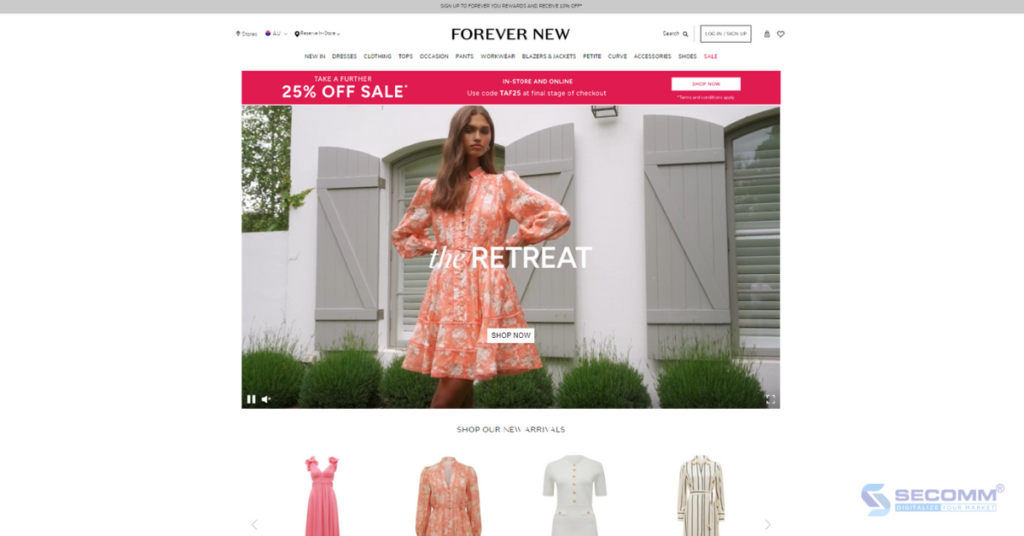
To meet the challenges of expansion and customization, Forever New opted for Magento Open Source to build its eCommerce system. Leveraging Magento, the brand has incorporated a range of advanced and specialized features alongside essential functionalities to enhance the online shopping experience for its customers.
Dick Smith is the name of a renowned Australian entrepreneur, Richard “Dick” Smith, who founded this brand in 1968. In its early years, Dick Smith focused on providing electronic products and components.
The brand quickly grew and expanded its product portfolio from electronic appliances, computers, mobile phones, cameras, and tech toys to other technology and entertainment-related products.
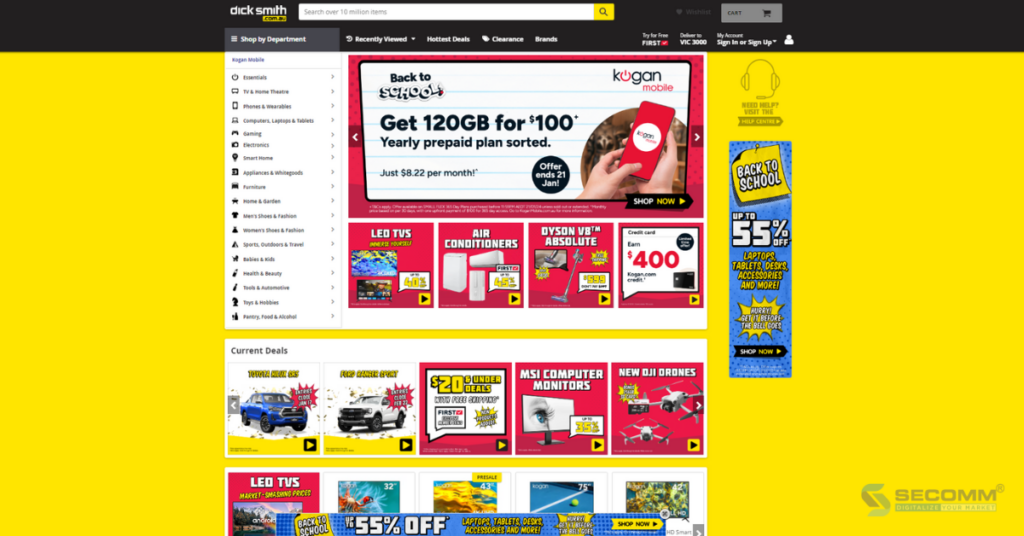
Dick Smith’s eCommerce website is built on the Magento platform. This has helped Dick Smith enhance its presence in both online retail and traditional retail stores, allowing the brand to reach a large audience through an optimized shopping experience.
Bed Bath N’ Table is a well-known brand specializing in furniture, home decor, and household items in Australia.
Its eCommerce website offers a diverse array of products for the living room, bathroom, dining area, and bedroom. Customers can easily discover items such as blankets, pillows, bedding sets, decorations, lamps, cookware, tableware, and numerous other products.
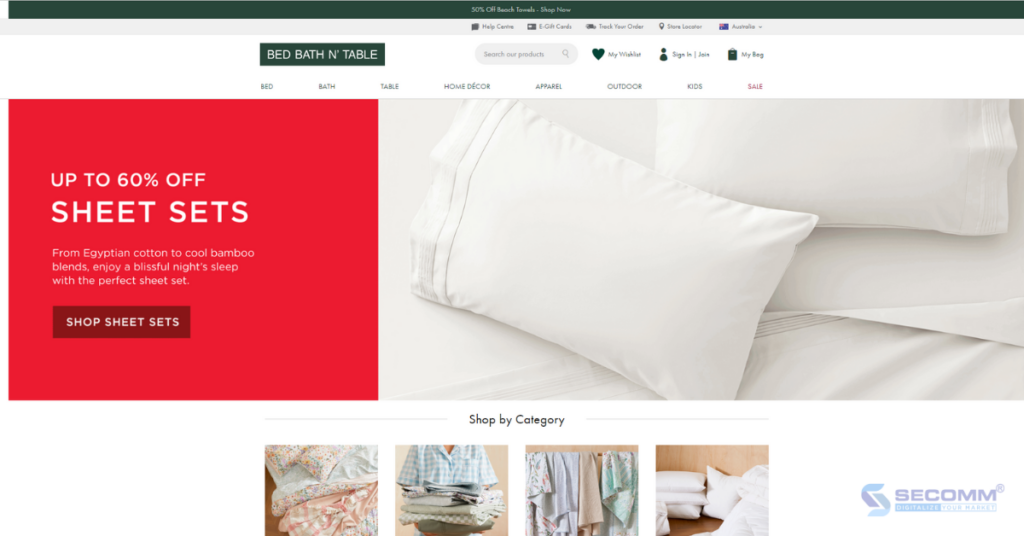
In addition, Bed Bath N’ Table provides various payment methods and implements a loyalty program to enhance the shopping experience for customers, ultimately boosting conversion rates and sales.
Over the years, through a commitment to professionalism and prioritizing customer experience, Bed Bath N’ Table has solidified its presence throughout the regions of Australia and New Zealand.
Established in 1990, Glue Store is an Australian fashion retail chain specializing in products from popular brands, especially those favored by the youth. Over the years, Glue Store has swiftly expanded to become a go-to fashion shopping destination in the Australia and New Zealand region.
Currently, Glue Store collaborates with a variety of renowned brands, including Adidas, Nike, Tommy Hilfiger, Calvin Klein, Puma, and various streetwear labels.
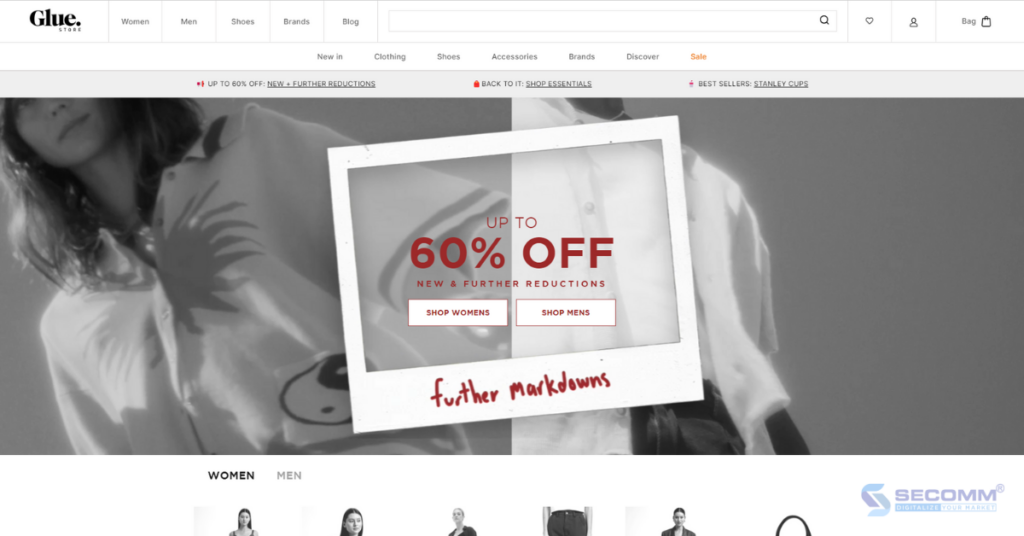
In addition to its traditional store chain, Glue Store offers customers an online shopping experience through an eCommerce website built on the Shopify platform. The website boasts a uniquely designed interface with advanced features, particularly enhancing the customer experience, notably during the checkout process.
Furthermore, Glue Store consistently introduces appealing promotional programs to attract and retain its customer base.
The eCommerce website Chemist Direct has become quite familiar to Australian consumers in recent years. It is a reliable destination for purchasing beauty products, personal care items, prescription and non-prescription medications, as well as medical equipment.
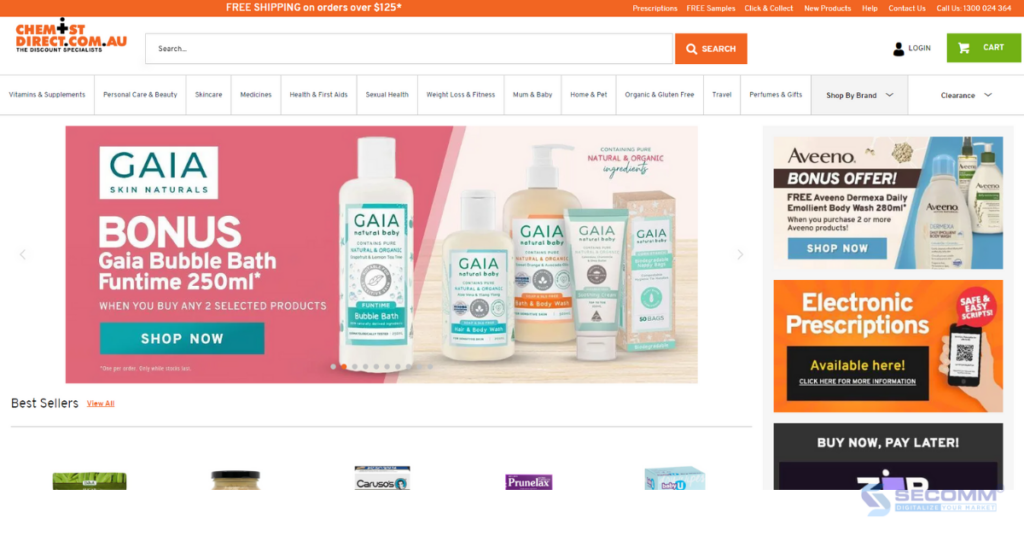
With a diverse and extensive product catalog, Chemist Direct has developed its eCommerce system on Magento to leverage the flexibility and easy scalability of this platform. Through Magento, the Chemist Direct team can easily develop and customize numerous advanced features, making searching, browsing, ordering, and payment more straightforward.
When it comes to payments, the brand implements Buy Now Pay Later with Afterpay and Zip, alongside traditional payment methods, allowing customers additional choices and flexibility when making purchases.
Here are the leading 10 eCommerce websites in Australia. Utilizing advanced platforms like Magento, Shopify, and SFCC, these brands have delivered an optimal online shopping experience, successfully attracting both local and international consumers.
Throughout years of growth, SECOMM, in collaboration with numerous Australian clients, has proudly contributed to the creation of exceptional eCommerce websites. Noteworthy projects include partnerships with Laybyland, Jasnor, Rod Shop, and others.
Contact SECOMM or call directly at the hotline (+84)28 7108 9908 to get started!
 2
2
 5,257
5,257
 0
0
 1
1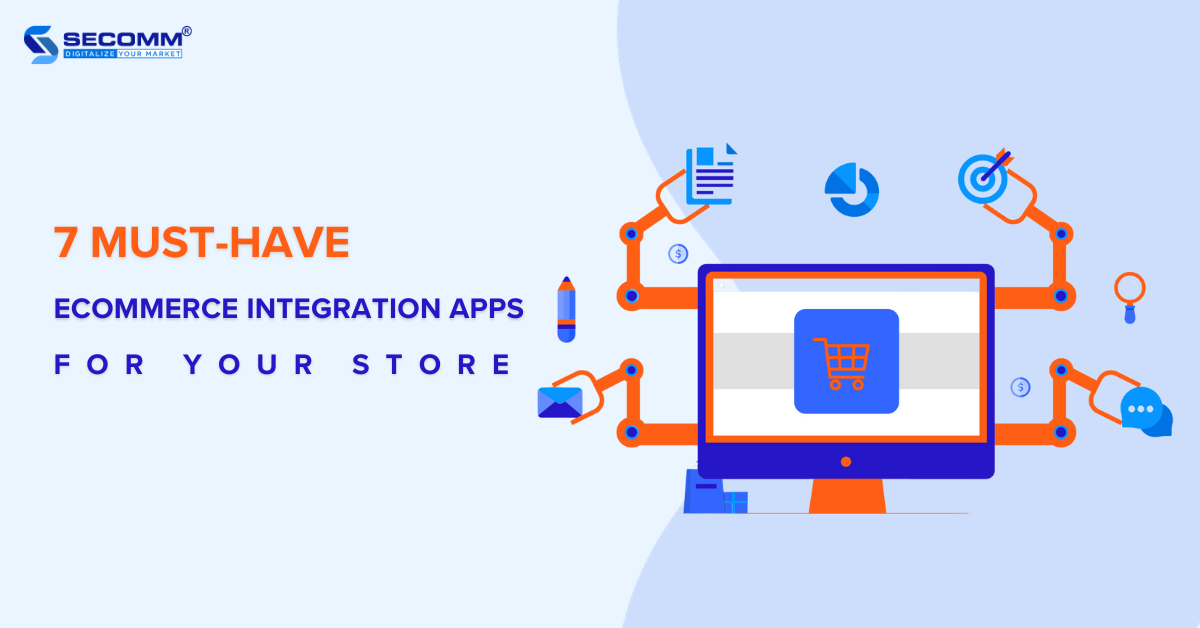
Several crucial factors impact the efficiency of running an online store. Among these, effectively implementing eCommerce integrations plays a key role in helping you streamline your operations and reduce risks.
Below are 7 essential integrations that you should include in your eCommerce website.
PIM (Product Information Management) is one of the common eCommerce integrations. The PIM system is used to collect, organize, and manage product information, including details such as product descriptions, images, prices, product attributes, customer reviews, and ratings.
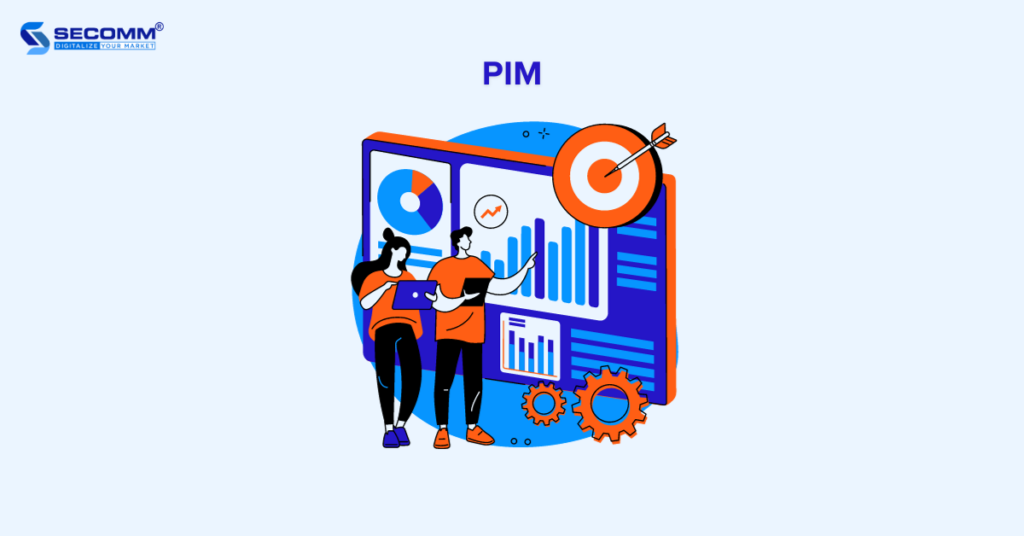
This tool helps you manage product information across diverse platforms, making it easier for customers to choose their desired products. Plus, PIM helps you save time compared to manual data entry, thereby reducing personnel costs.
Take Akeneo PIM, for instance; it is an open-source platform tailored for managing product information effectively. Akeneo is also flexible enough to seamlessly integrate with various systems such as ERP, CRM, POS, and popular eCommerce platforms like Magento, Shopify, and WooCommerce.
Currently, Akeneo offers three main PIM plans, including:
The Order Management System (OMS) helps you process orders in various channels.
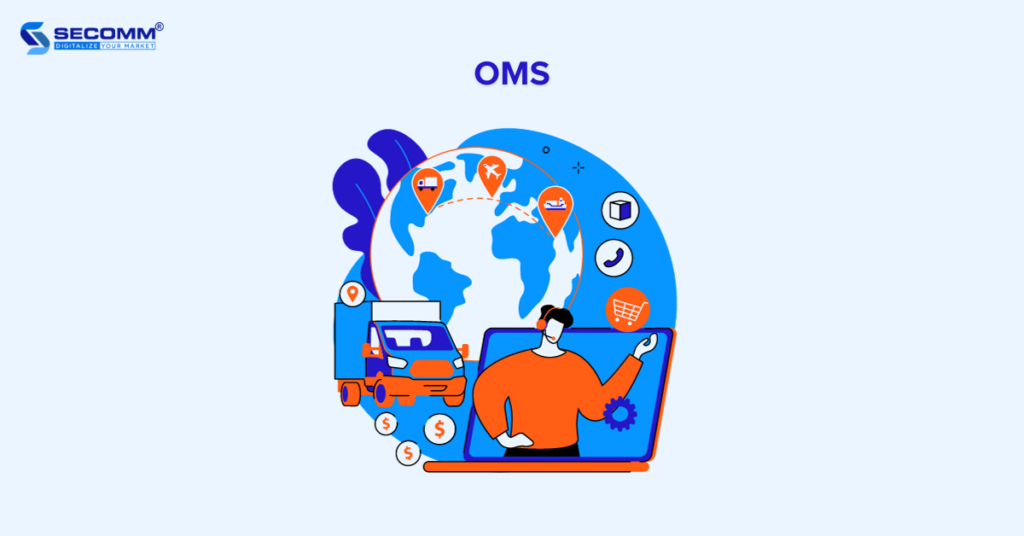
This eCommerce integration not only helps businesses efficiently manage orders, optimizing the customer experience, but also collects and analyzes data at peak and off-peak sales times, as well as for specific orders, top-selling items, and consumer behavior.
So, you’ll easily adjust their business strategies and manage inventory effectively.
For example, Fabric OMS is a Distributed Order Management (DOM) system designed to help you streamline the order processing process, including online purchases at the store (BOPIS), delivery to the store, and in-store order fulfillment.
Fabric’s order management solution helps you integrate and manage the entire order process on a single interface. You can optimize your order processing, minimize inventory discrepancies, and free up resources for other important tasks.
The Warehouse Management System (WMS) will help you manage the flow of goods, inventory, and shipping to facilitate sales and order fulfillment.
By automating order processing and optimizing the layout of goods in the warehouse, WMS accelerates order processing, reduces order preparation time, and enhances the ability to quickly respond to customer demands.
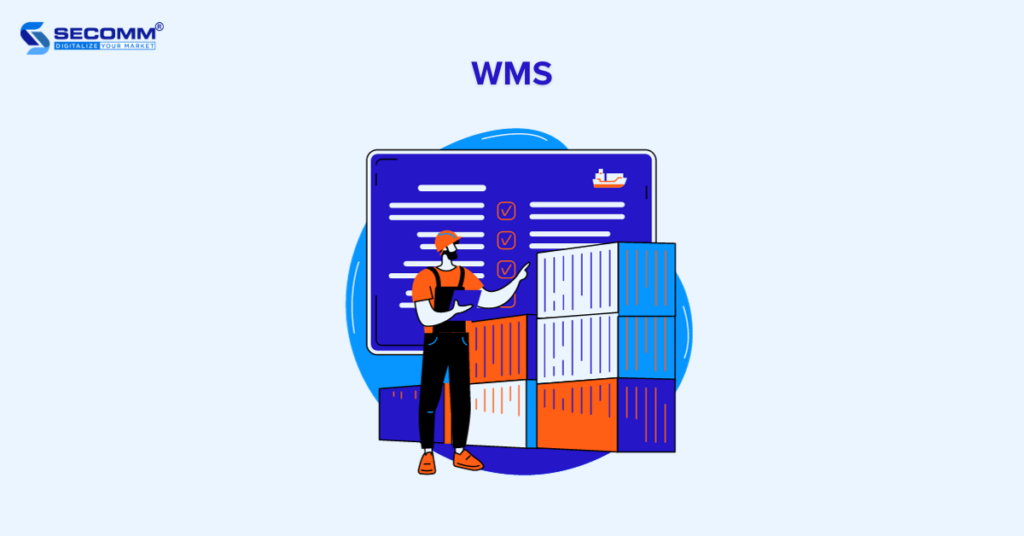
For example, Oracle Warehouse Management Cloud (WMS) is one of the eCommerce integrations that offers a cloud-based warehouse management system. It is well-suited if you’re looking for effective warehouse inventory management.
It automates warehouse processes such as receiving, storage, order processing, and shipping, particularly well-suited for a wide range of business scales. It also seamlessly integrates with ERP, CRM, and other supply chain solutions.
POS (Point of Sale) is a system that includes both hardware and software components, or it can be as straightforward as a point-of-sale device like a computer, tablet, smartphone, or receipt printer.
POS helps you manage and execute sales transactions, calculate payments, generate receipts, manage inventory, handle customer relations, and provide crucial sales-related information.

For instance, the Square POS system, developed by Square, has garnered the interest of numerous large businesses globally due to its free features. However, each transaction conducted through the POS incurs a fee of 2.6% and 10 cents for each tap, dip, or swipe.
For the “Buy Now Pay Later” model, the fee is 6% and 30 cents. Additionally, Square provides tailored POS packages for businesses with revenues surpassing $250,000.
Xem thêm:
CRM (Customer Relationship Management) helps you organize and manage customer information, including contact details, purchase history, and interactions. So, you’ll easily tap into customer needs and preferences, optimizing the shopping experience and increasing order conversion rates.
Moreover, CRM allows internal departments to interact and work on a unified and automated system, saving time and costs.
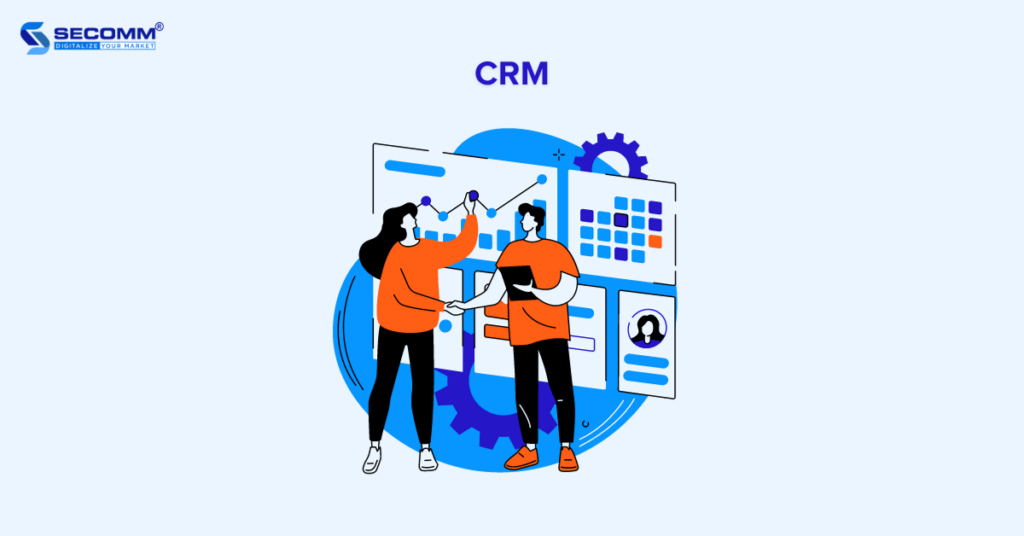
For example, Dynamics 365 Sales is one of the CRMs developed by Microsoft. With its intuitive interface, easy setup, and flexible customization capabilities, you can manage and enhance the efficiency of the sales process.
the system provides a “Real-time Insight” feature to deliver real-time insights from sales calls, such as customer emotions and sentiments. This helps businesses assess and strategize for their sales teams.
Currently, the system offers three plans:
Learn more:
Instead of relying on separate, isolated software systems lacking interdepartmental cohesion, ERP (Enterprise Resource Planning) integrates all software into a unified system.
The ERP eCommerce integration helps you manage all organizational activities, from inventory control and orders to financial planning and customer interactions.
You’ll maximize time efficiency, minimize costs, boost business productivity, and reduce unnecessary workforce.
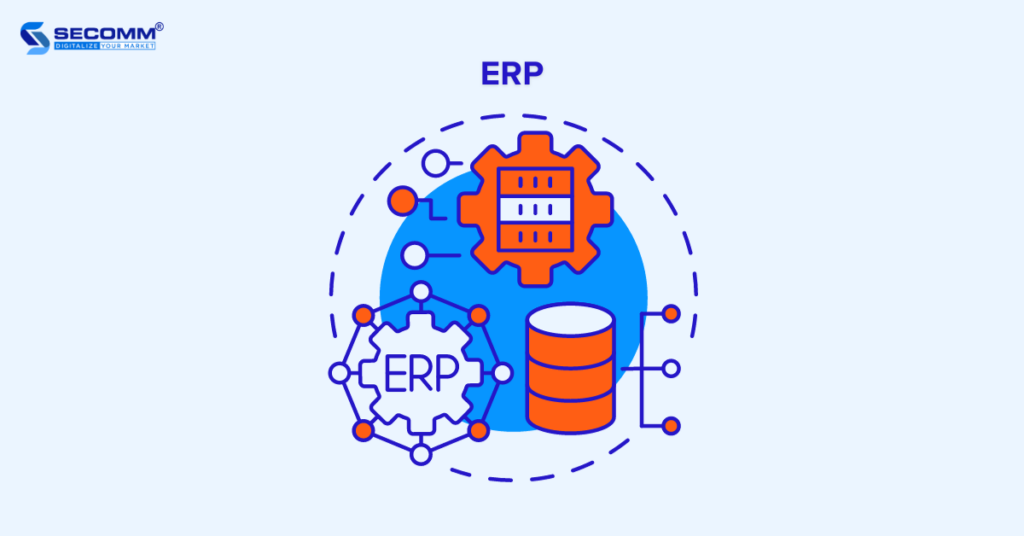
For example, Oracle ERP is one of the top global ERP software known for its outstanding features for operational efficiency.
Currently, Oracle provides three different plans tailored to specific needs:
Learn more: 6 best enterprise ERP software
Business Intelligence (BI) helps you analyze data from various sources such as eCommerce websites, POS systems, CRM, and other data sources. Plus, you’ll gain a deeper understanding of customer behavior, shopping trends, and factors influencing sales performance.
By using BI, you can also predict shopping trends to formulate specific strategies, while simultaneously monitoring financial performance, including forecasting sales figures, profits, and other financial indicators. This helps you allocate resources accurately.
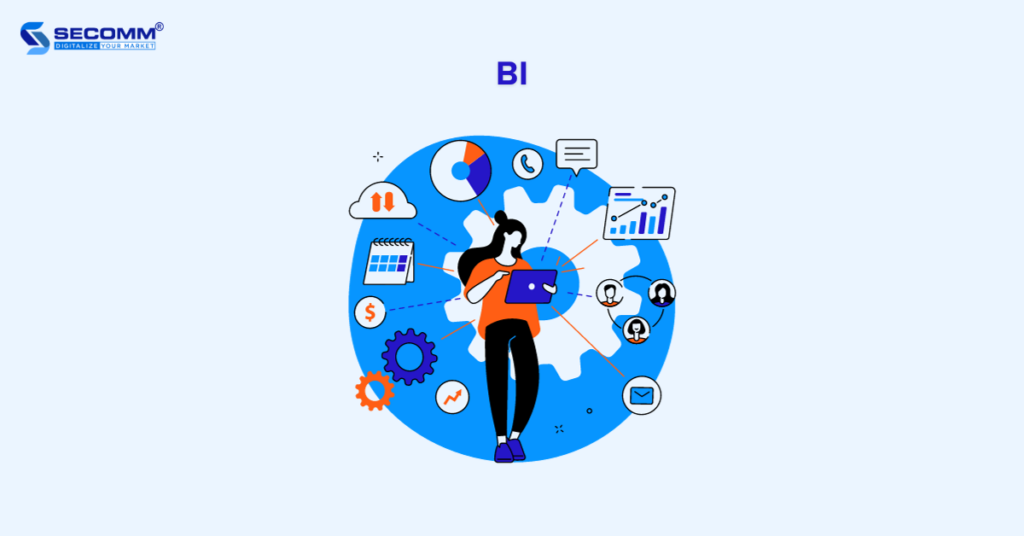
For example, Tableau is a widely used BI tool suitable for various individuals and organizations. With a user-friendly interface that requires minimal technical knowledge, Tableau allows users to easily create reports and visualize data.
The ability to connect and integrate data from various sources, including cloud data, and transform it into visually appealing charts and graphs, makes it easy for users to analyze trends and information
Deploy eCommerce integrations today!
Above are 7 popular eCommerce integrations to build your eCommerce website and enhance your online presence. You’ll choose your best-suited systems depending on the strategy, estimated budget, and business direction.
With profound knowledge of the eCommerce industry and experience in deploying integrations for all sizes of businesses, SECOMM is committed to proposing cost-effective solutions to develop your high-performing eCommerce system.
Contact or call directly on the SECOMM hotline (02871089908) to get started today!
 2
2
 3,551
3,551
 0
0
 1
1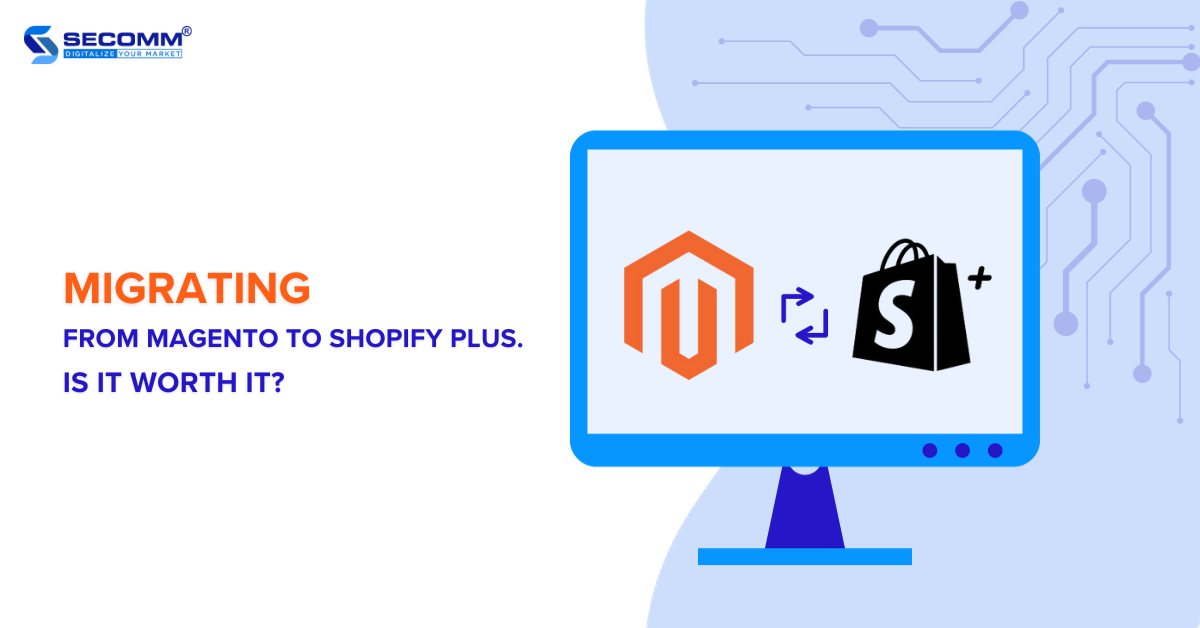
Migrating from Magento to Shopify Plus is a strategic decision that many businesses are considering. While Magento holds a prominent position in the eCommerce market, the ongoing trend of switching to Shopify Plus has raised questions about its reasons, prompting a comparison between the two platforms. Join us in exploring these aspects in this article.
Learn more: Adobe Commerce vs Shopify Plus
Magento is an open-source eCommerce platform with over 140,000 active websites and was acquired by Adobe in 2018. It offers many advanced features, allowing you to tailor your eCommerce websites.
It has two versions: Magento Open Source, a free option to download and install on your servers, and Adobe Commerce (formerly Magento Enterprise), a paid version with premium features such as Adobe’s hosting and security services.
Shopify Plus stands out as Shopify’s advanced SaaS eCommerce platform tailored for large and rapidly growing enterprises. With high scalability, it can handle surges in traffic and sales volumes reaching billions of dollars.
By leveraging Shopify Plus, you can benefit from a robust infrastructure that facilitates easy customization and centralized management of multiple stores, brands, languages, and currencies through a dashboard.
Also, the platform offers a range of superior solutions to enhance eCommerce operations, including Shop Pay, Shopify Flow, LaunchPad, Shopify Scripts, and more.
Many businesses opt to move away from the Magento platform in pursuit of a more optimal solution for their eCommerce websites. However, the following two reasons are widely regarded as the most prevalent.
After launching the Magento 2 (M2) version, the company has declared they’ll no longer support the Magento 1 (M1) version. This means that if you’re using the older version, you won’t receive security updates, bug fixes, and technical assistance.
So, the platform encourages their customers to upgrade to M2 to ensure continued technical support, enhanced security, and access to a variety of new and advanced features.
However, the upgrade process is complex, requiring significant investment in terms of cost and time for source code and interface customization. It may force you to halt your eCommerce operations.
In case you want to keep operating M1 alongside the update process, there’s a potential risk of disrupting system operations, causing significant disruptions to the customer experience, and ultimately affecting sales.
Moreover, there’s also a potential risk of compatibility issues, as some features and modules initially built on M1 may require significant customization to operate effectively on M2.
Faced with these risks, some businesses opt not to upgrade but rather switch to an alternative eCommerce platform. Frequently, these businesses turn to SaaS platforms that offer robust technical support and readily available solutions.
Learn more: M1 vs M2
Some businesses that have upgraded and used M2 for a while have realized that it may not be the best choice. Developing and maintaining a M2 website requires high technical expertise, especially if you want to integrate and customize specific features.
If you don’t have a sufficiently professional technical team or inefficiently collaborate with deployment partners, the customization process is even more complex.
Plus, while the open-source platform offers high scalability, it lacks flexibility. So, if you don’t set up and build your system properly, it may get issues during peak shopping times, leading to crashes and interruptions.
This, in turn, customers to be unable to access the website for purchases, causing significant harm to your brand.
Learn more: The costs of building a Magento eCommerce website
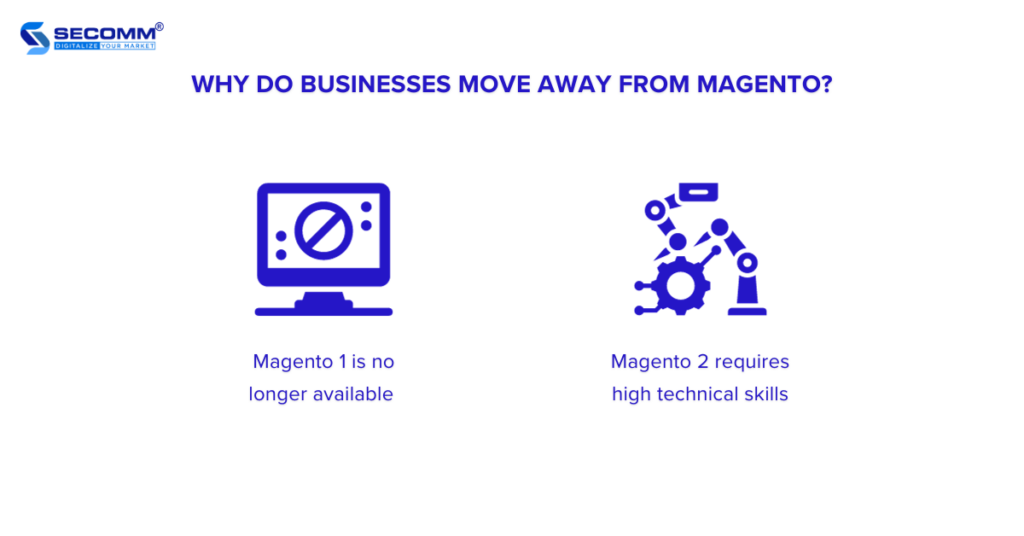
Learn more: 15 reasons why you should migrate to Shopify Plus
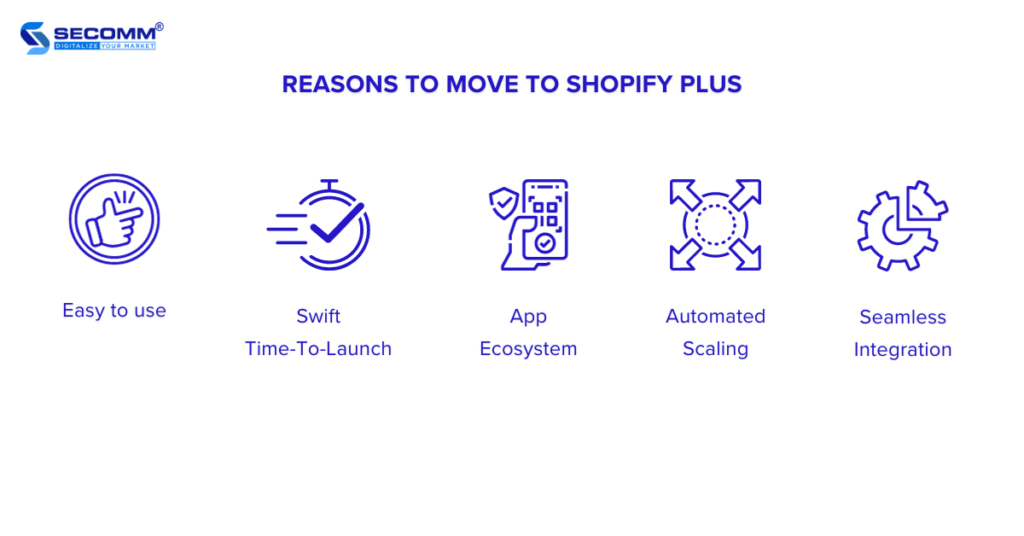
Below are some brands that have previously embraced eCommerce using Magento and switched to Shopify Plus to reduce technical complexities and costs.
Gymshark, a UK-based brand specializing in sportswear and fitness fashion, has emerged as a prominent and favored global sportswear brand since its inception in 2012.
Facing a website crash during the bustling Black Friday shopping season, Gymshark, previously on Magento, made the strategic decision to switch to Shopify Plus.
Despite time and financial investments in repairing and maintaining the system, there was no guarantee of long-term effectiveness.
Upon switching to Shopify Plus, Gymshark capitalized on available solutions such as Shopify POS to elevate both online and offline shopping experiences. The implementation of Shopify Scripts, an exclusive tool for the ‘Plus’ merchants, allowed them to customize and optimize the checkout process.
By using this advanced SaaS platform, Gymshark significantly boosted conversion rates and sales, particularly during major year-end shopping events. This success has firmly established Gymshark as one of the fastest-growing brands globally.

Founded in the United States in 2013, Bombas is a brand specializing in the manufacturing and retail of socks. Renowned for its “buy one, donate one” approach, Bombas pledges to donate a pair of socks to those in need for every pair sold.
Bombas faced website crashes on its previous Magento platform, occurring during Shark Tank program airings and major shopping events like Black Friday and Cyber Monday. These disruptions led to substantial financial losses and incurred significant fees for system repairs over an extended period.
To capitalize on the seamless scalability offered by Shopify Plus, Bombas moved away from the previous. The Bombas website remained resilient during significant year-end shopping events.
The brand not only recouped its investment quickly but also witnessed a remarkable 300% surge in sales compared to the same period the previous year.

Jack Rogers, an iconic American brand specializing in footwear and fashion accessories, has enjoyed widespread recognition globally for an extended period. The brand is not only distinguished for its use of the highest-quality materials in crafting sophisticated and luxurious footwear but also for its global prestige.
After running on the Magento platform for a while, Jack Roger’s eCommerce website started experiencing issues. Each minor update incurred significant time and costs, leading to the decision to switch to Shopify Plus. This move aimed to find a cost-effective solution for operations and maintain the overall stability of the system.
Jack Rogers implemented Shopify Flow to automate both operational and sales processes. The brand also integrated various third-party applications such as Smile, Gorgias, and more to augment the eCommerce efficiency.
Learn more:

Below are some notes to consider during the platform migration process.
There are several methods to migrate data to the Shopify Plus system, such as automated migration, manual migration, and data import/export. You can choose one of these methods or deploy all of them to streamline the migration process and enhance data accuracy.
Customer data
Product data
Transaction data
Switching an eCommerce platform in general and specifically migrating from Magento to Shopify Plus is a complex process that demands detailed planning, precision, and an investment in both budget and time, along with technical expertise.
Therefore, solution architects need to strategize to redesign the system, encompassing system architecture, infrastructure, technology, performance monitoring tools, etc.
When deciding to switch to Shopify Plus, there are some things related to website optimization you need to keep in mind. The URL structure of the two platforms differ, so you should check the navigation of all web pages to ensure the preservation of SEO value and user redirection to the correct pages.
During the platform migration process, a temporary decrease in rankings on search engines like Google or Bing is normal and not a cause for concern. These search engines may take a few days to process the new website and update essential indices.
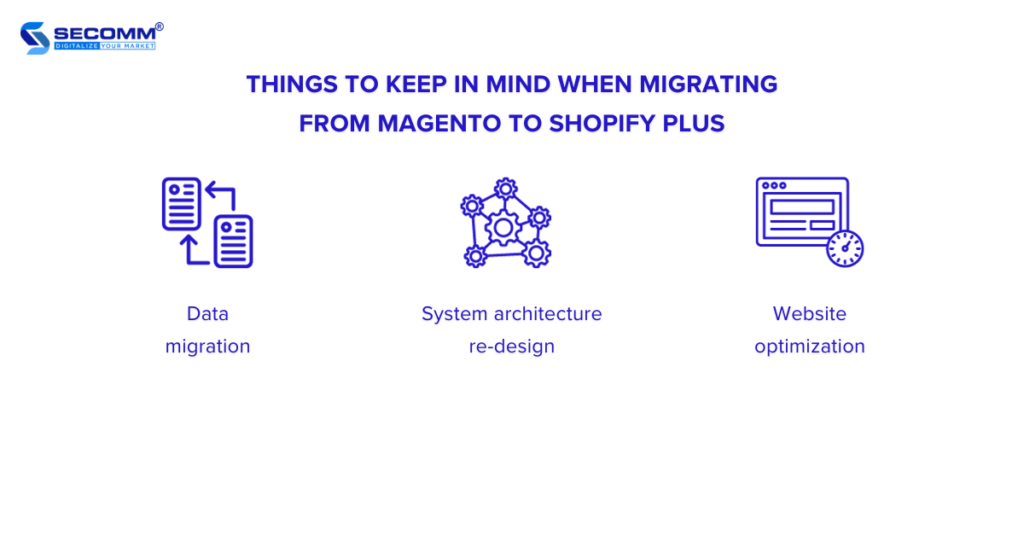
Lately, Shopify Plus has emerged as the preferred choice for businesses making the move from the Magento world.
Having extensive experience in developing eCommerce websites on both eCommerce platforms, and successfully executing the Shopify Plus migrations, SECOMM has become a reliable technology partner for many large enterprises such as Vinamilk and Suzuverse.
Contact SECOMM or call directly at the hotline (028 7108 9908) to start the project of the Magento to Shopify Plus platform migration process tailored to your business.
 2
2
 4,692
4,692
 0
0
 1
1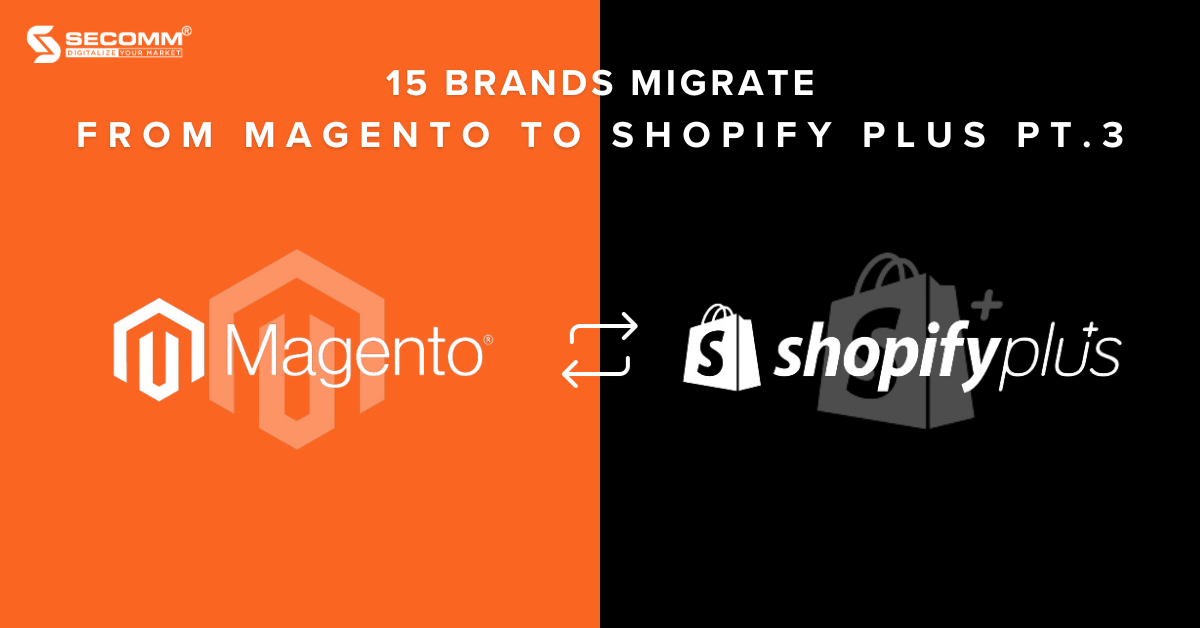
Building upon the narratives in parts 1 and 2, this third part invites you to delve into the stories of the remaining brands within the series of 15 that migrate from Magento to Shopify Plus. Explore how this strategic decision has led to their success in terms of sales and paved the way for sustainable growth in the future.
Learn more:
Beard & Blade is a wholesale business specializing in providing products for hair styling, beard care, and beauty and skincare for men. The brand is known for offering high-quality products tailored for men who aim to maintain their appearance and well-being.
Beard & Blade’s wholesale website was initially built and developed on the Magento eCommerce platform. However, according to the Beard & Blade team, operating the wholesale system on this platform proved to be challenging and required numerous manual tasks.
This resulted in time loss, and the overall cost for their wholesale system to operate on Magento was a considerable amount. Therefore, the brand decided to revamp its platform with Shopify Plus.
After considerable efforts, Beard & Blade’s Shopify Plus wholesale website for men’s products was officially launched.
By utilizing Shopify Plus’s dedicated solutions for wholesalers, Beard & Blade was able to automate inventory management, customize product pricing, and set discount levels based on the quantity of products ordered.
In contrast to the previous operational experience on Magento, wholesale orders on Shopify Plus are processed consistently, without interruptions, and without requiring manual tasks, thus avoiding disruptions to the customer experience.
Since the launch of the new website on Shopify Plus, Beard & Blade’s wholesale revenue has increased by 100%, and the average order value (AOV) for wholesale is five times higher than the retail AOV.

Milligram is a fashion and stationery brand headquartered in Melbourne, Australia. The brand primarily focuses on producing and providing stationery products, including notebooks, pens, and bags made from premium materials with unique designs.
Initially, Milligram built its eCommerce website on the Shopify platform, and later, in pursuit of brand growth, switched to using the Magento platform. After a while, as Milligram expanded its scale with more offline stores, the Magento website system started to operate slowly, and the backend database was overloaded.
Errors and delays occurred during updates, causing disruptions beyond the normal timeframe. Therefore, Milligram returned to Shopify, but this time opting for the advanced version – Shopify Plus.
Leveraging the available solutions of Shopify Plus, Milligram built and customized advanced features, such as an enhanced search function, to provide an optimal shopping experience for customers.
The platform transition from Magento to Shopify Plus was swift and smooth. Milligram easily executes promotional campaigns, uploads products without requiring technical skills, and finds managing and operating the Shopify Plus system more straightforward compared to Magento.
This allows Milligram to focus wholeheartedly on sales, marketing, and enhancing customer relationships.

Eden Park is a prestigious fashion brand originating from France, renowned for its high-end sportswear and fashion products. The brand specializes in providing premium sports and fashion items, with their collections often combining a blend of comfortable and luxurious styles.
In 2021, Eden Park turned its attention to Shopify when contemplating entry into the U.S. market. Moreover, at that time, Eden Park’s eCommerce website faced numerous operational issues.
Bastien Borget, the eCommerce Director of Eden Park, admitted that the business spent approximately 80% of its time operating the Magento website, yet the system consistently experienced errors, and the maintenance incurred substantial costs.
During Black Friday, the Magento website crashed due to overload from a sudden surge in traffic. At that point, Eden Park decided to revamp its platform with Shopify Plus, utilizing solutions within the Shopify ecosystem such as Shopify Payment and Shopify Flow.
Additionally, the superior integration capabilities of Shopify Plus allowed Eden Park to seamlessly integrate with third-party applications like Klaviyo, Gorgias, and Babak.
Eden Park’s Shopify Plus eCommerce website took less than 2 months to launch. One year after the introduction of the new website, Eden Park’s revenue increased by 30%, and the conversion rate rose by 48%.
The solutions provided by Shopify Plus alleviated the operational burden for Eden Park, allowing the business to allocate more time to marketing and sales rather than website maintenance, contributing to impressive business results.

Jack Rogers is a renowned footwear and fashion accessories brand headquartered in New York, USA. The brand is known for producing stylish sandals with traditional designs and premium materials, making Jack Rogers an icon of aristocratic fashion.
For a prominent fashion brand like Jack Rogers, utilizing a website as a potential sales channel remains crucial. However, the Jack Rogers website operating on the Magento platform began experiencing errors after a certain period.
Tasks such as repairs, changes, system operations, or running marketing campaigns consumed a significant amount of time for the technical team, leading to higher costs for Jack Rogers.
Moreover, inventory management posed challenges, with overselling issues occurring, and inaccuracies in the system’s quantity calculations resulting in revenue loss and a suboptimal customer experience.
Therefore, the Jack Rogers team sought to simplify their system, implement automation processes, and reduce technical burdens to focus on more critical business tasks.
The migration from the Magento platform to Shopify Plus helped Jack Rogers address these challenges. The new Jack Rogers website leveraged Shopify Flow solutions to automate operational, marketing, and sales processes, saving considerable time and labor compared to the manual processes of the previous Magento website.
Jack Rogers also utilized Shopify Plus Certified App applications to enhance the customer experience, including Returnly, Smile, Gorgias, and others.
During the Covid-19 social distancing period, Jack Rogers’ Shopify Plus website became the primary sales channel for the brand, experiencing a 60% increase in website traffic and a 30% increase in conversion rates.

Skin Inc is a skincare brand based in Singapore, specializing in providing personalized skincare products based on scientific principles and advanced technology. The brand is renowned for creating diverse and high-quality skincare products, particularly serums and unique skincare items.
With pride in their personalized products, Skin Inc also aimed to build an optimal online shopping experience with a high degree of personalization for customers. However, the business lacked the tools to achieve this.
Each time the technical team made a few changes, the website system immediately slowed down, lagged, and sometimes even had to temporarily suspend operations, causing disruptions to customer shopping.
This issue occurred frequently, especially during major year-end shopping seasons, resulting in substantial losses for Skin Inc, amounting to thousands of dollars.
Therefore, Skin Inc needed an alternative eCommerce solution that could be easily customized to deliver the best customer experience. Skin Inc transitioned from Magento to Shopify Plus and swiftly found solutions to enhance the customer experience.
With multi-store management features, Skin Inc could create multiple versions of eCommerce websites to tailor the experience for different customer segments in various markets.
In addition, Skin Inc implemented Shopify Flow and LaunchPad solutions to automate operational and sales processes. The seamless integration capabilities of Shopify Plus enabled Skin Inc to easily integrate with third-party applications to enhance marketing campaigns and customer loyalty programs.
As a result, this renowned beauty brand was able to reduce operational time by 50% and increase conversion rates by 200%.

So, SECOMM has gathered insights from 15 representative brands that courageously stepped out of the “Magento world” to revamp their eCommerce websites with Shopify Plus. These brands prioritize customer experience and streamlined processes, inspiring others to confidently opt for platform migration.
Contact SECOMM or call directly at (+84)28 7108 9908 for advice and implementation of the eCommerce migration process from Magento to Shopify Plus today!
 25
25
 4,514
4,514
 0
0
 1
1Subscribe to get the latest eBook!
Hotline